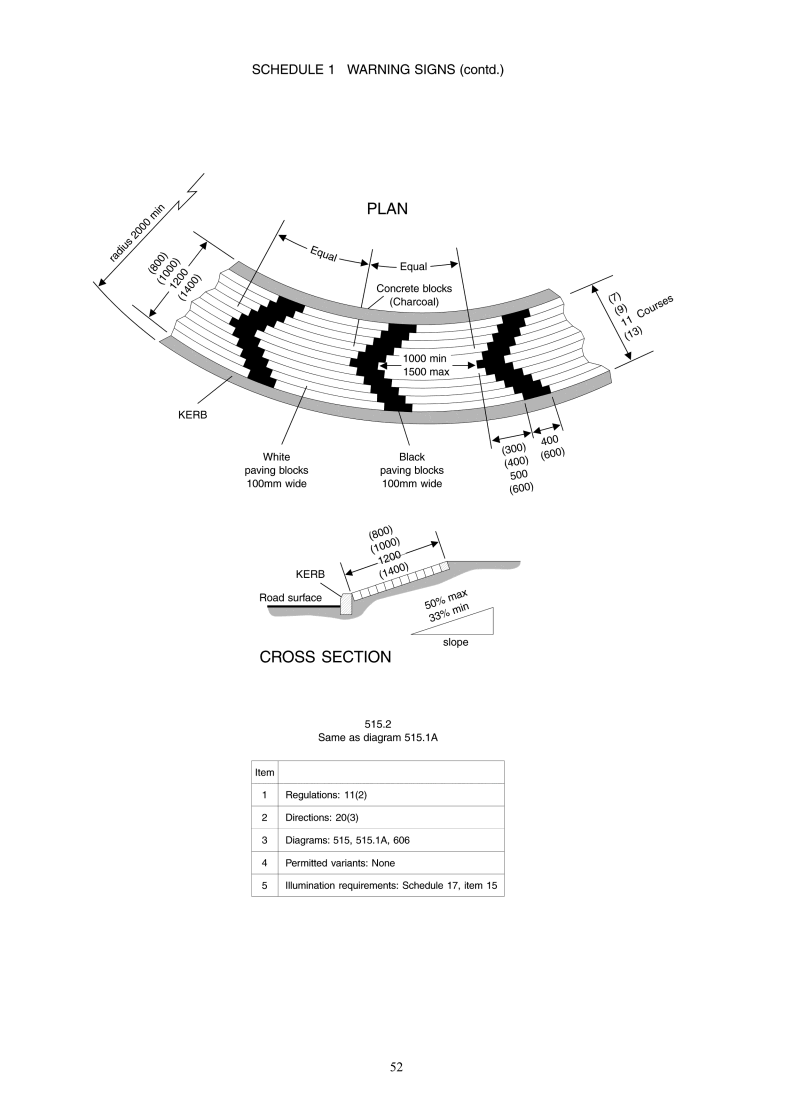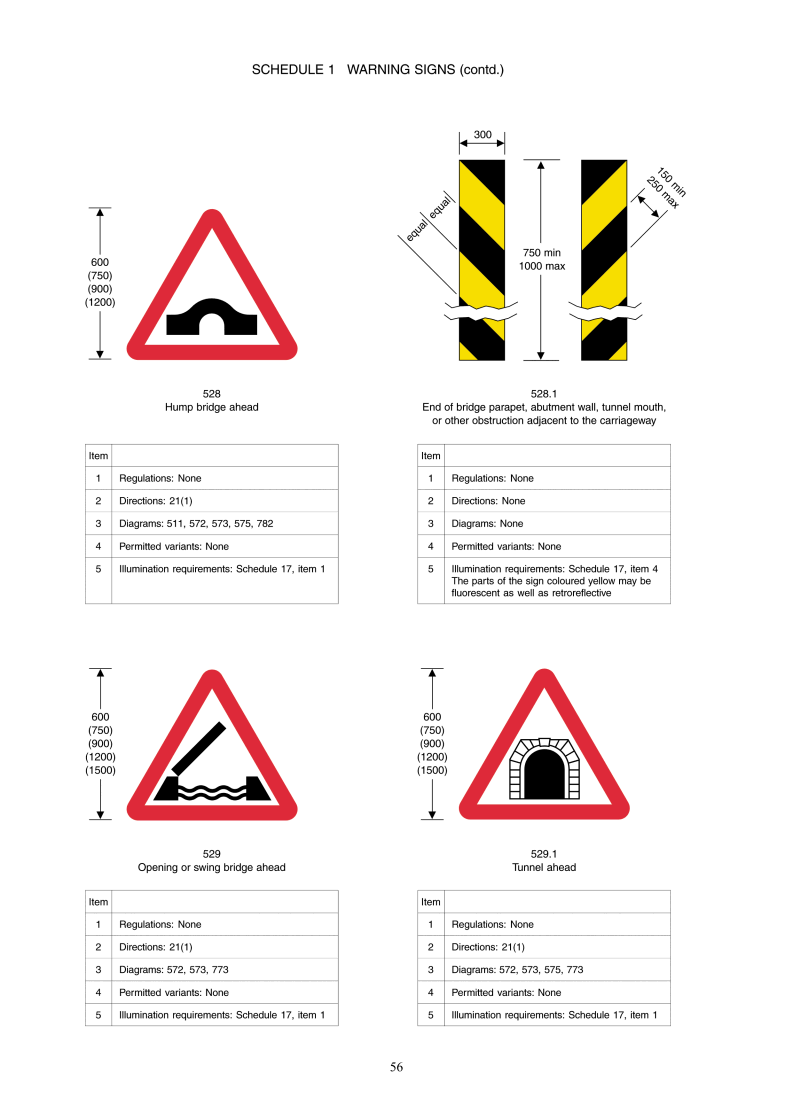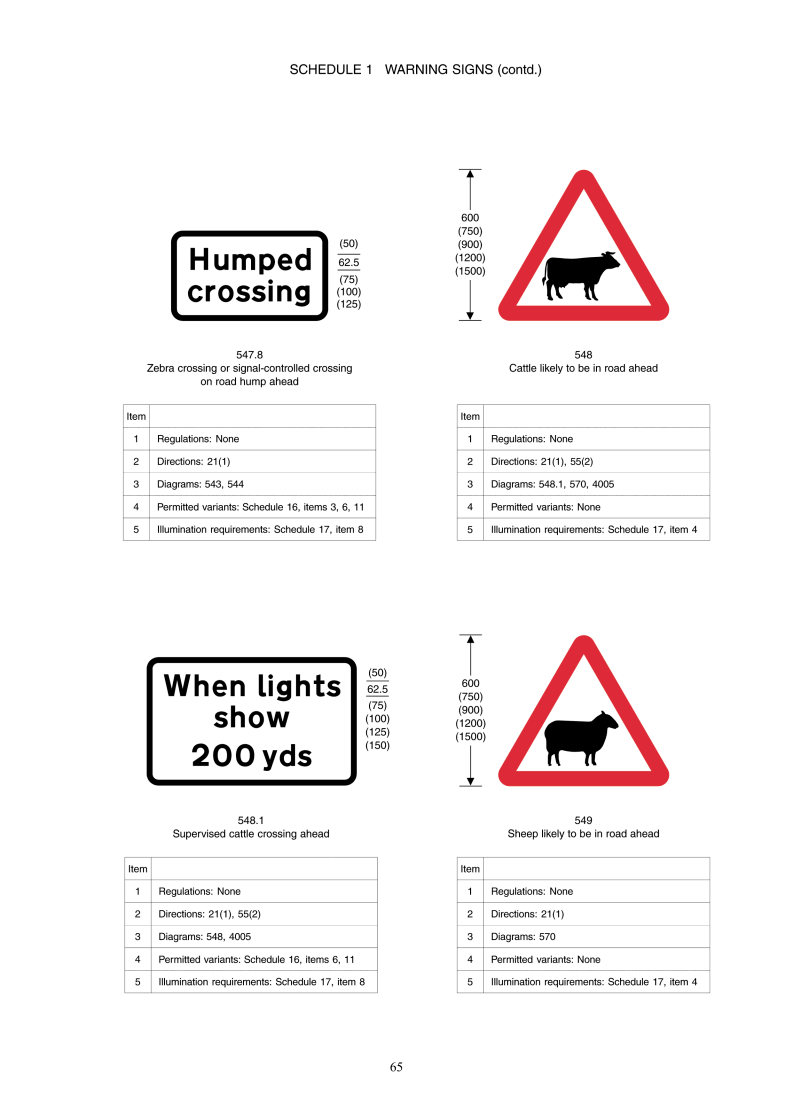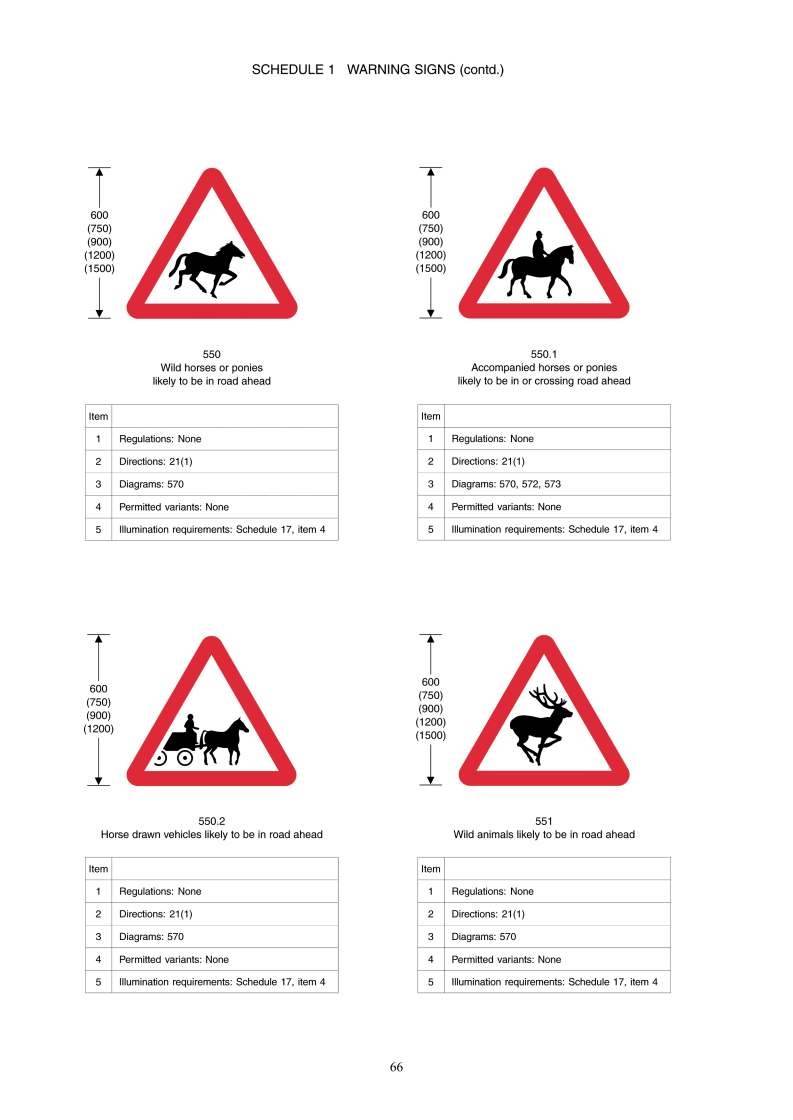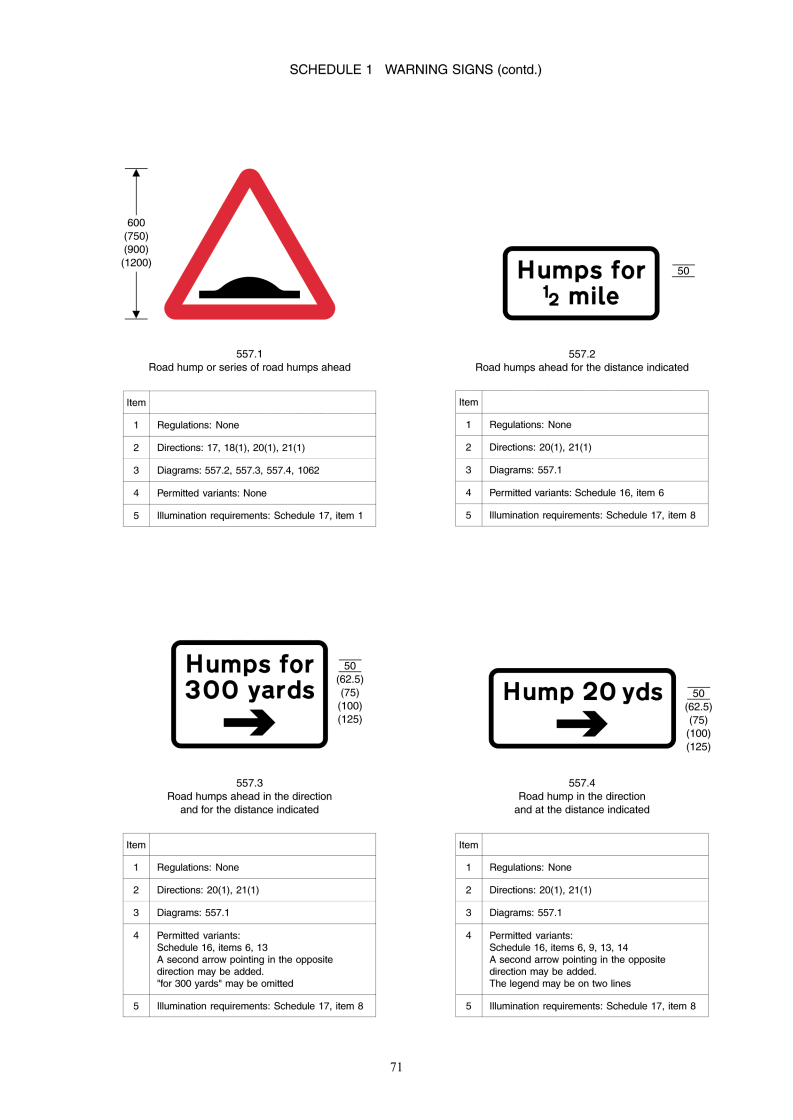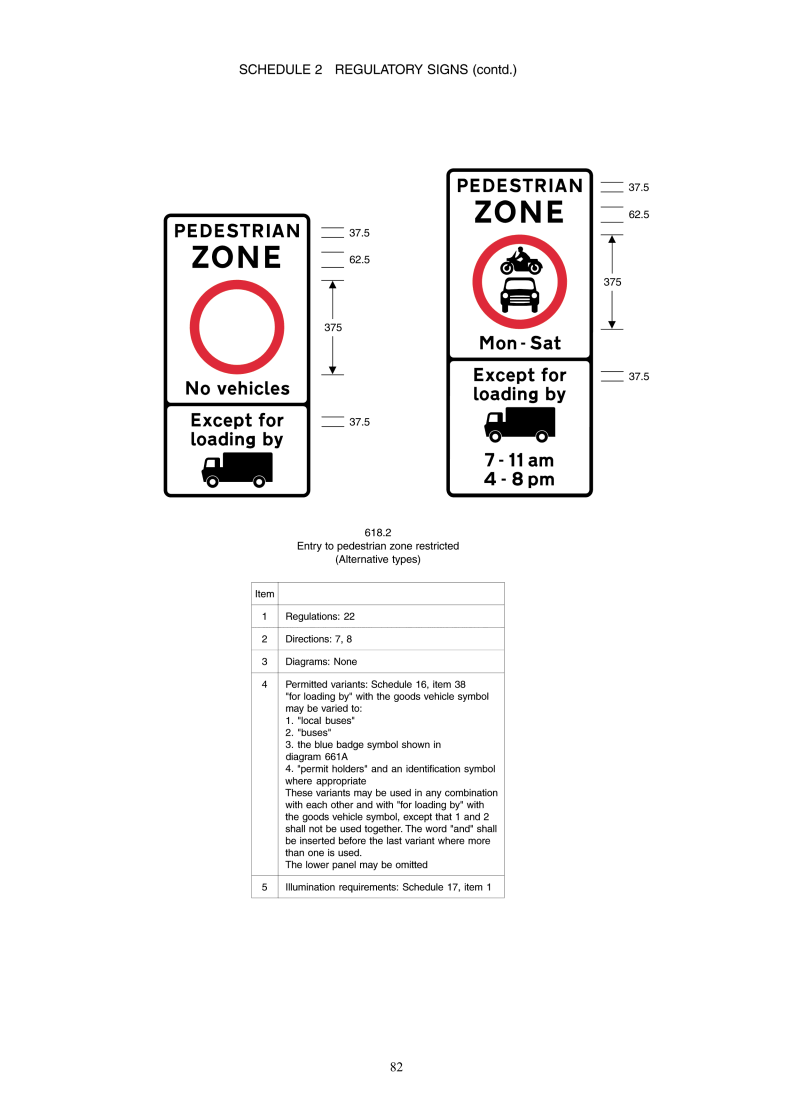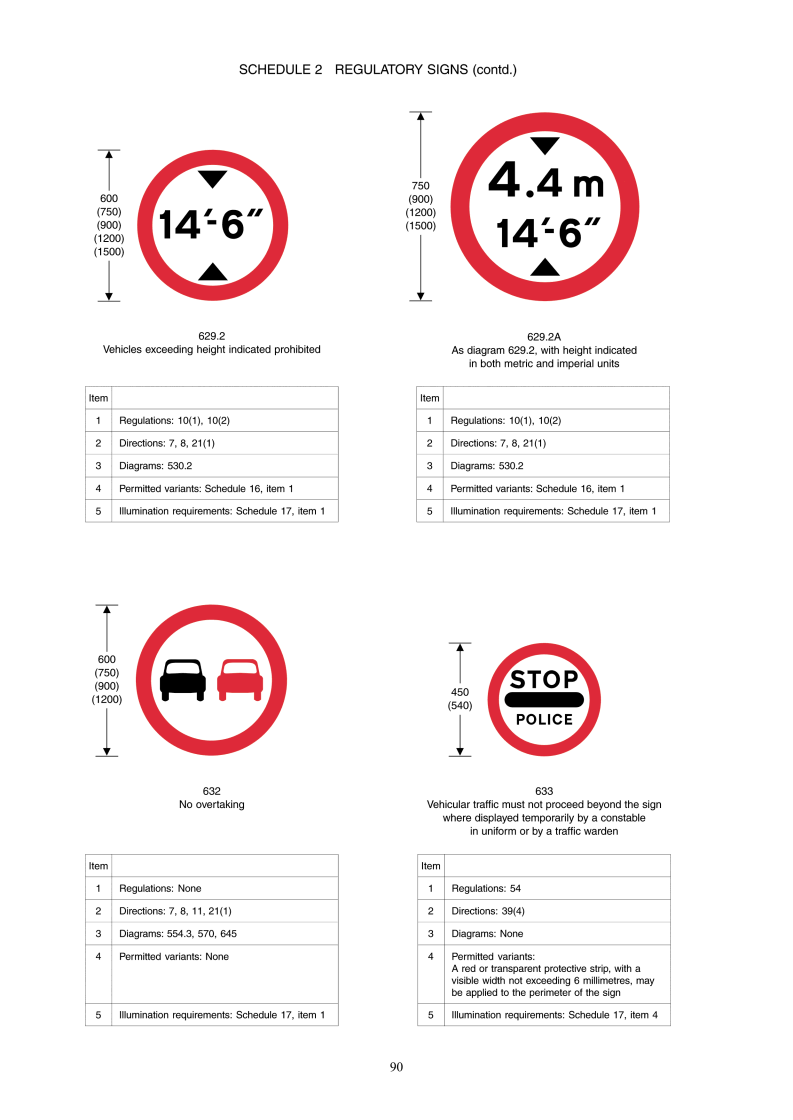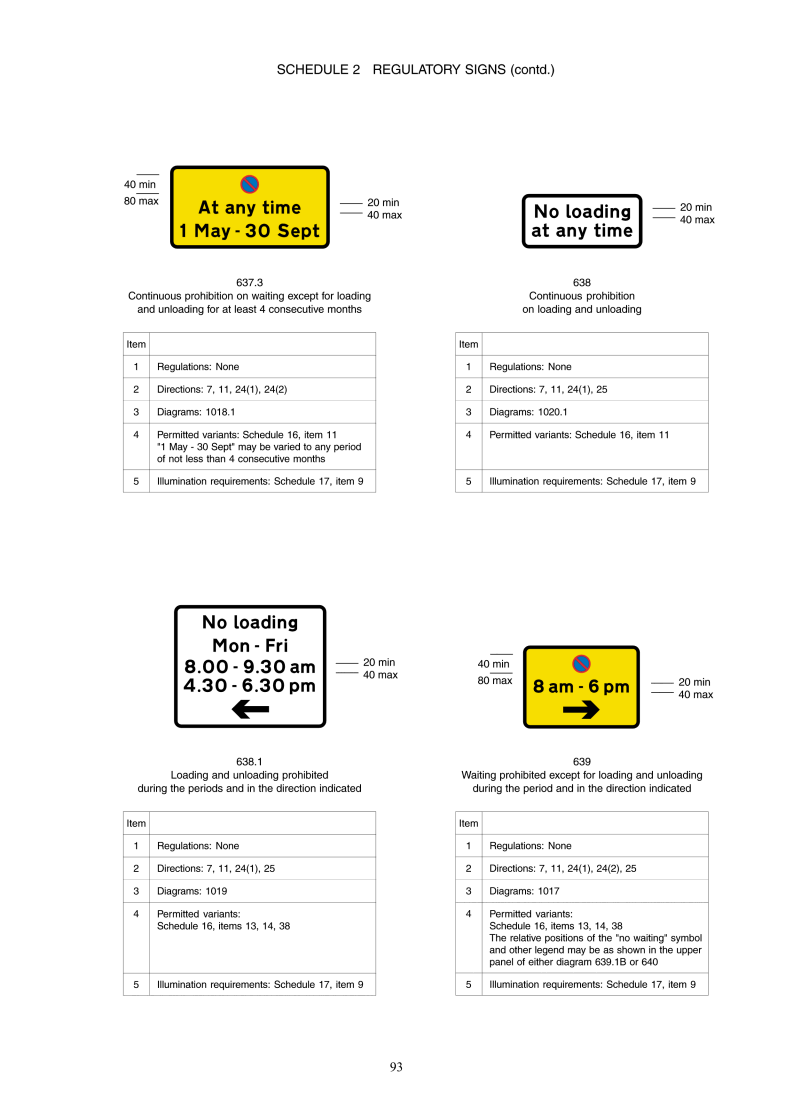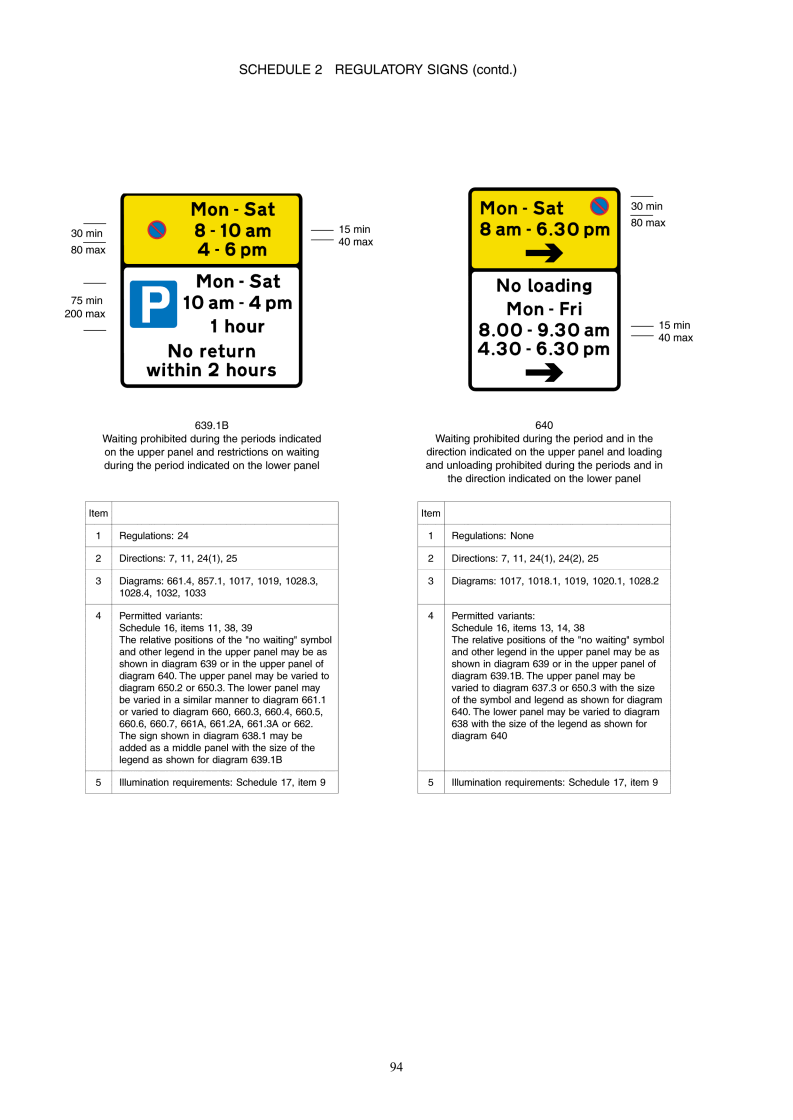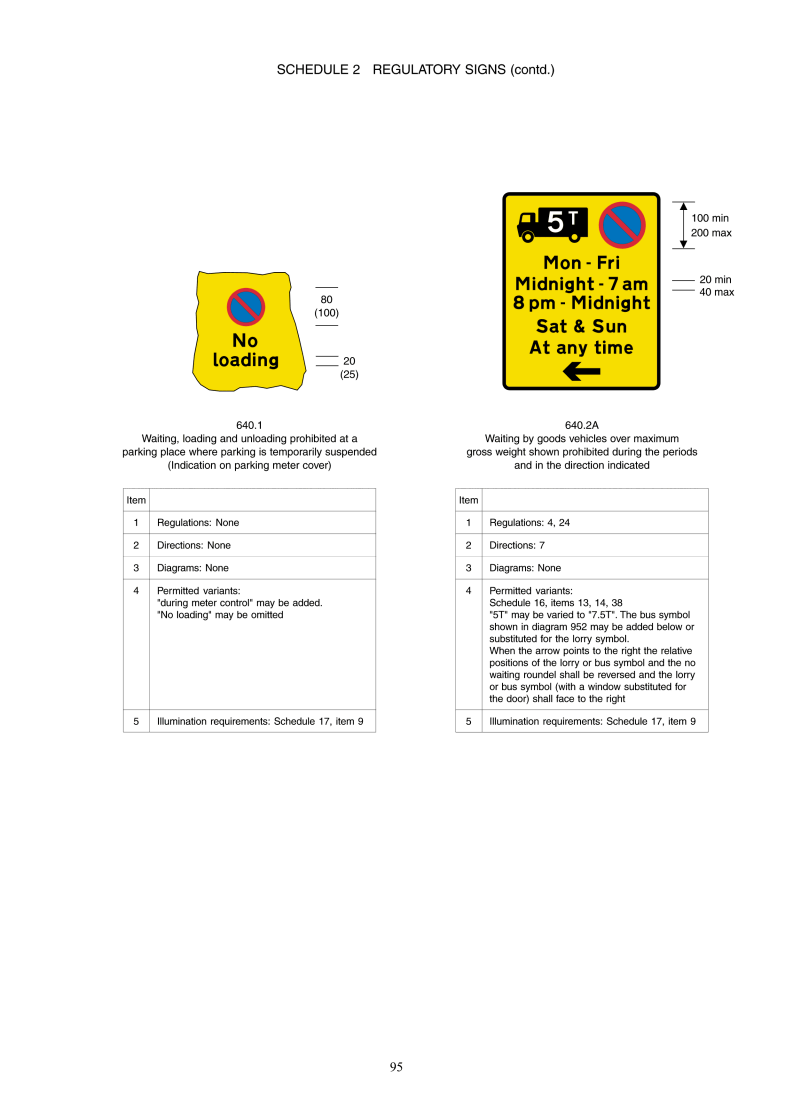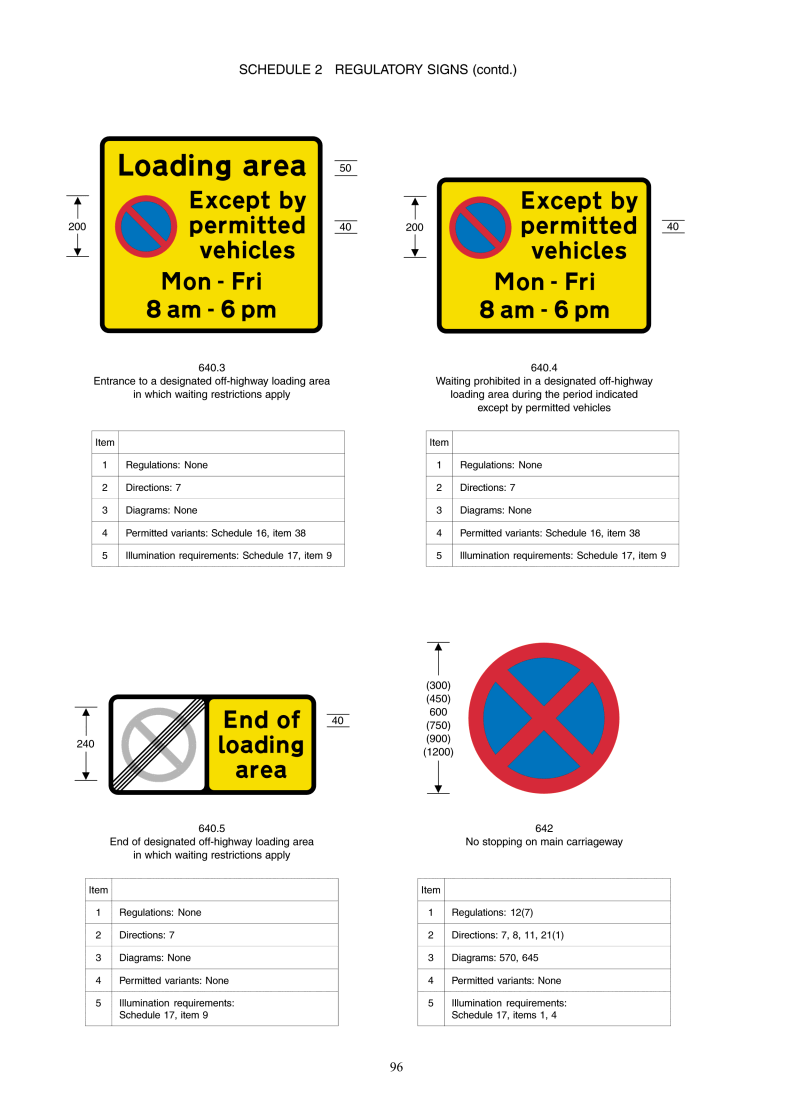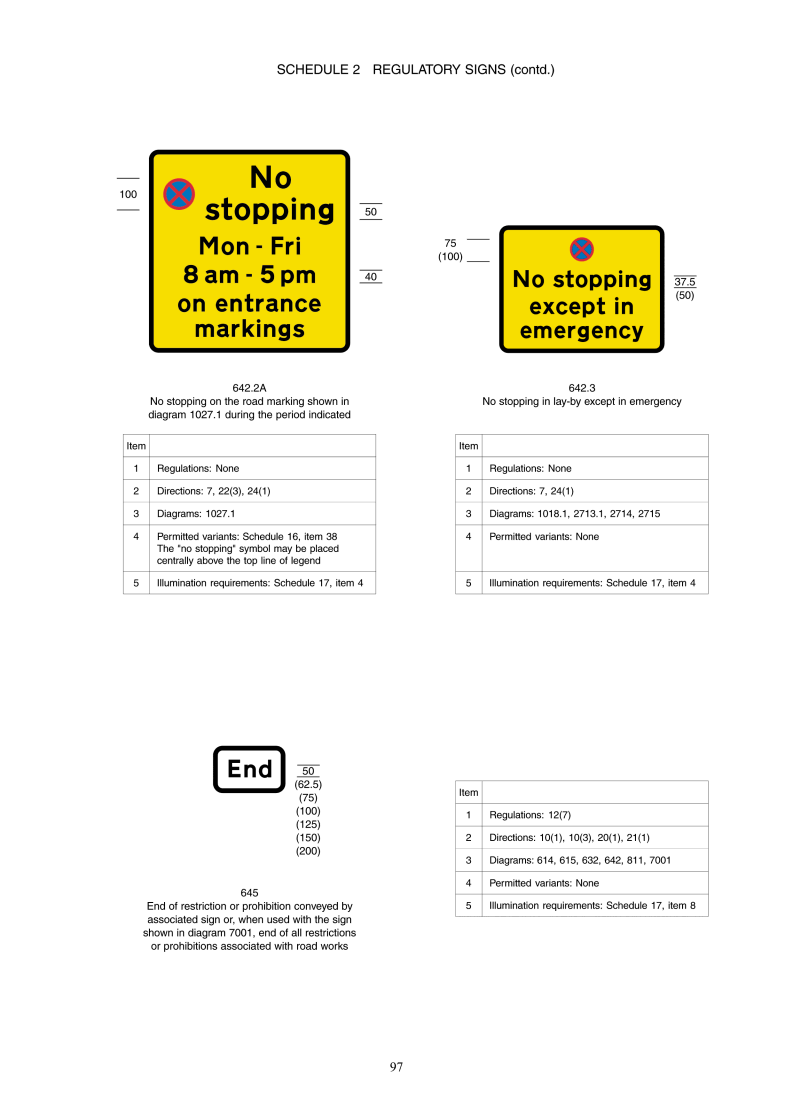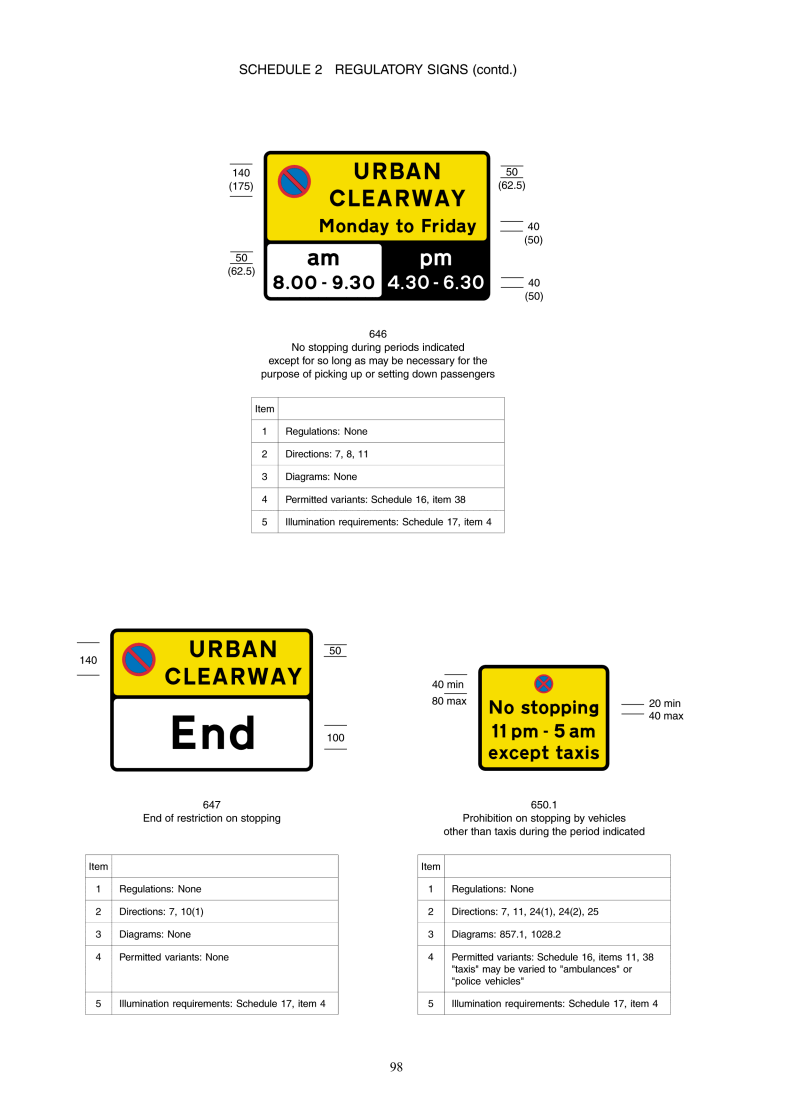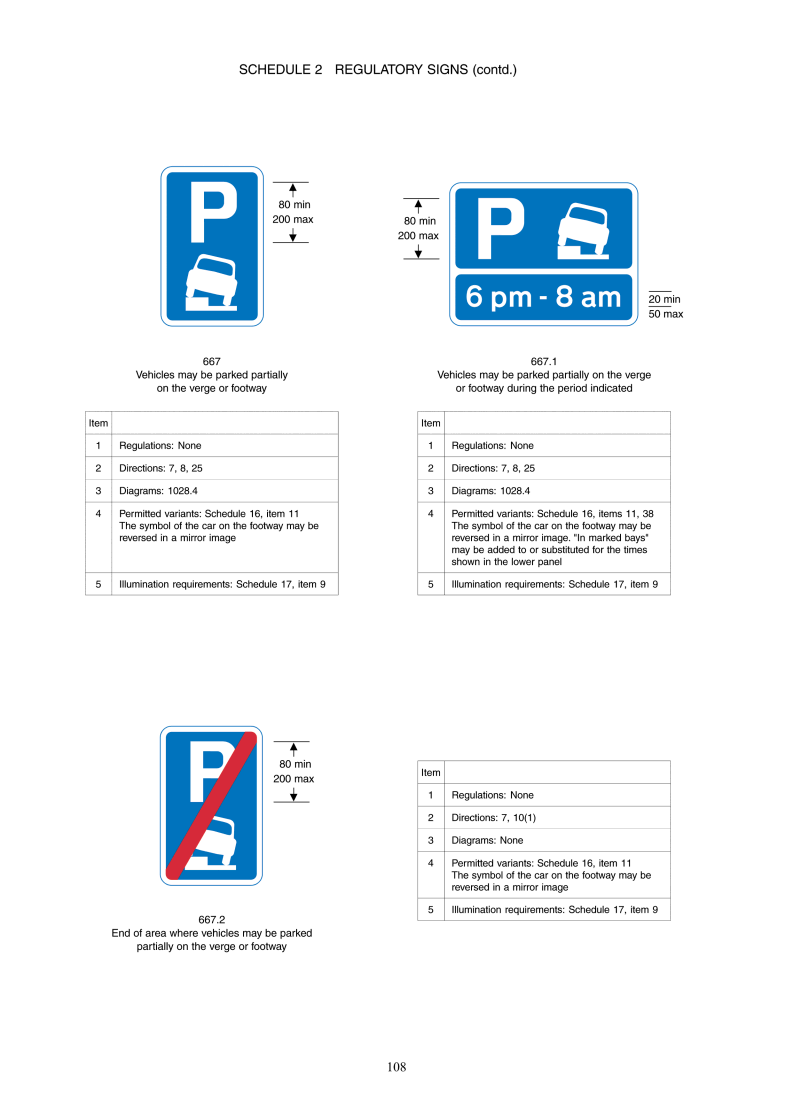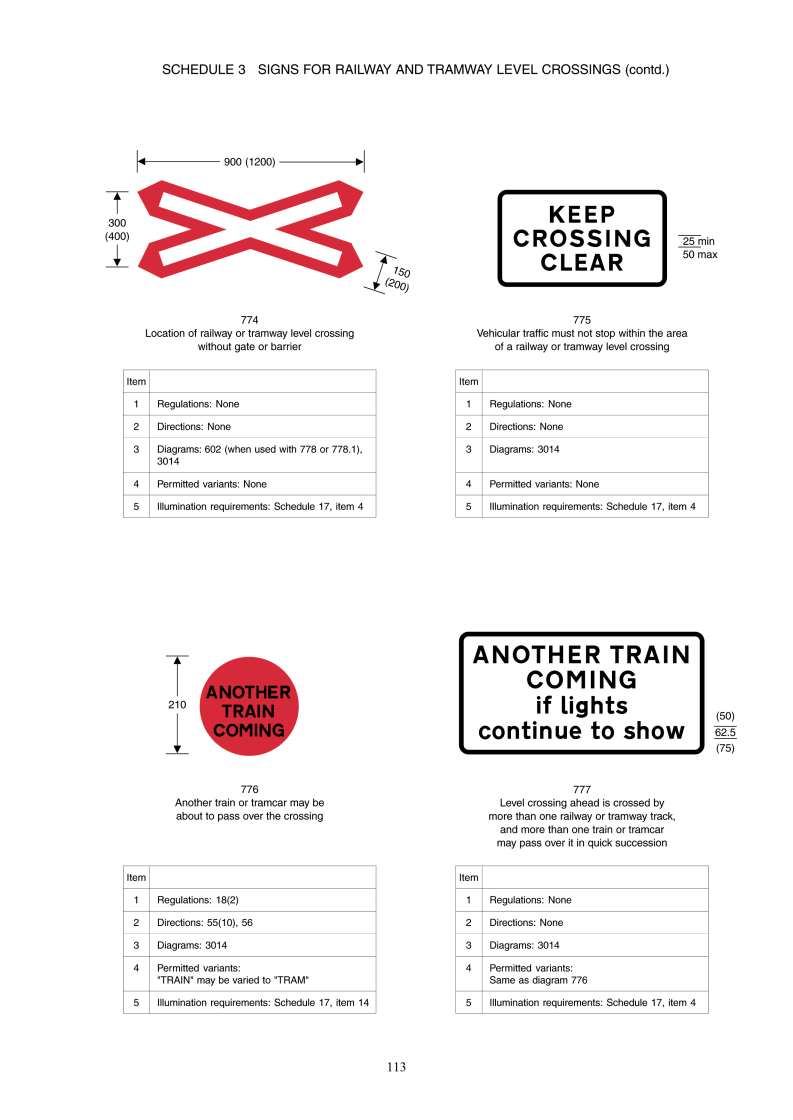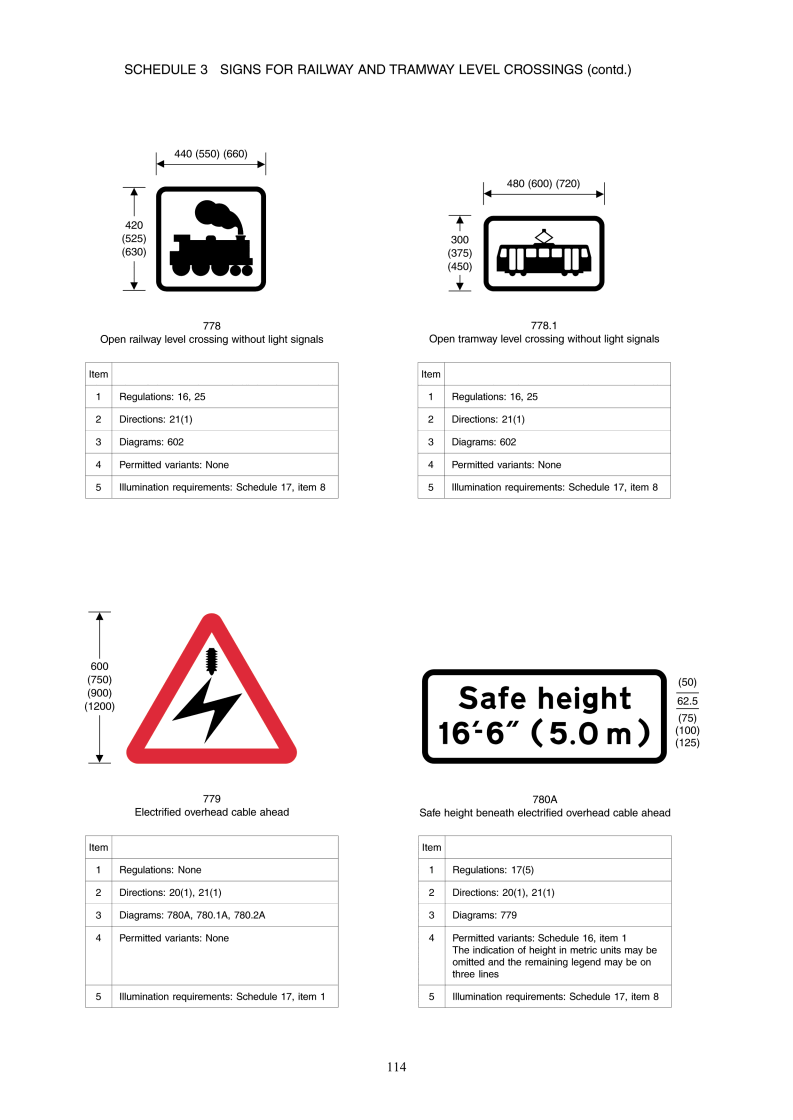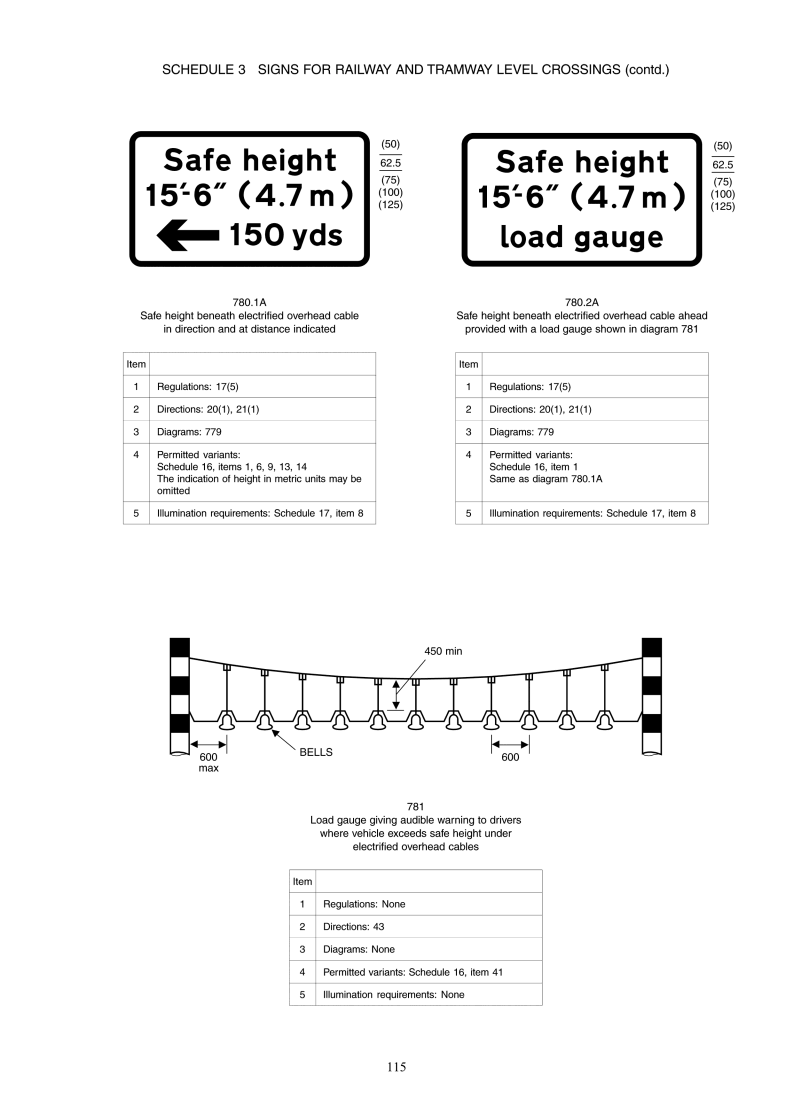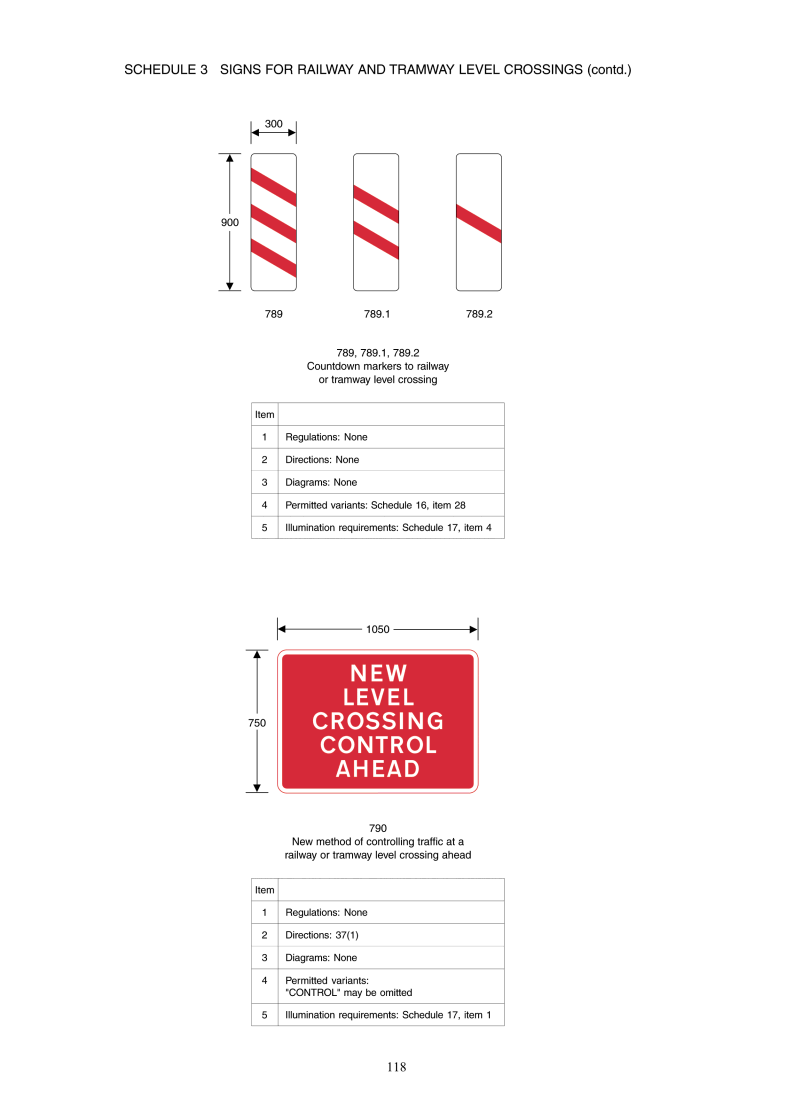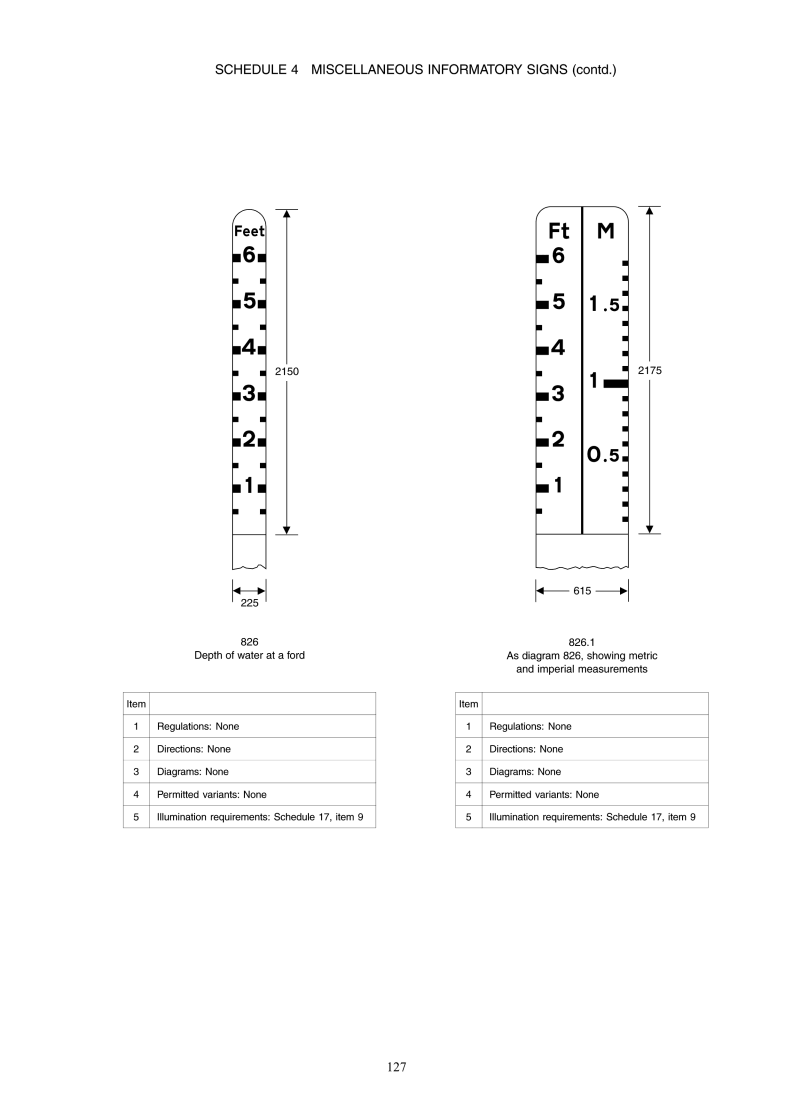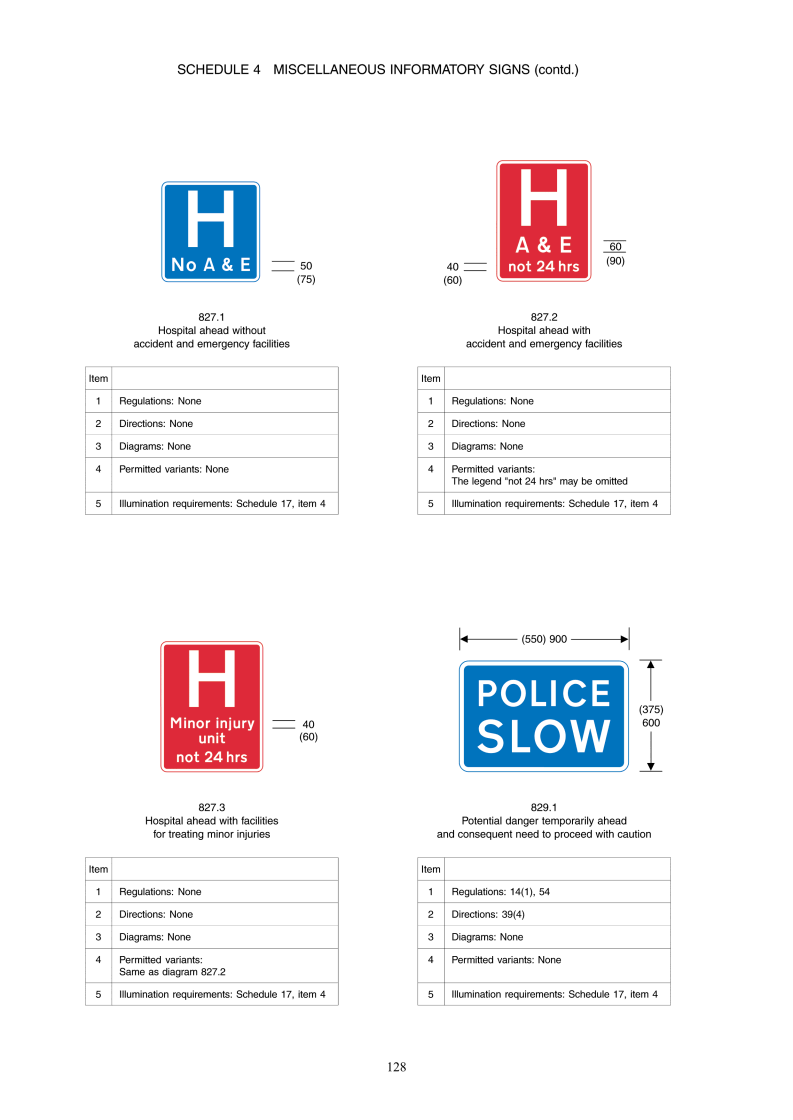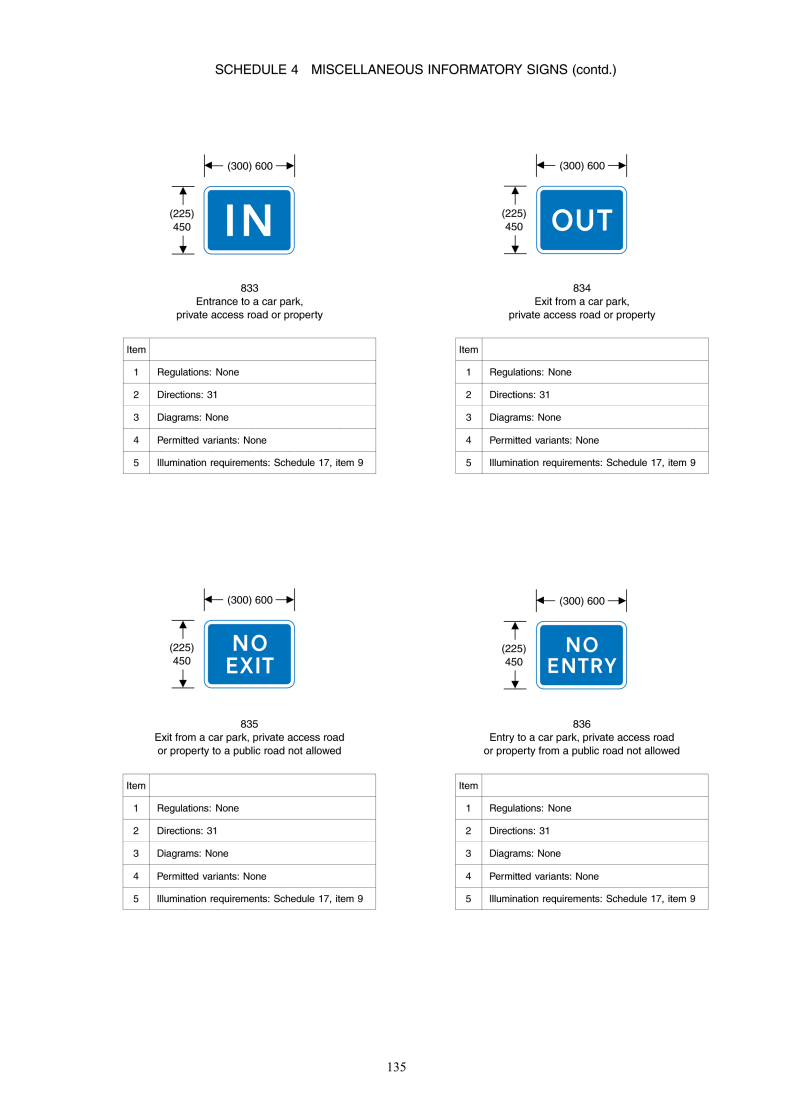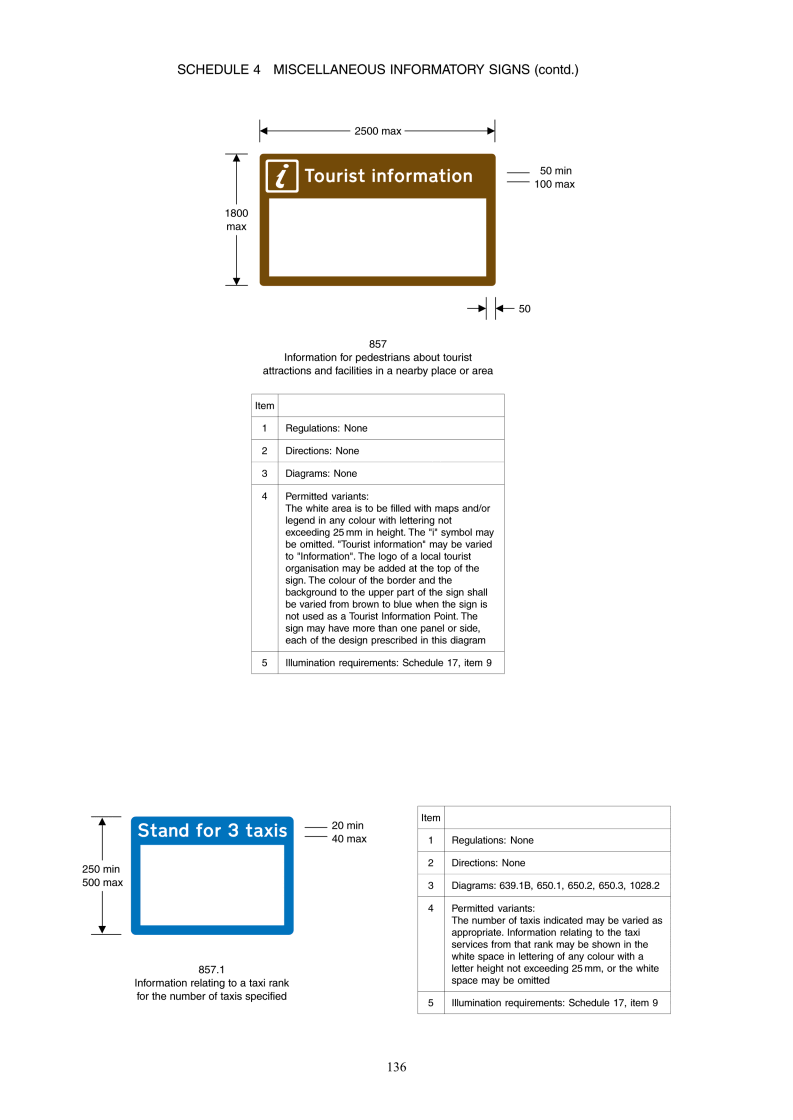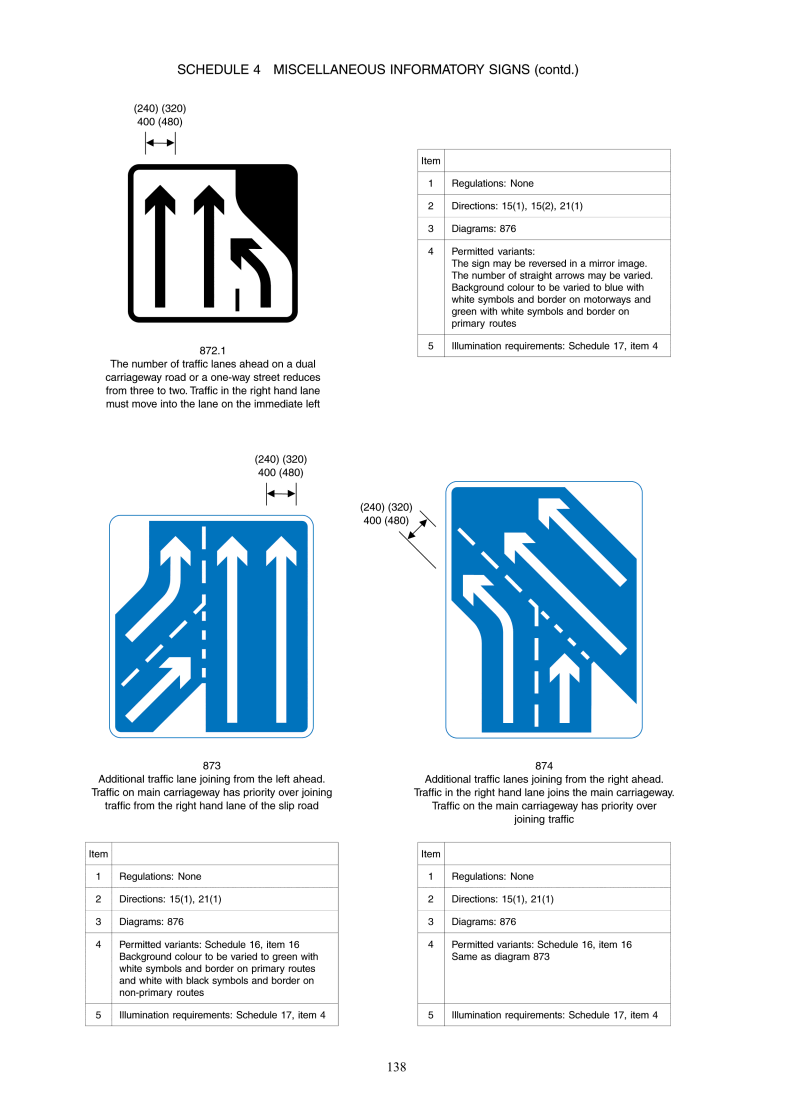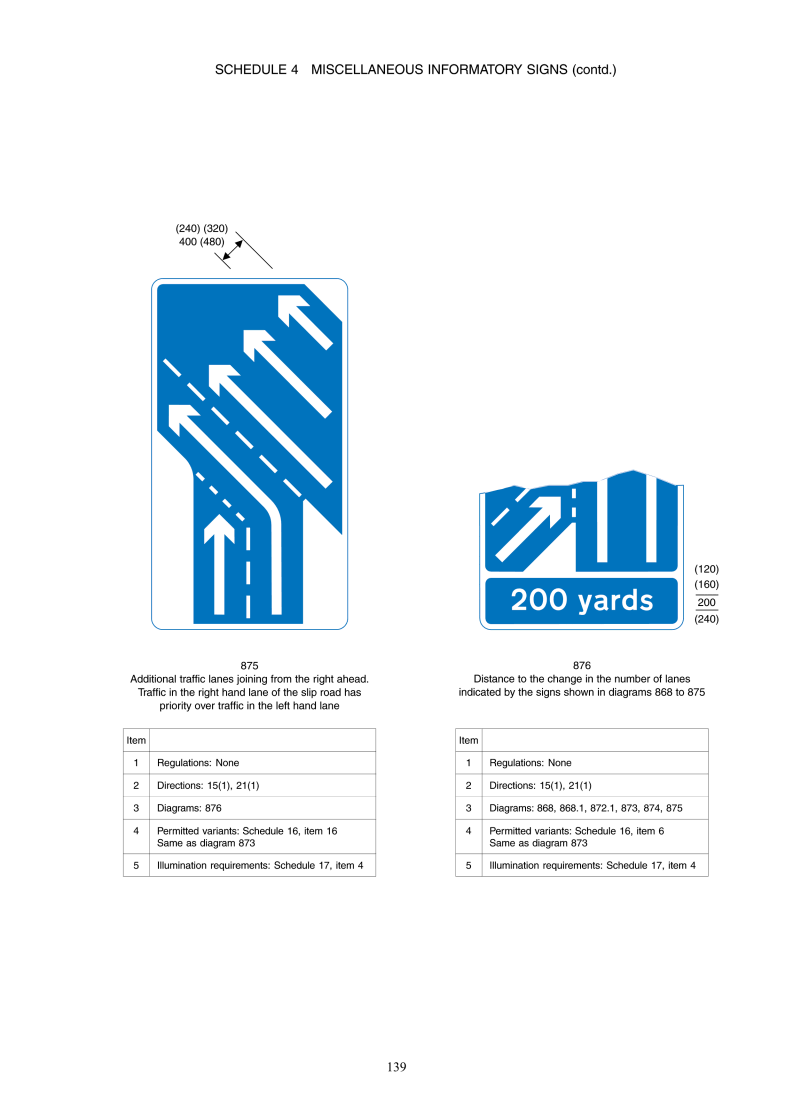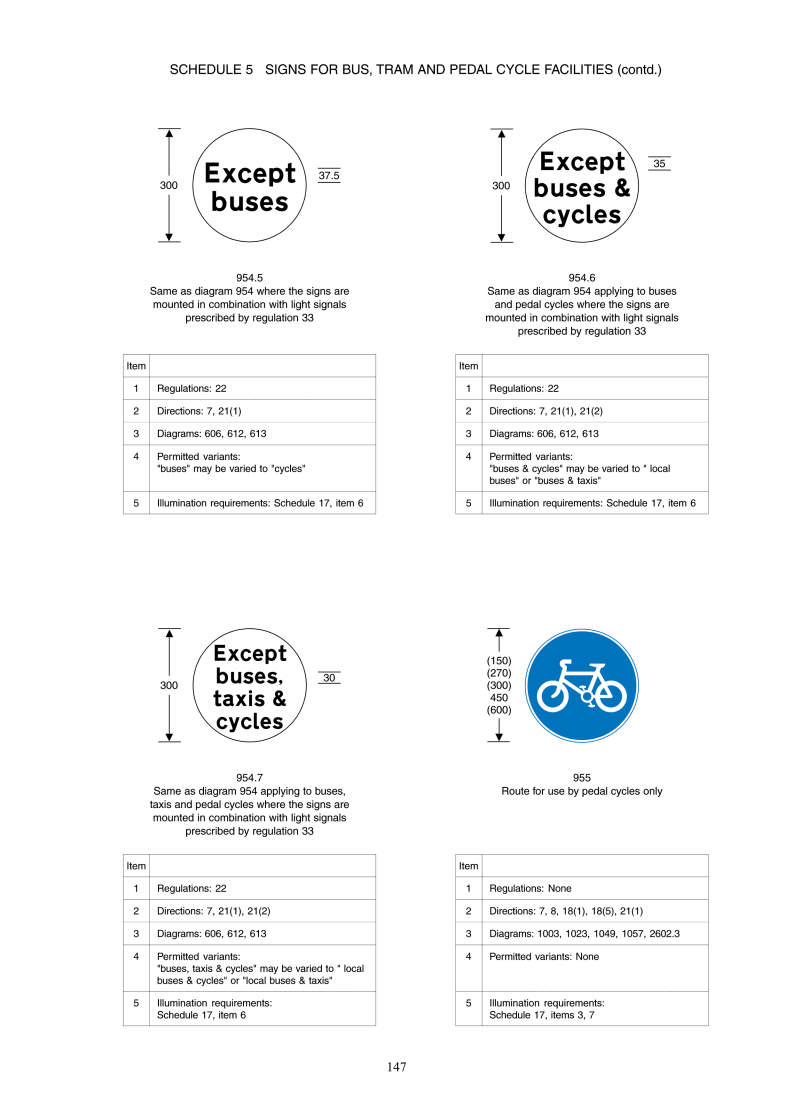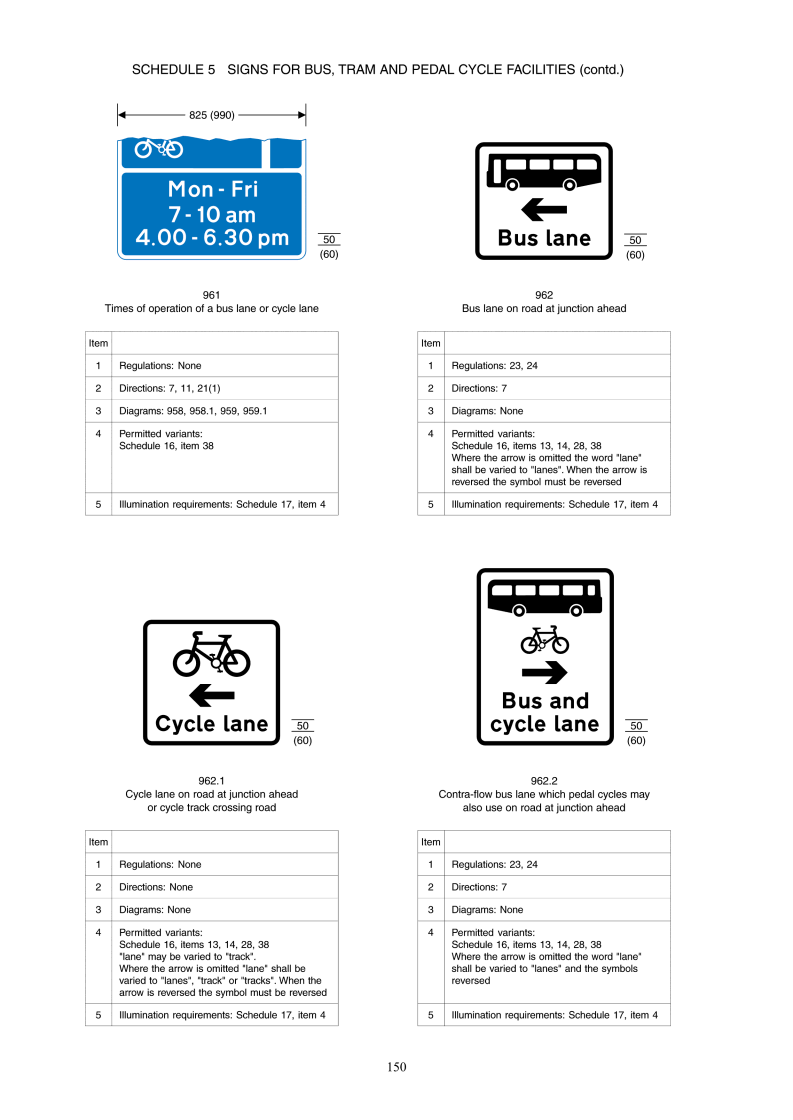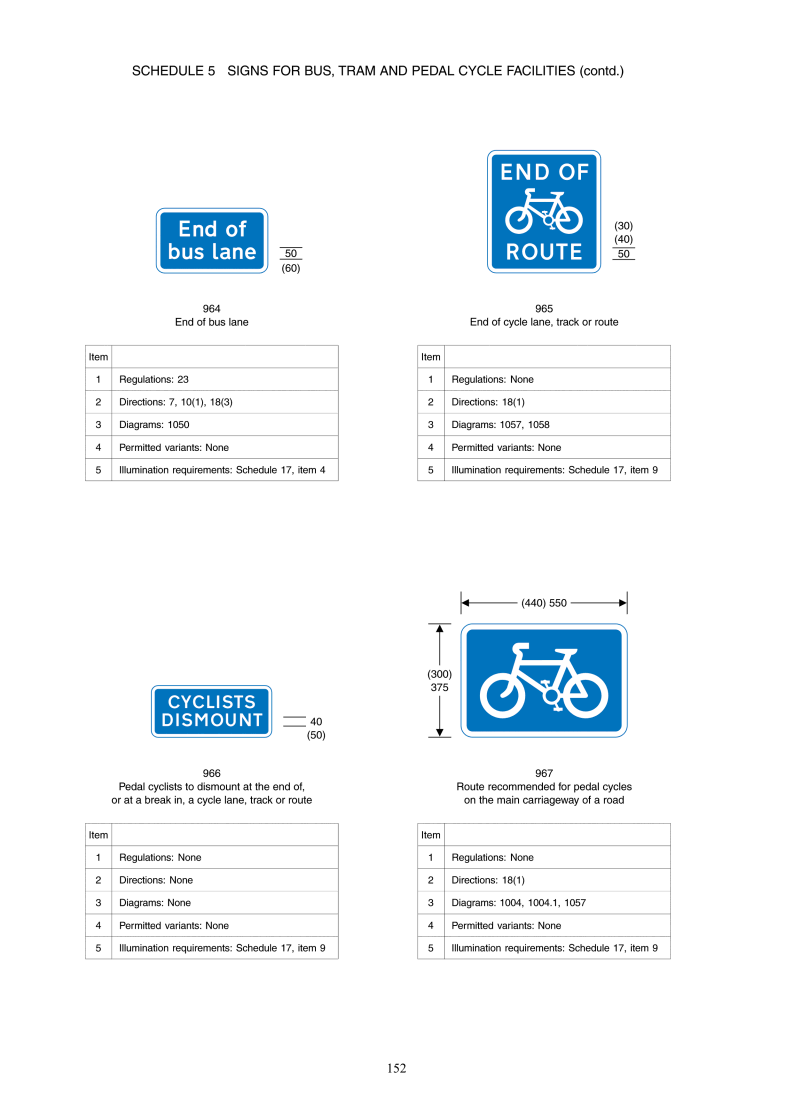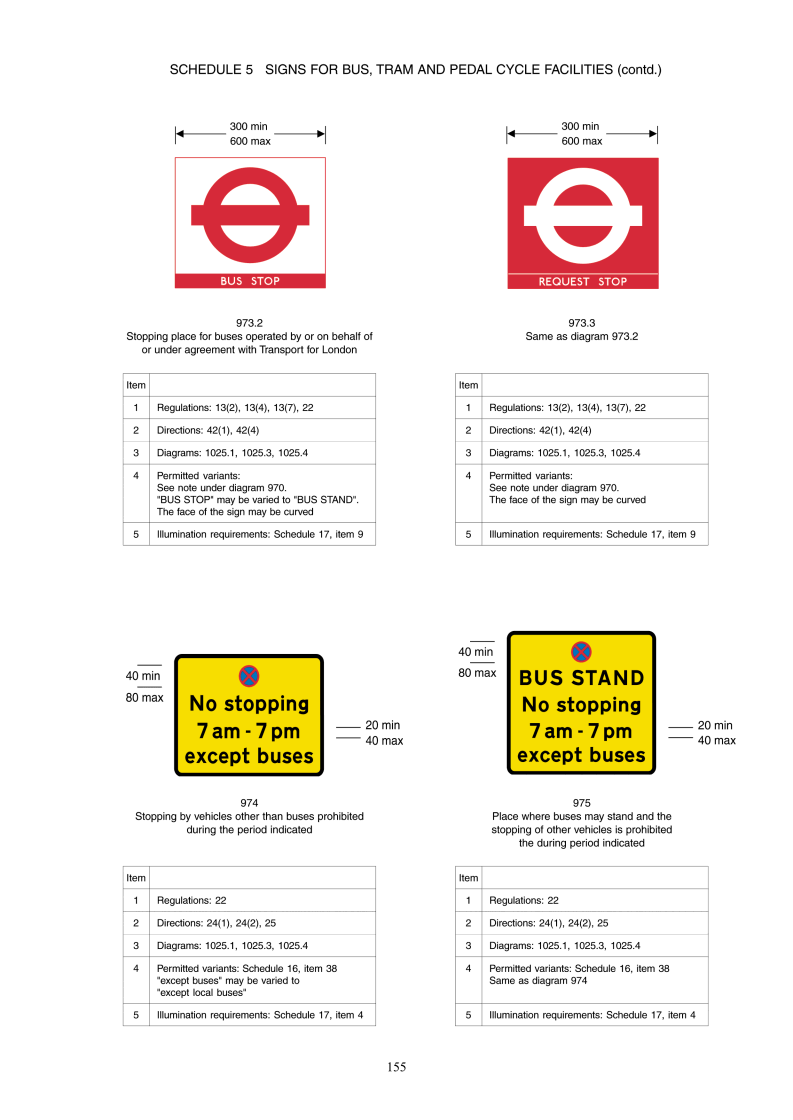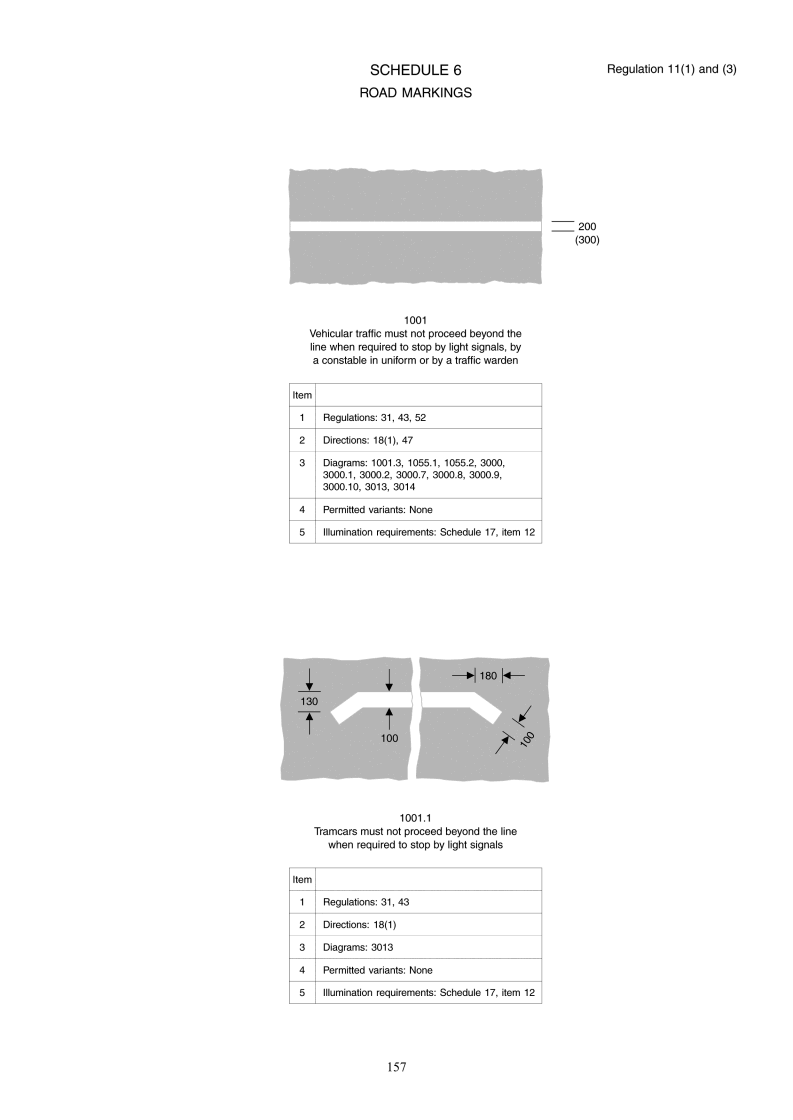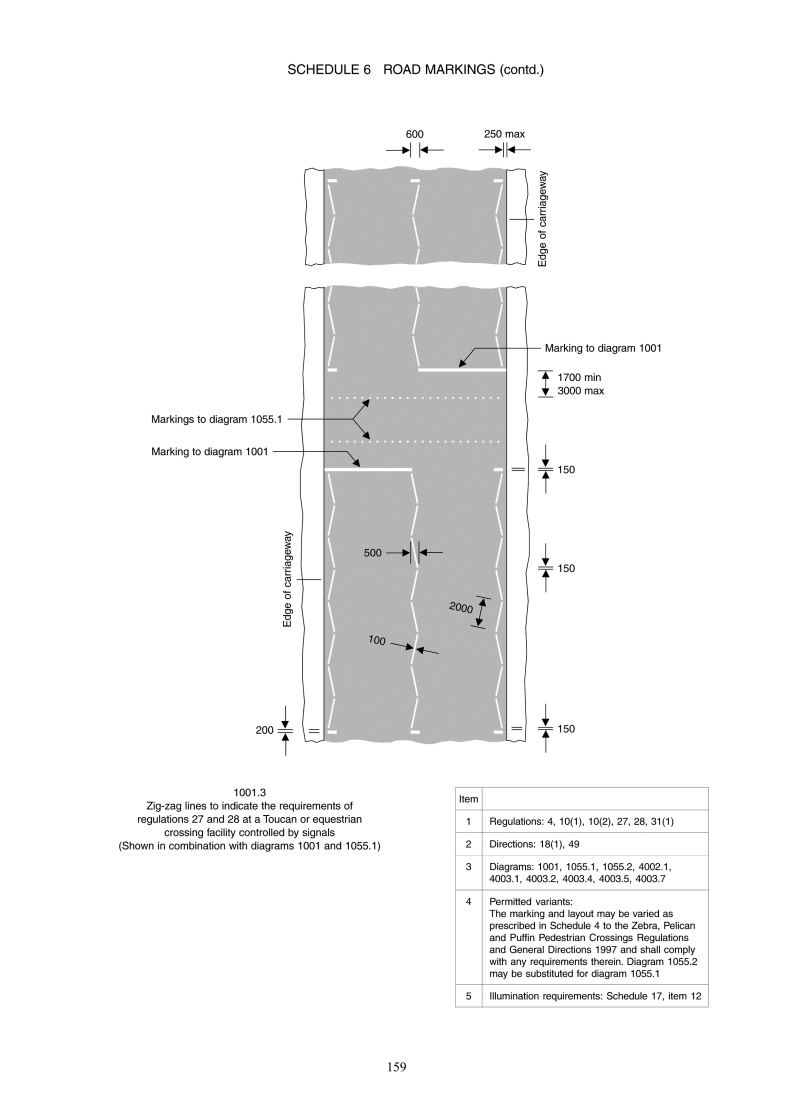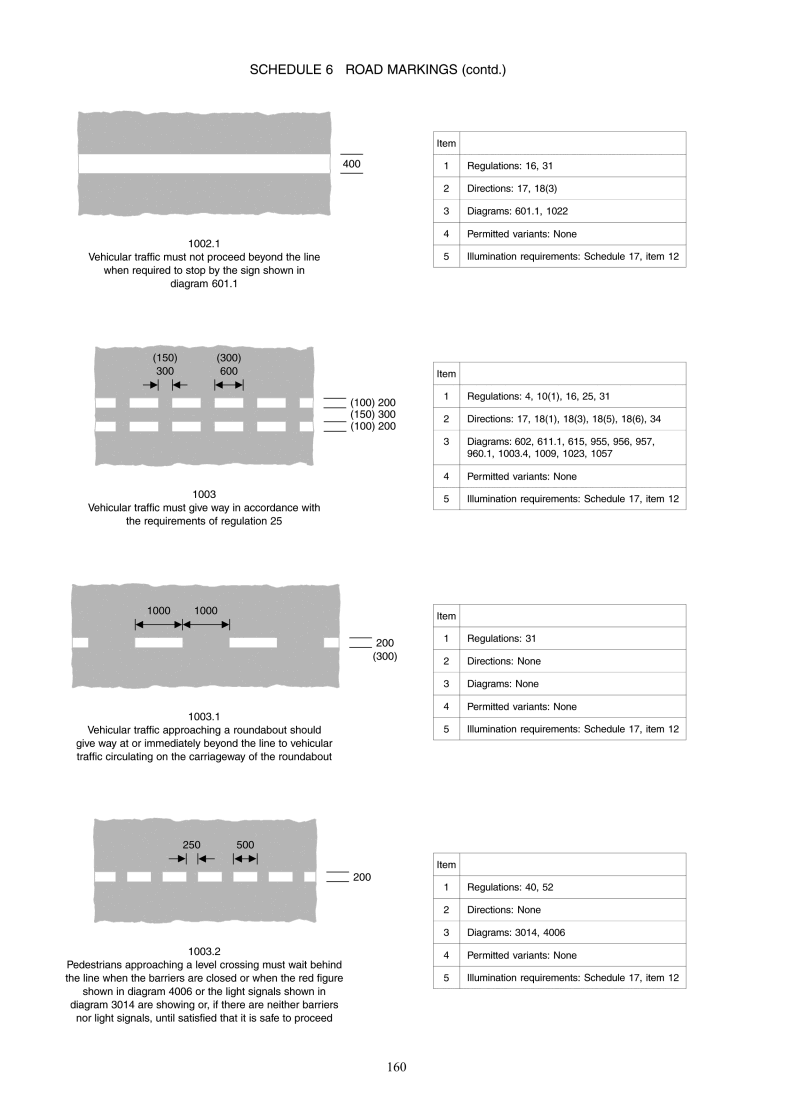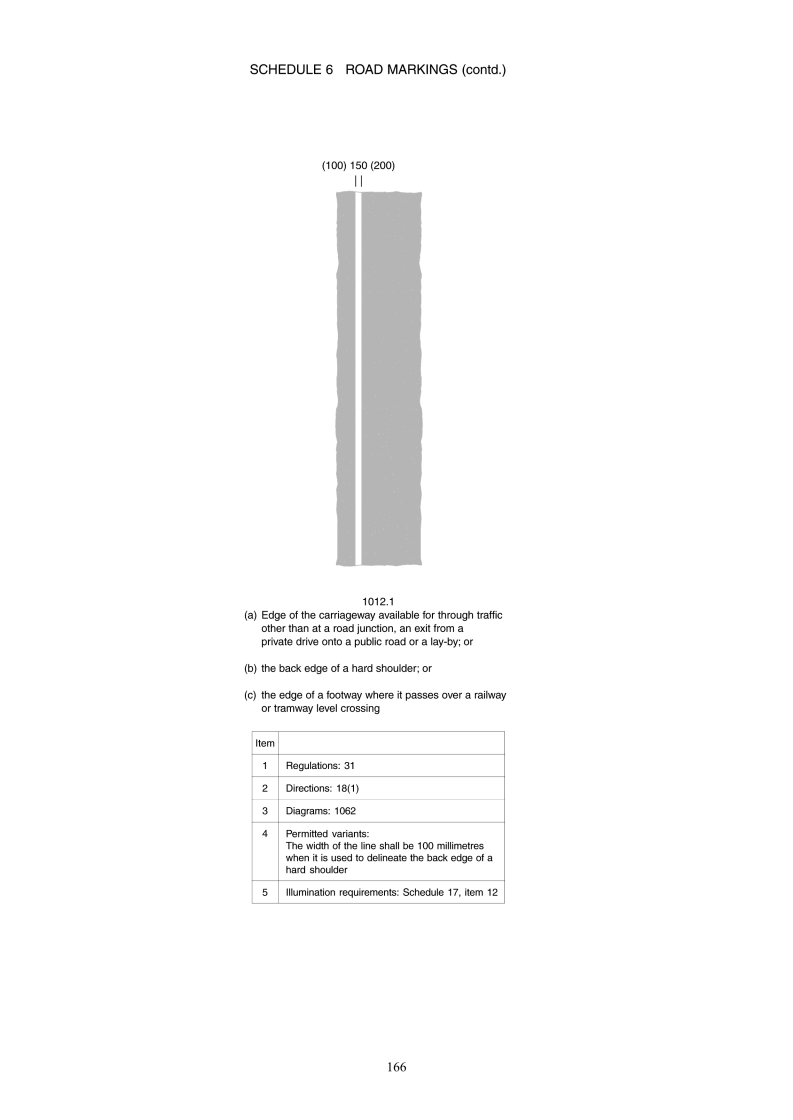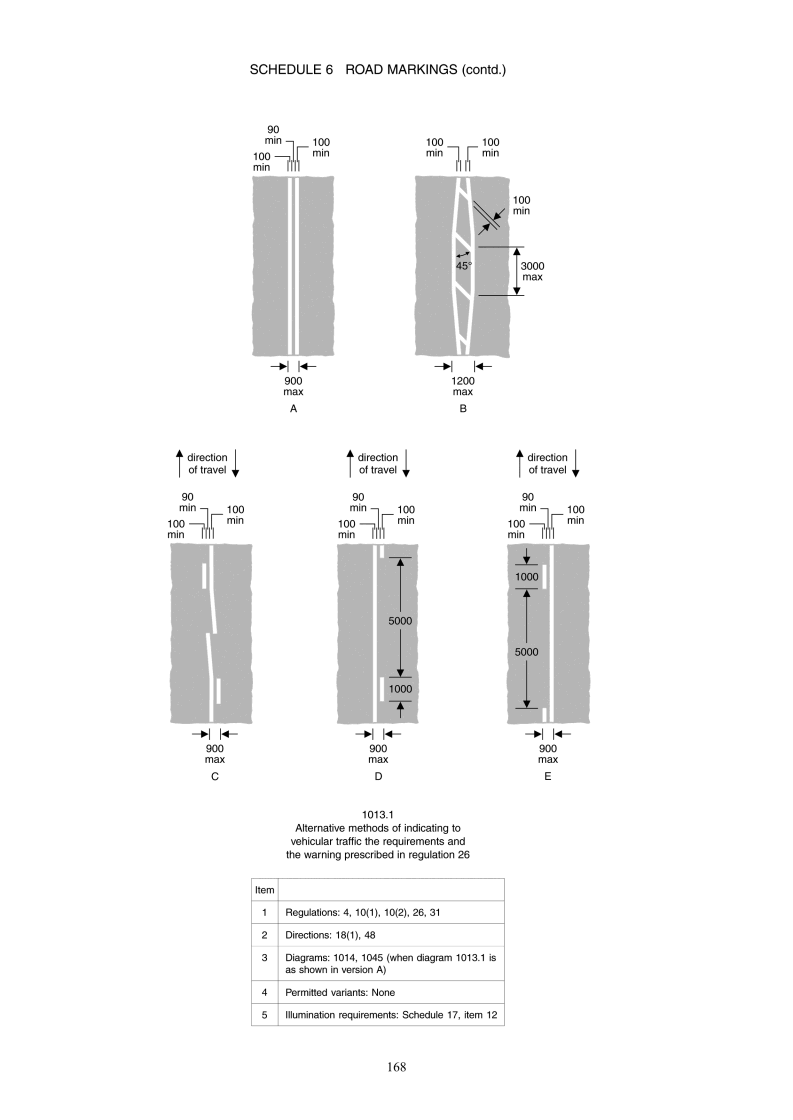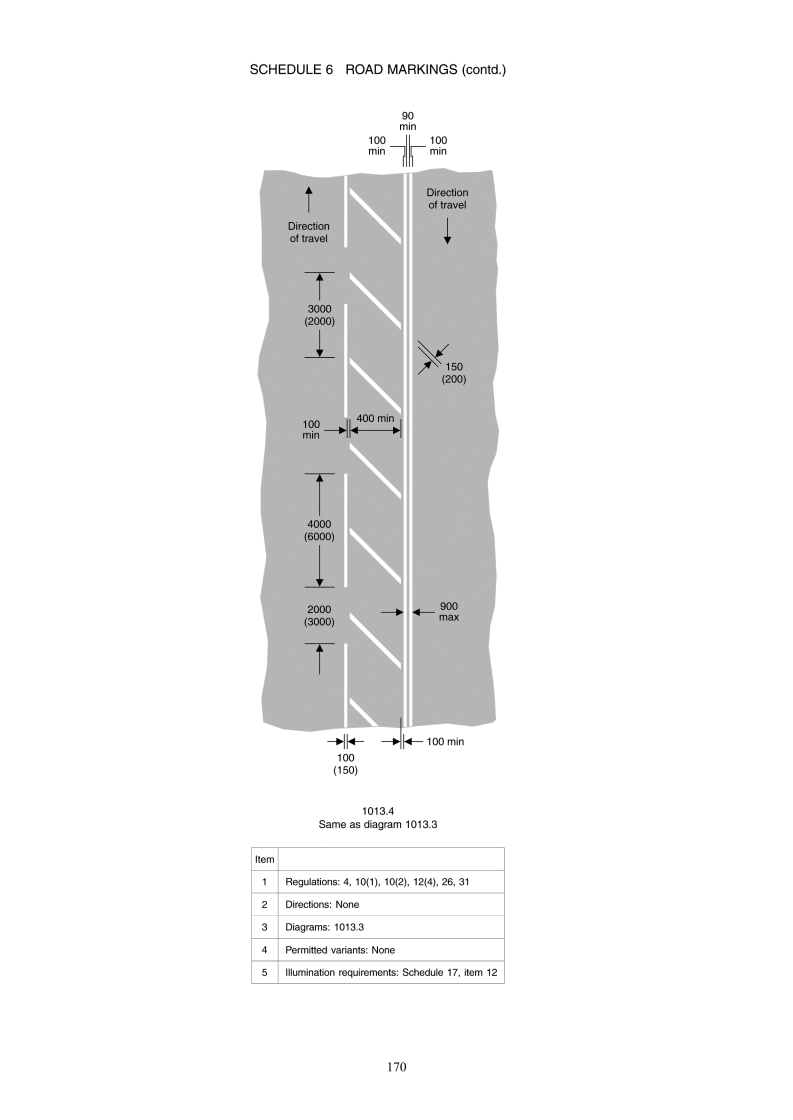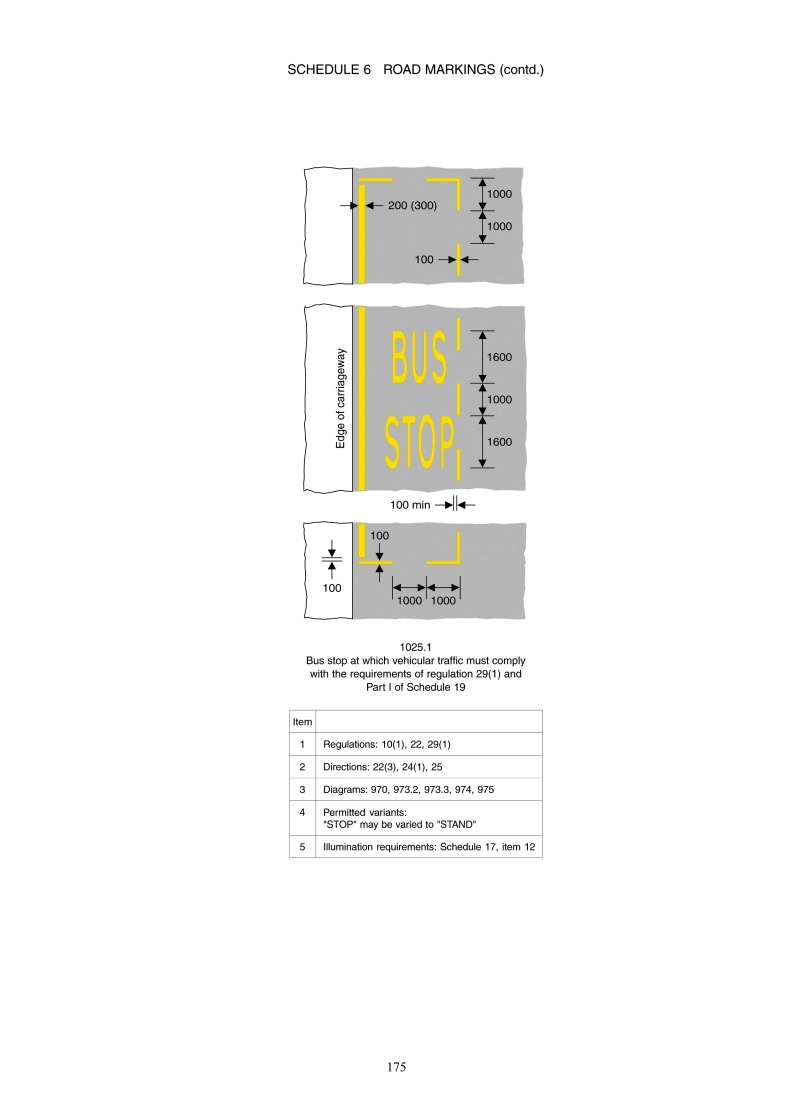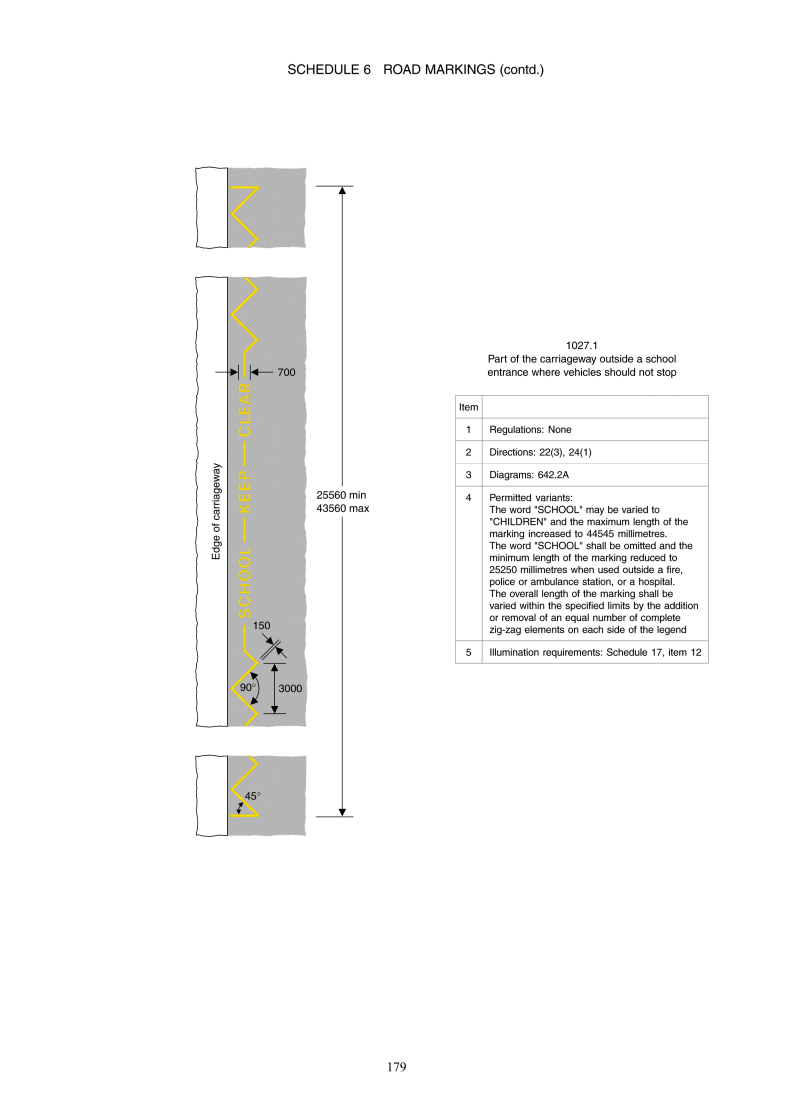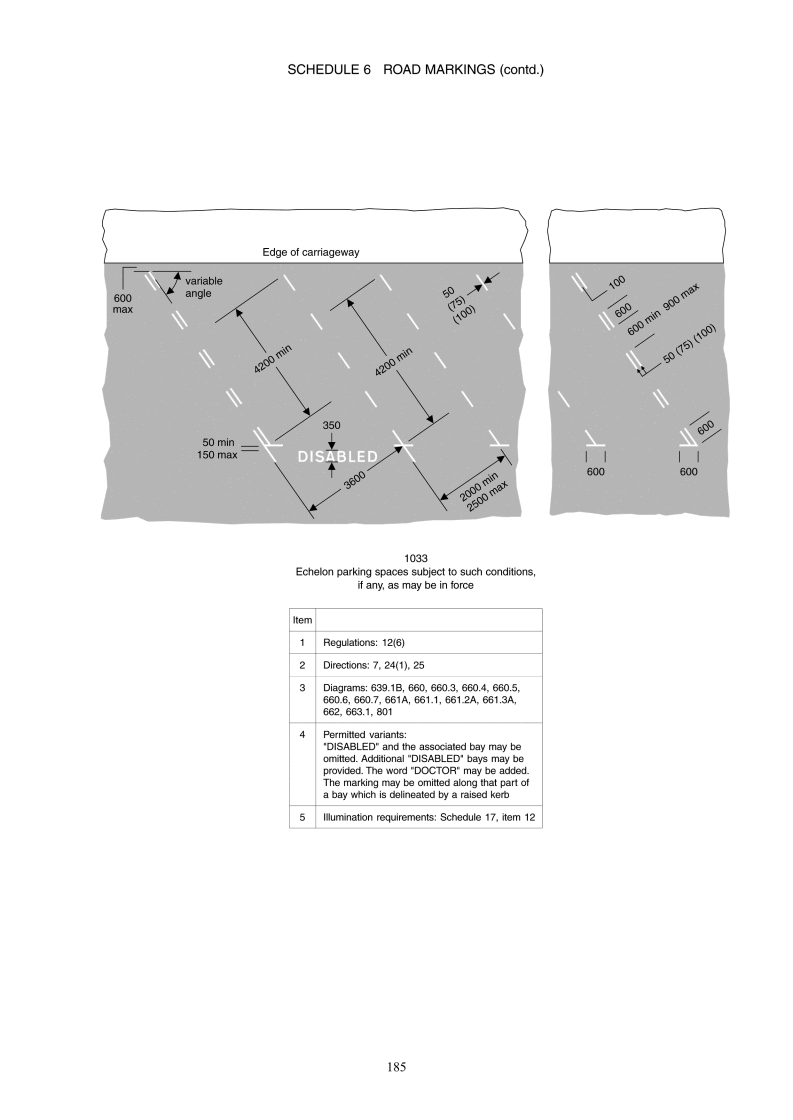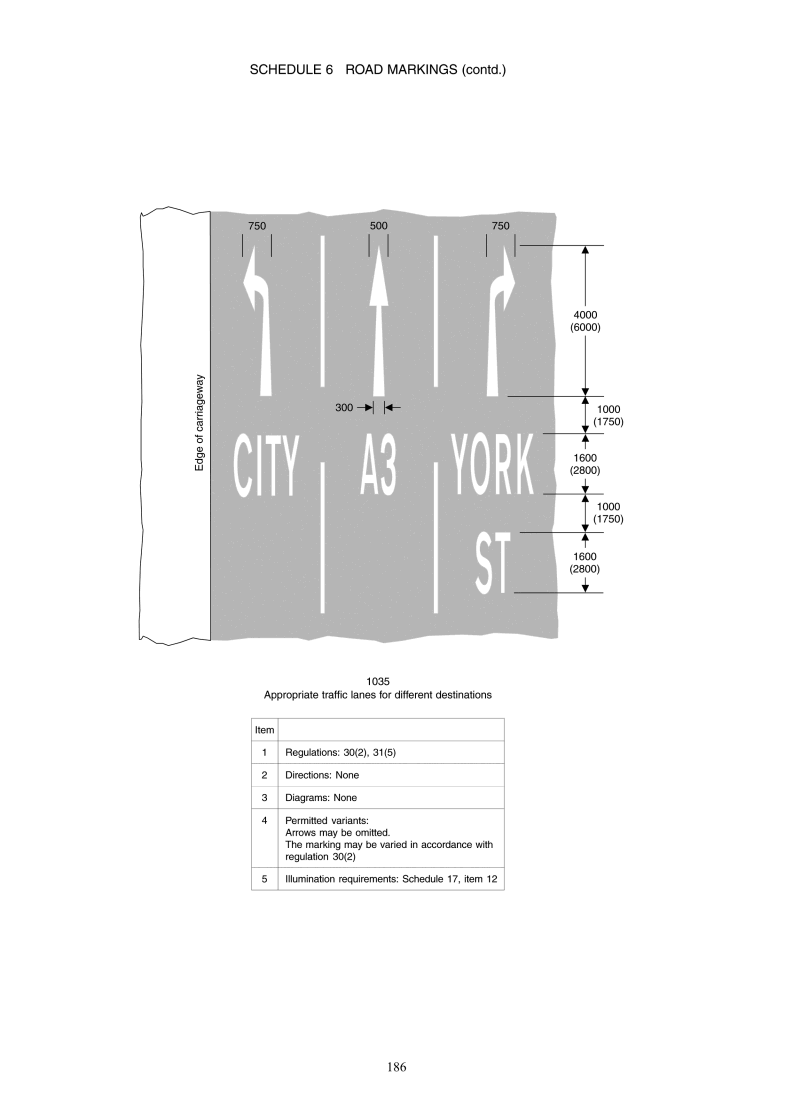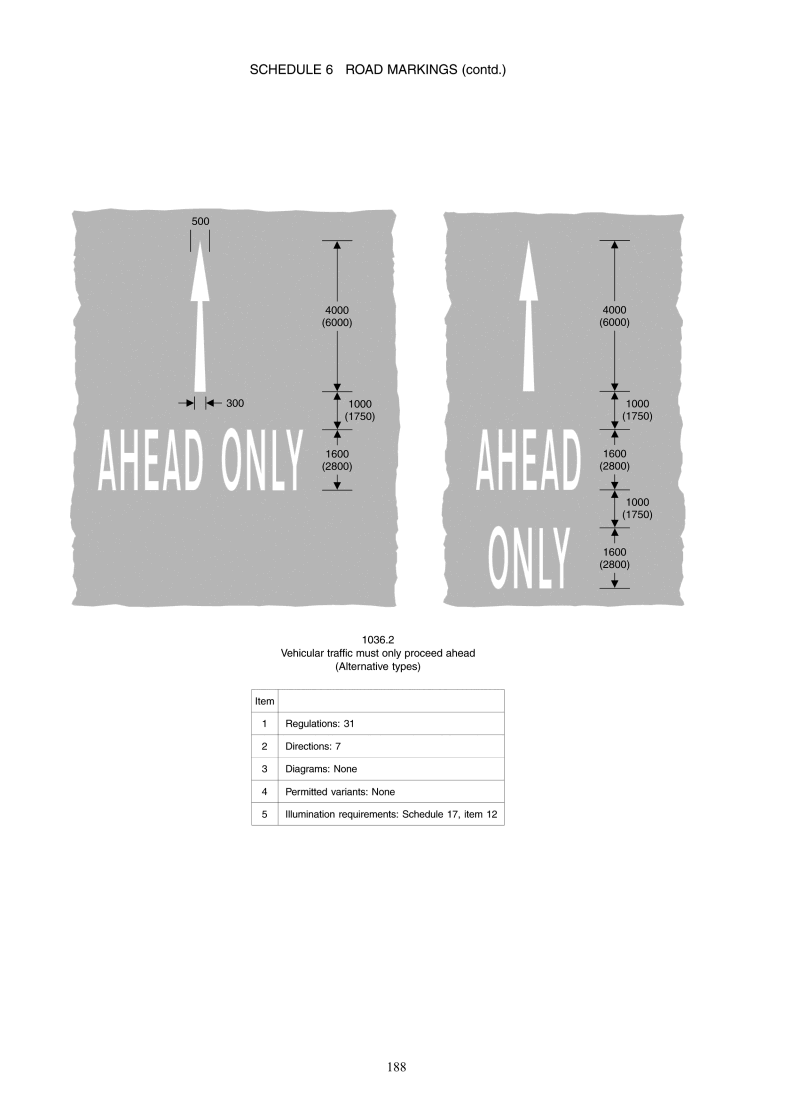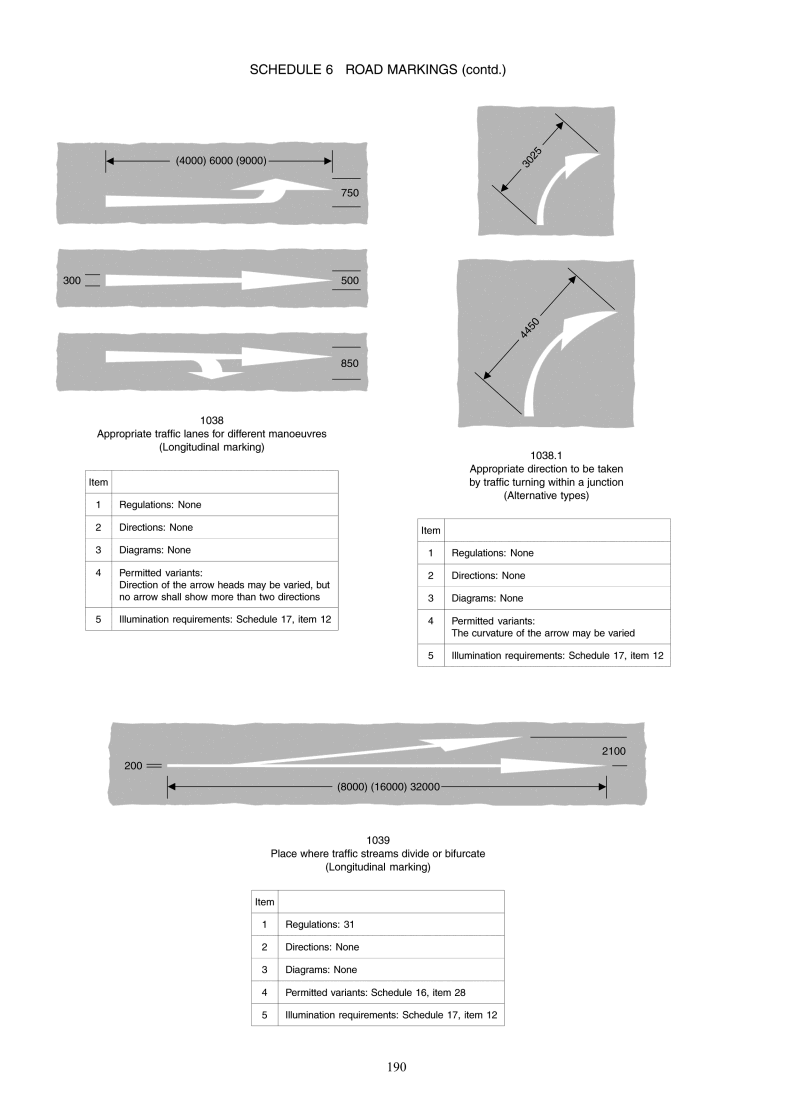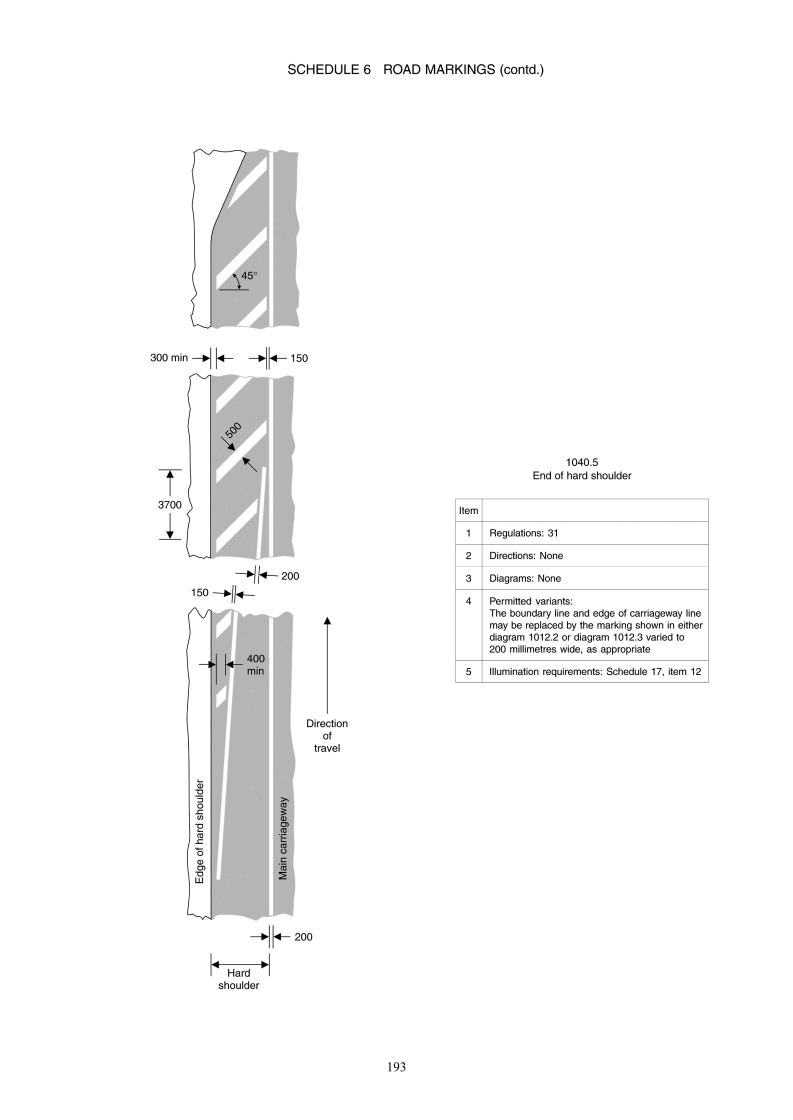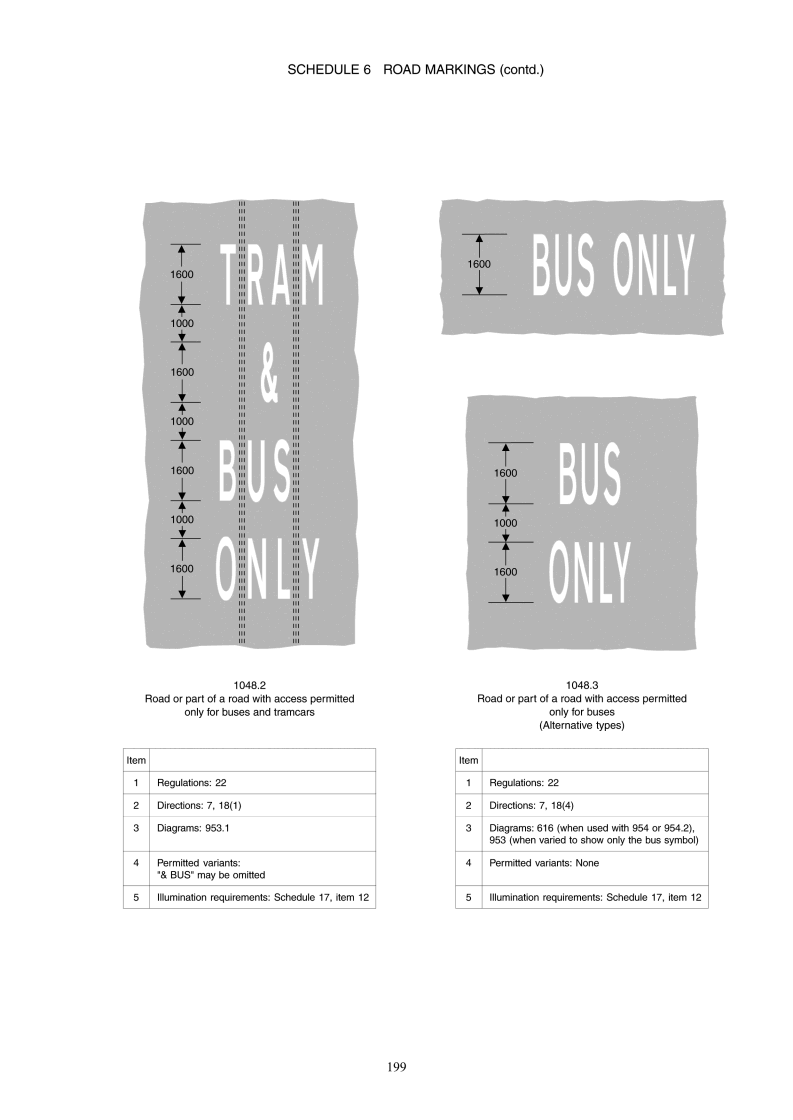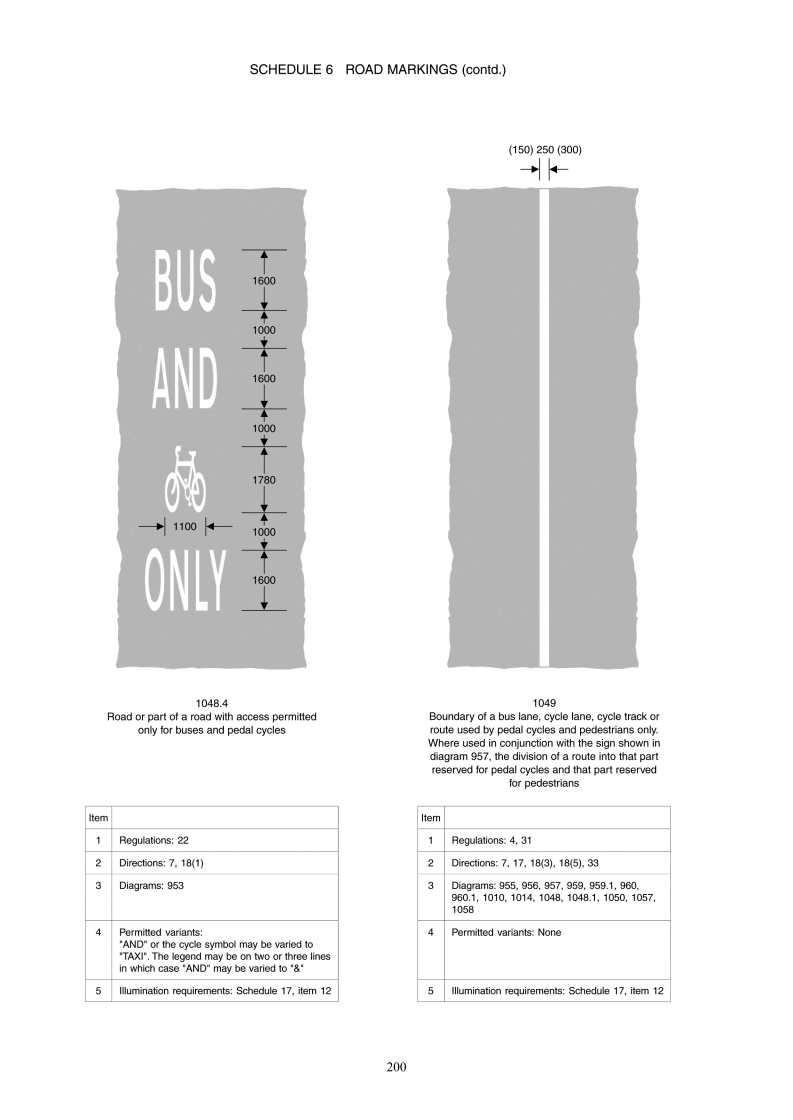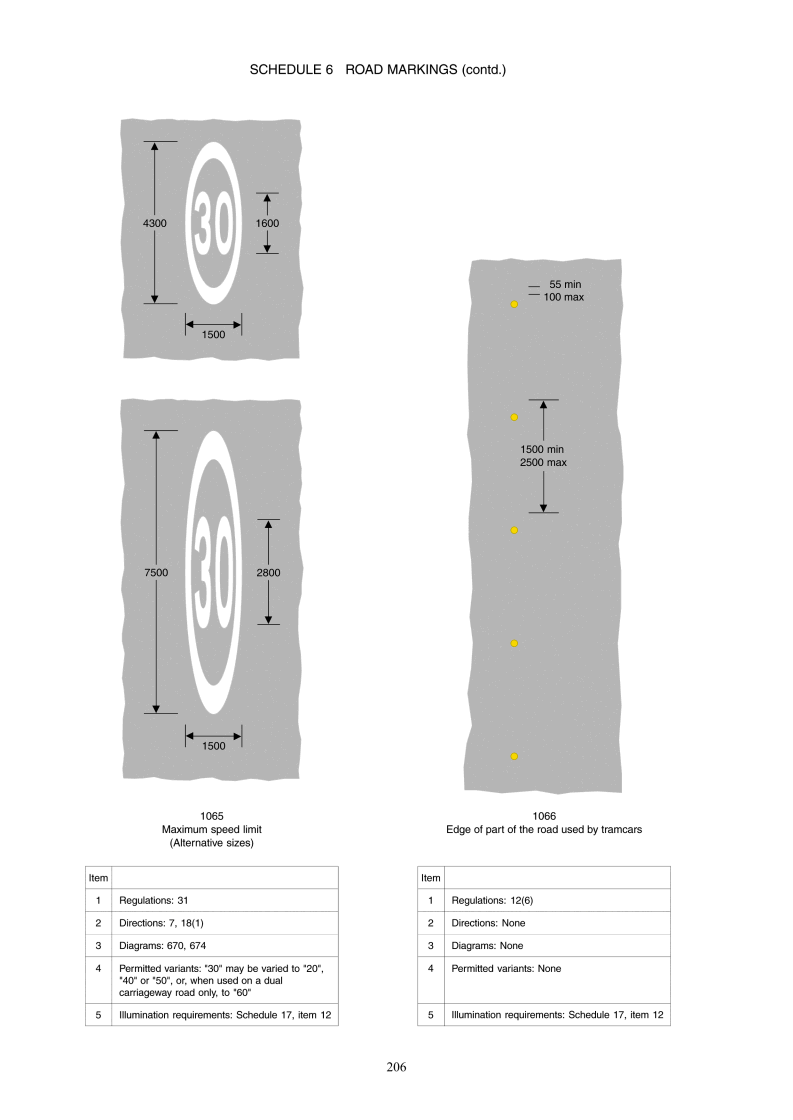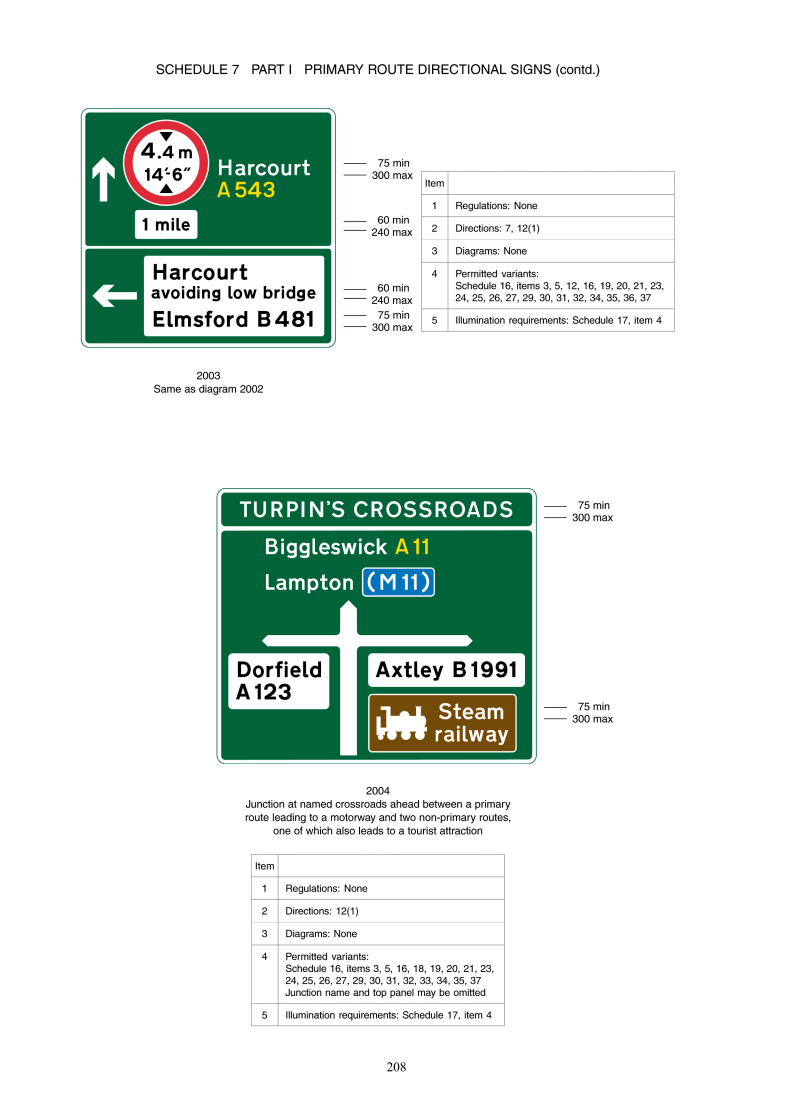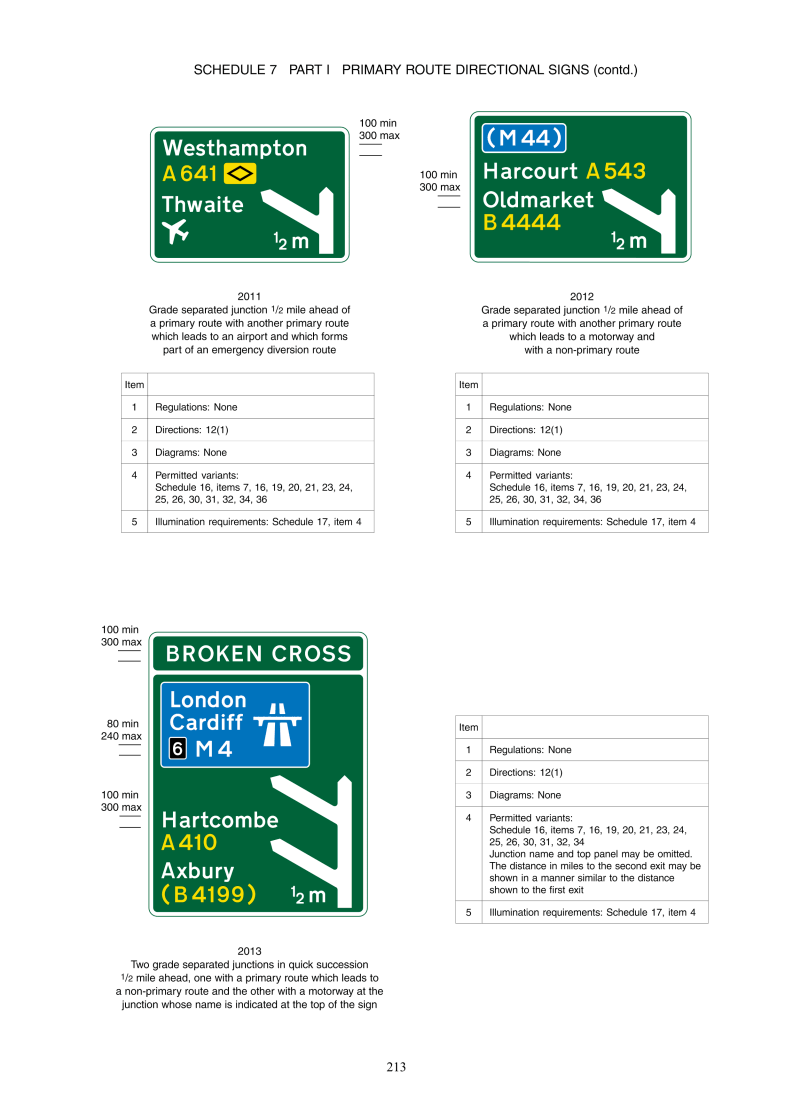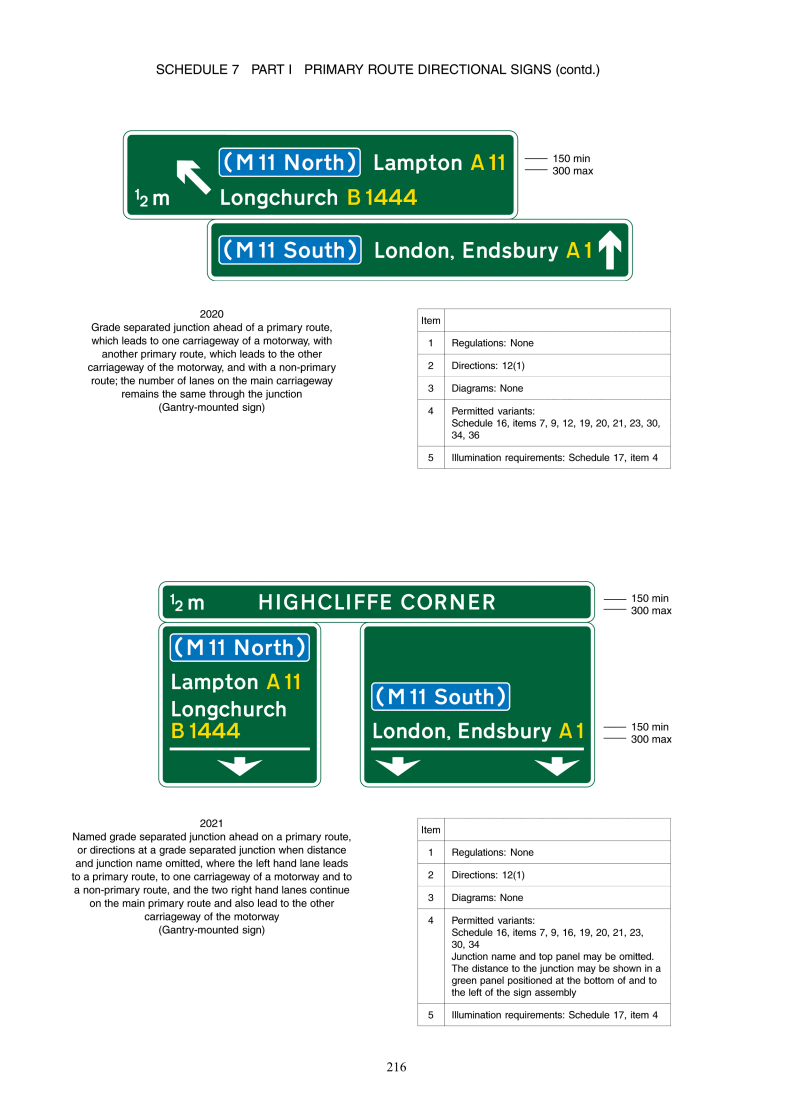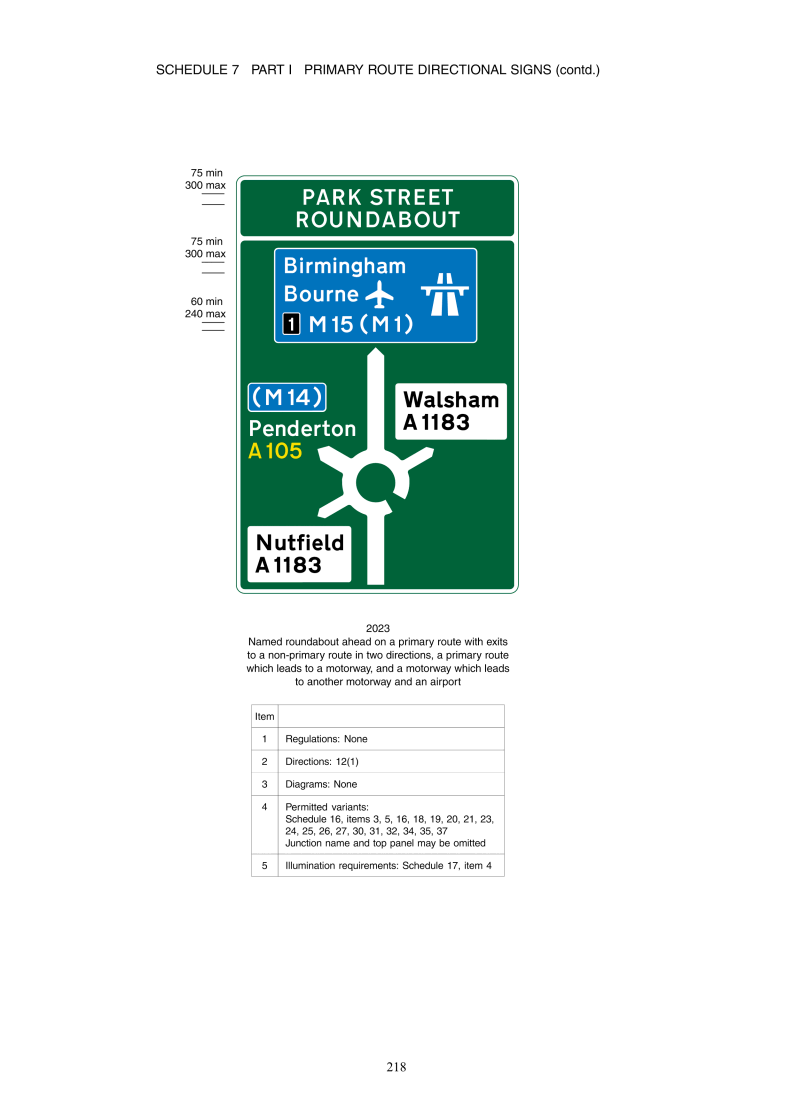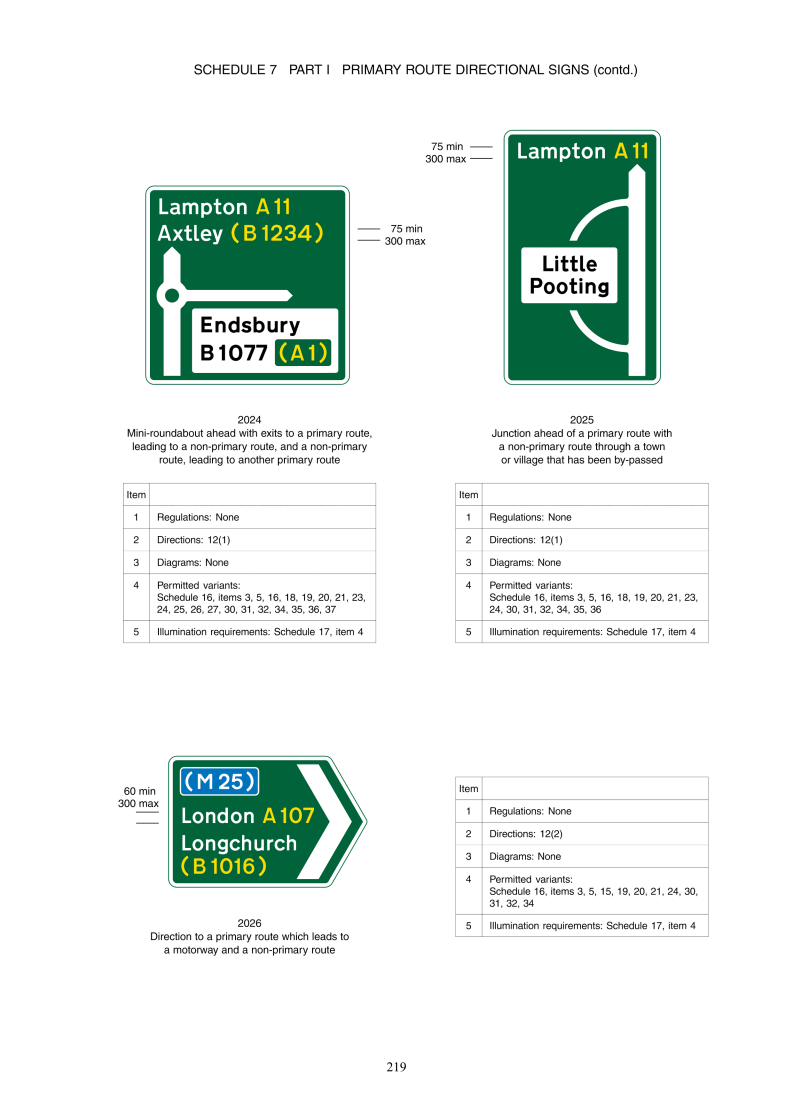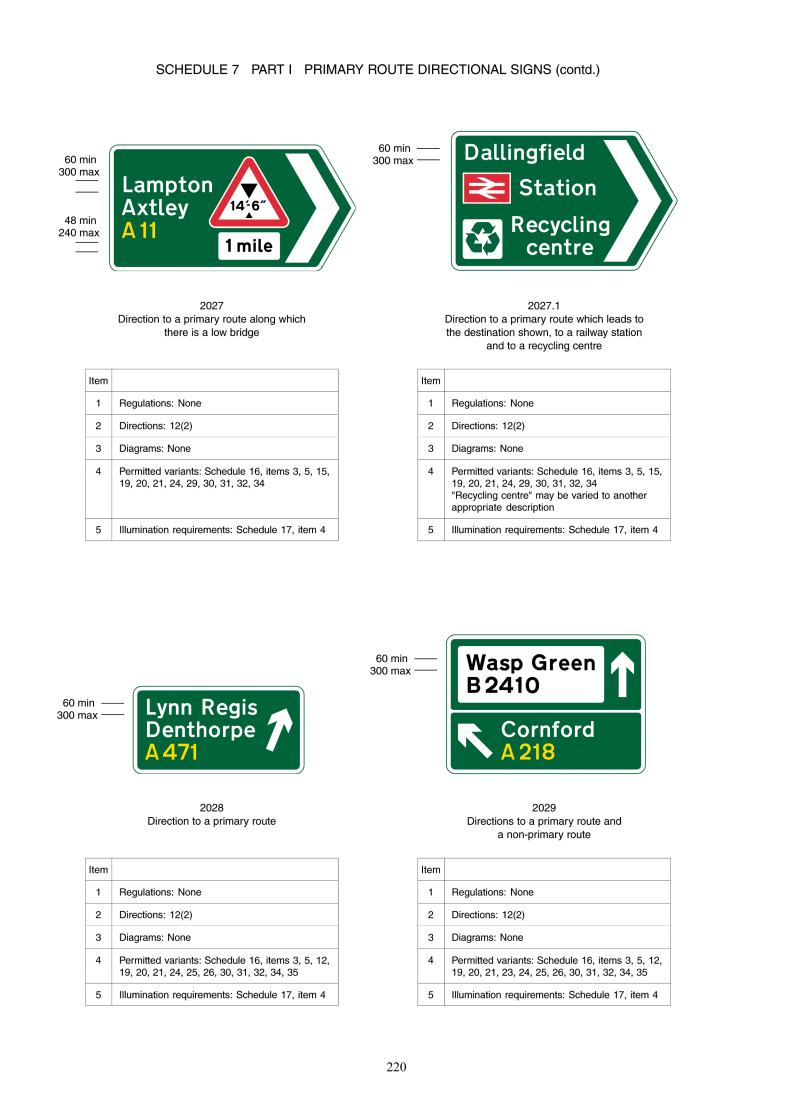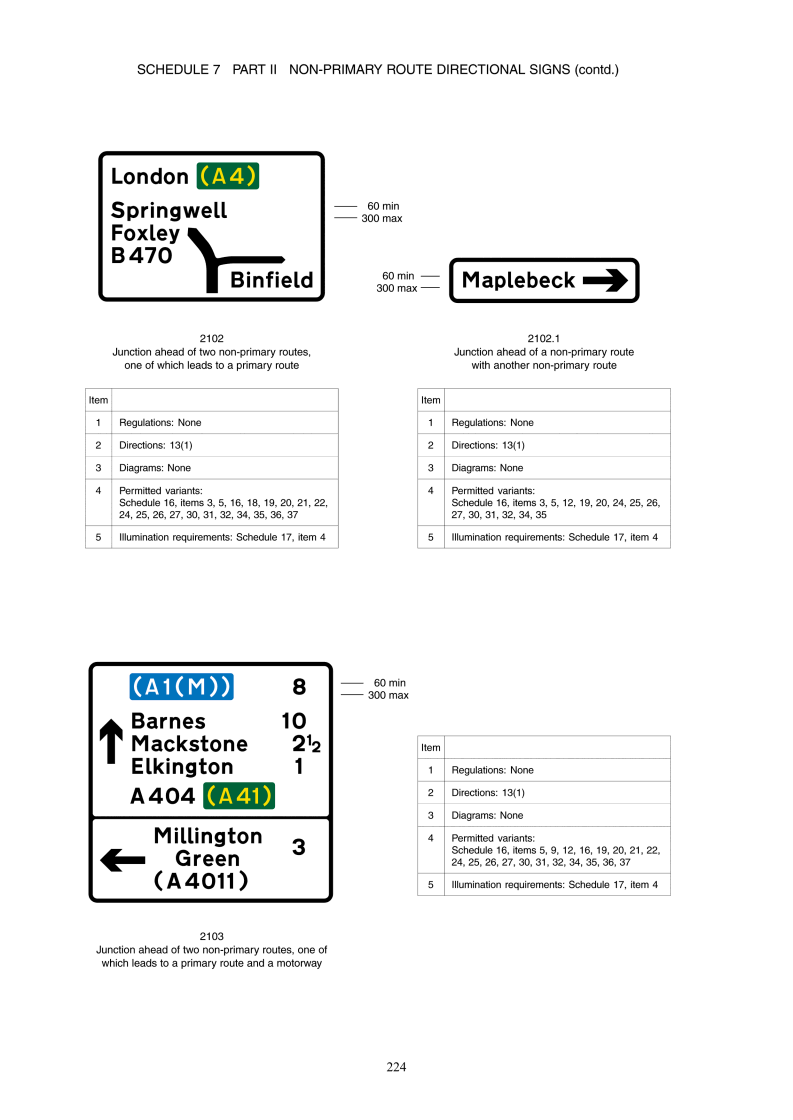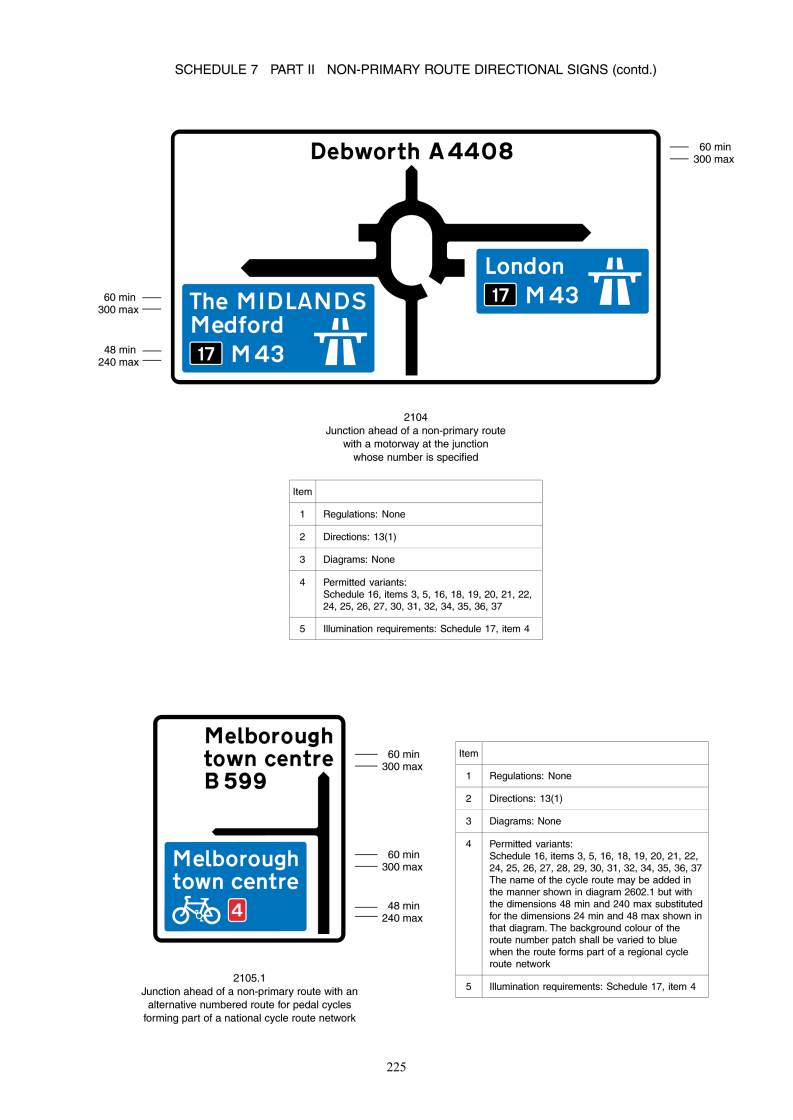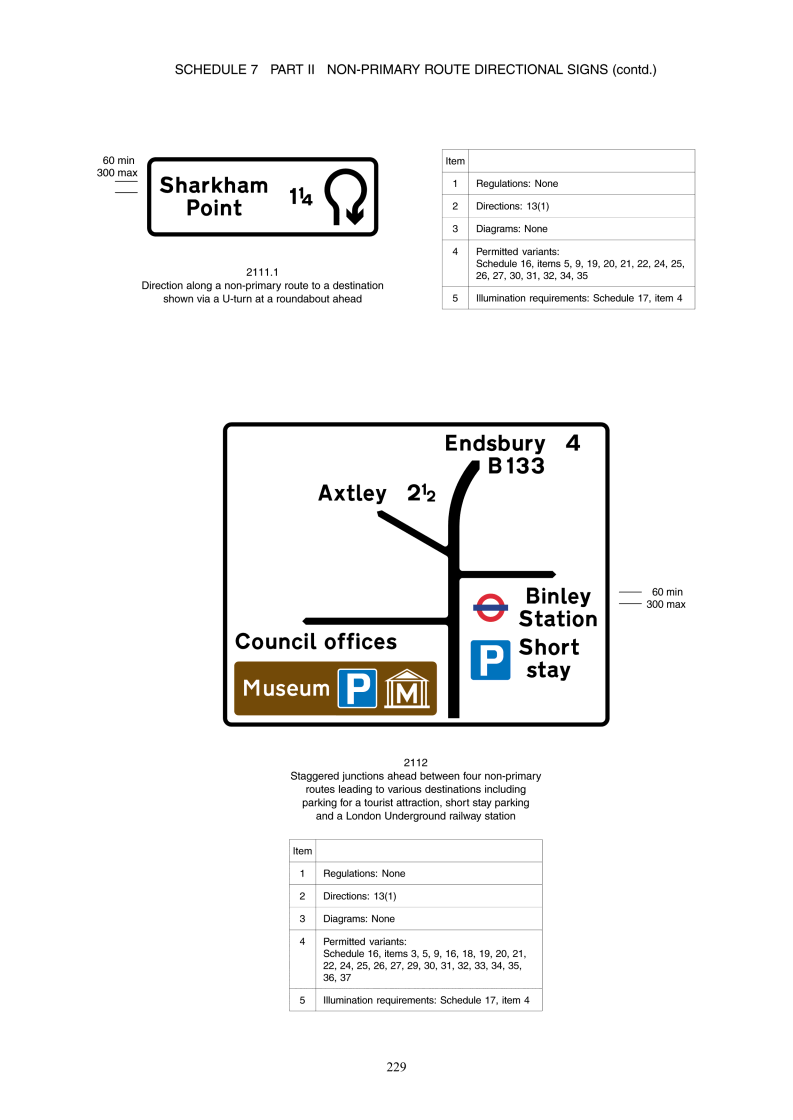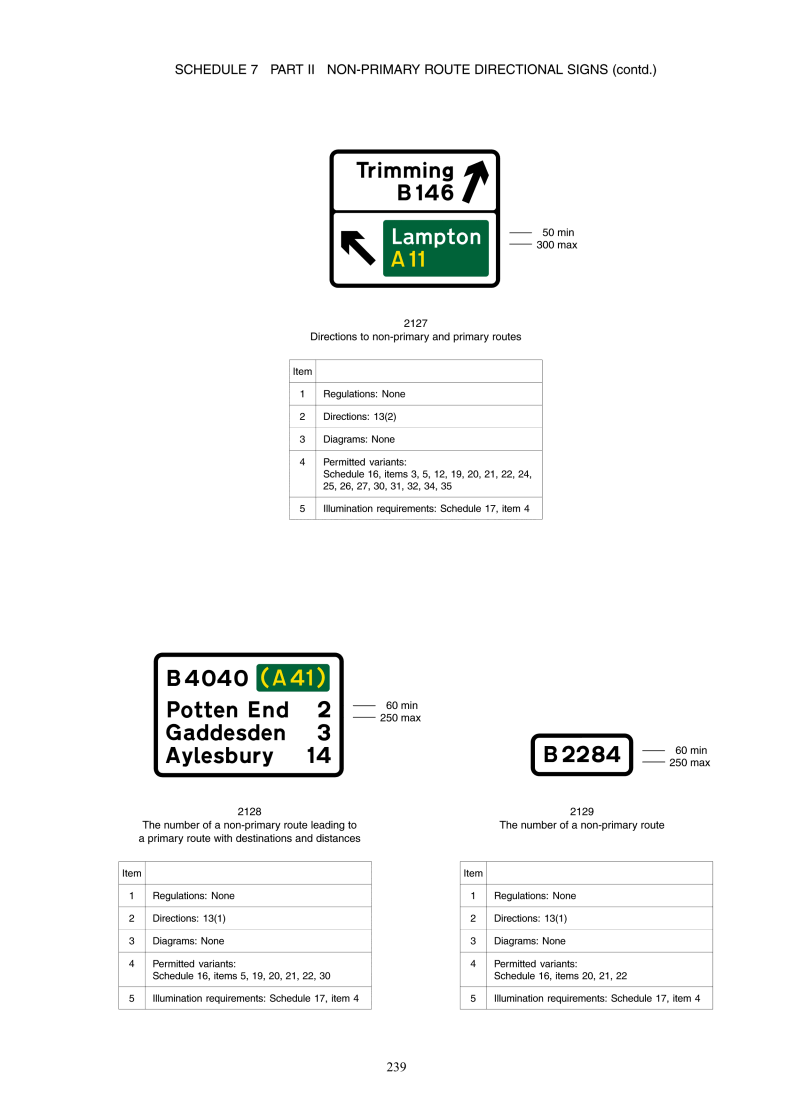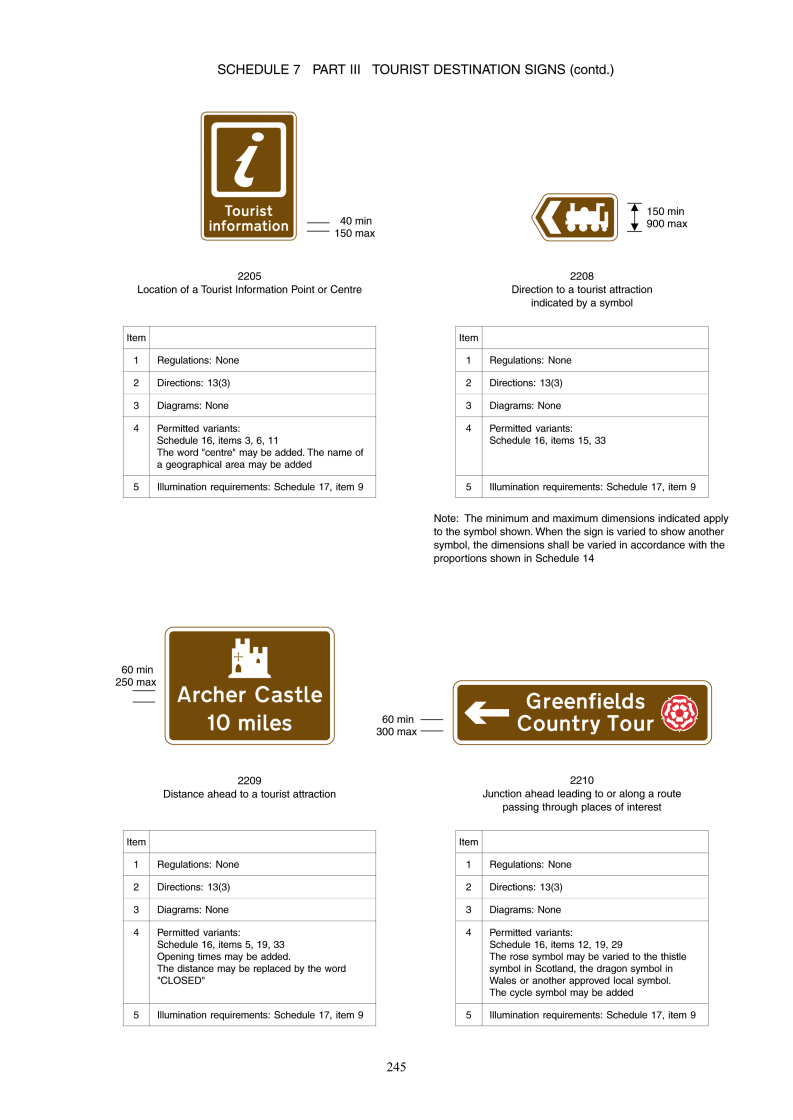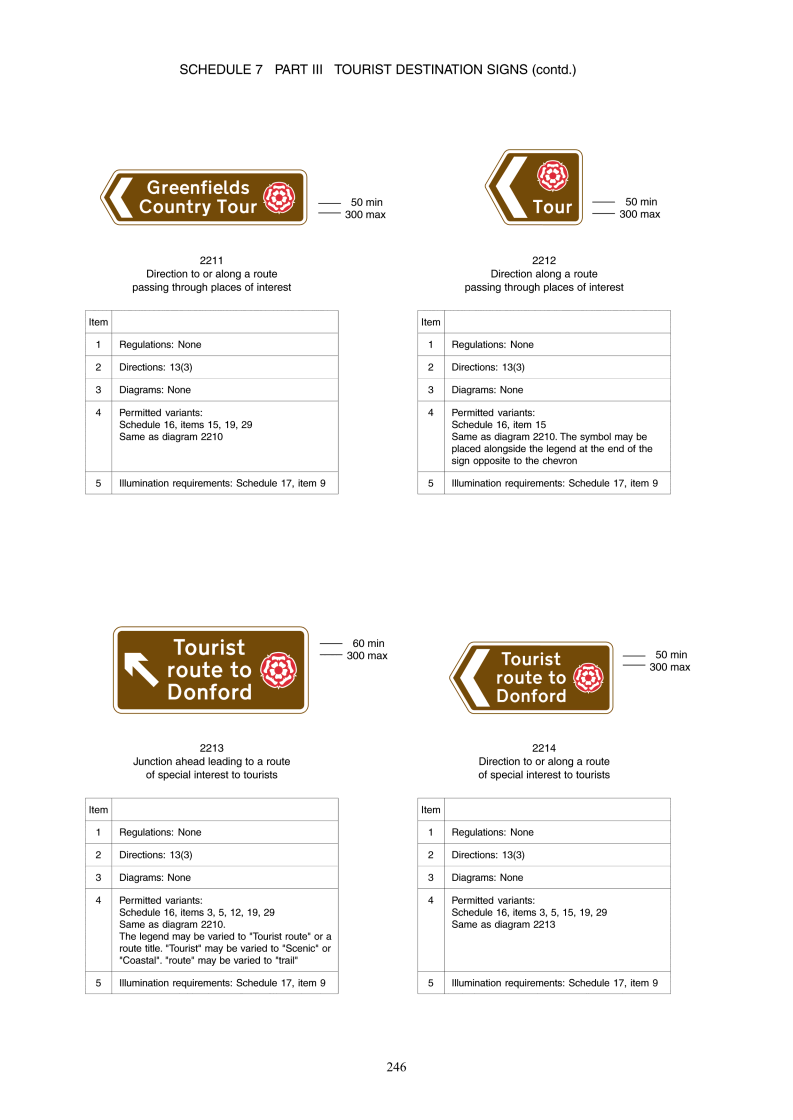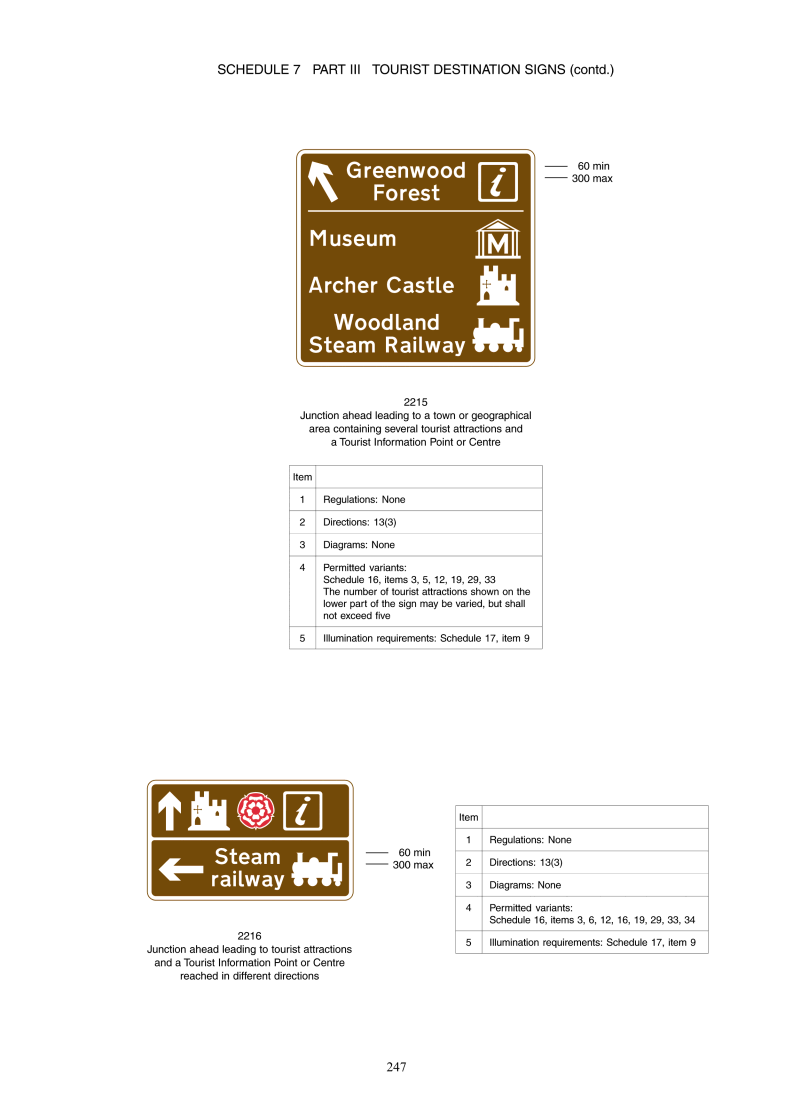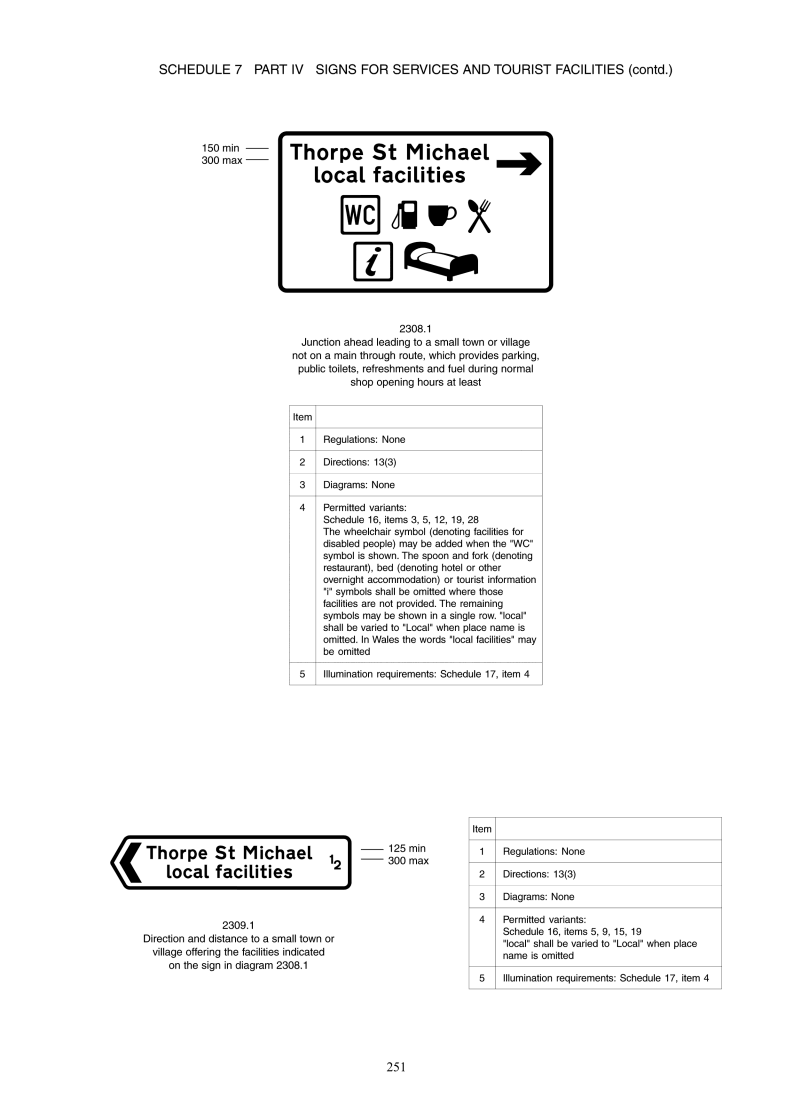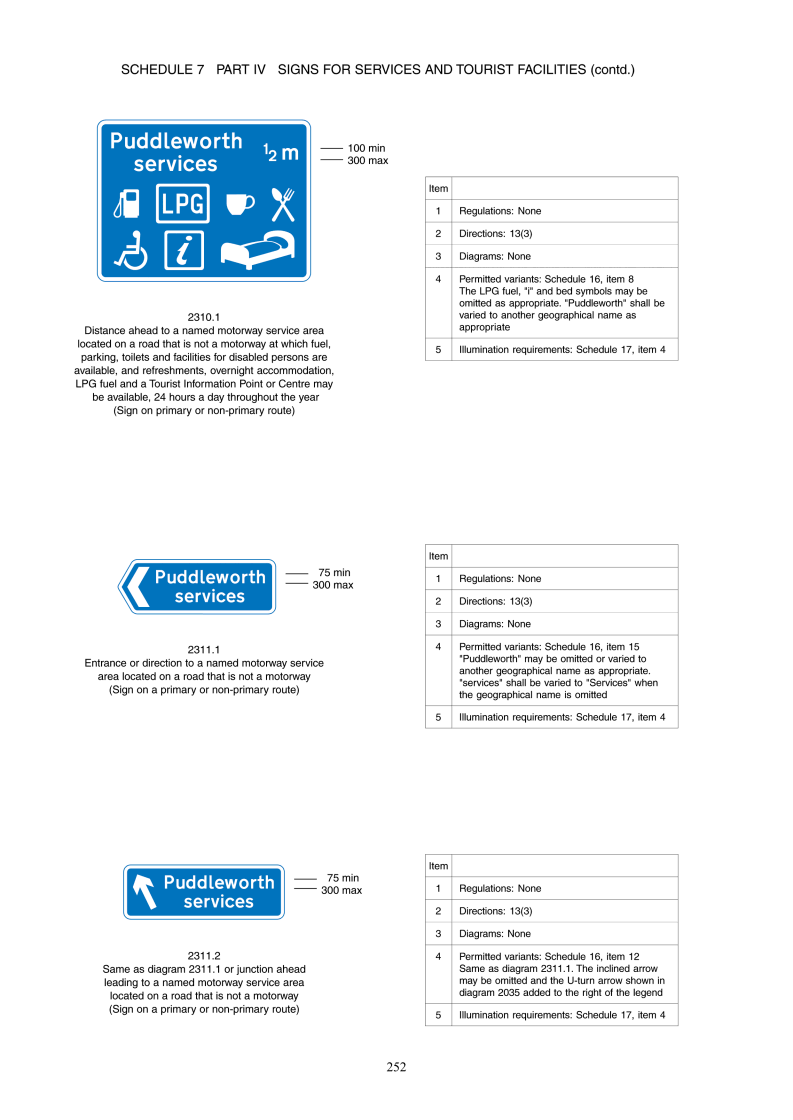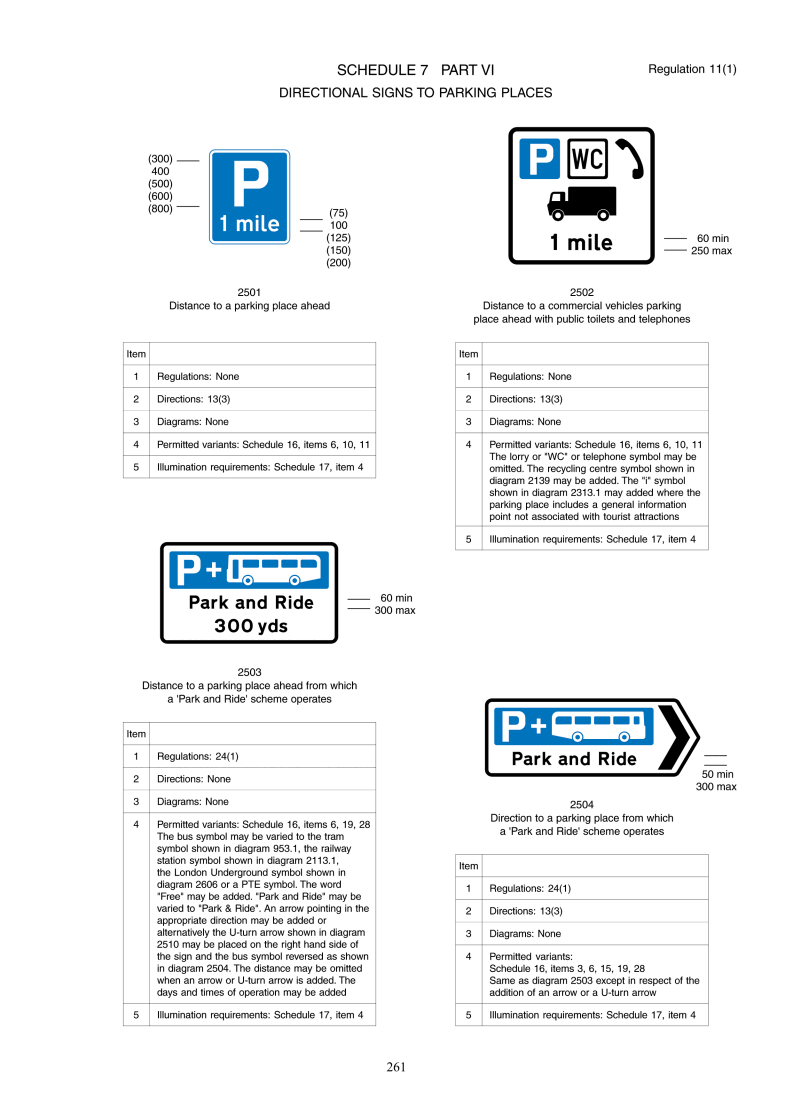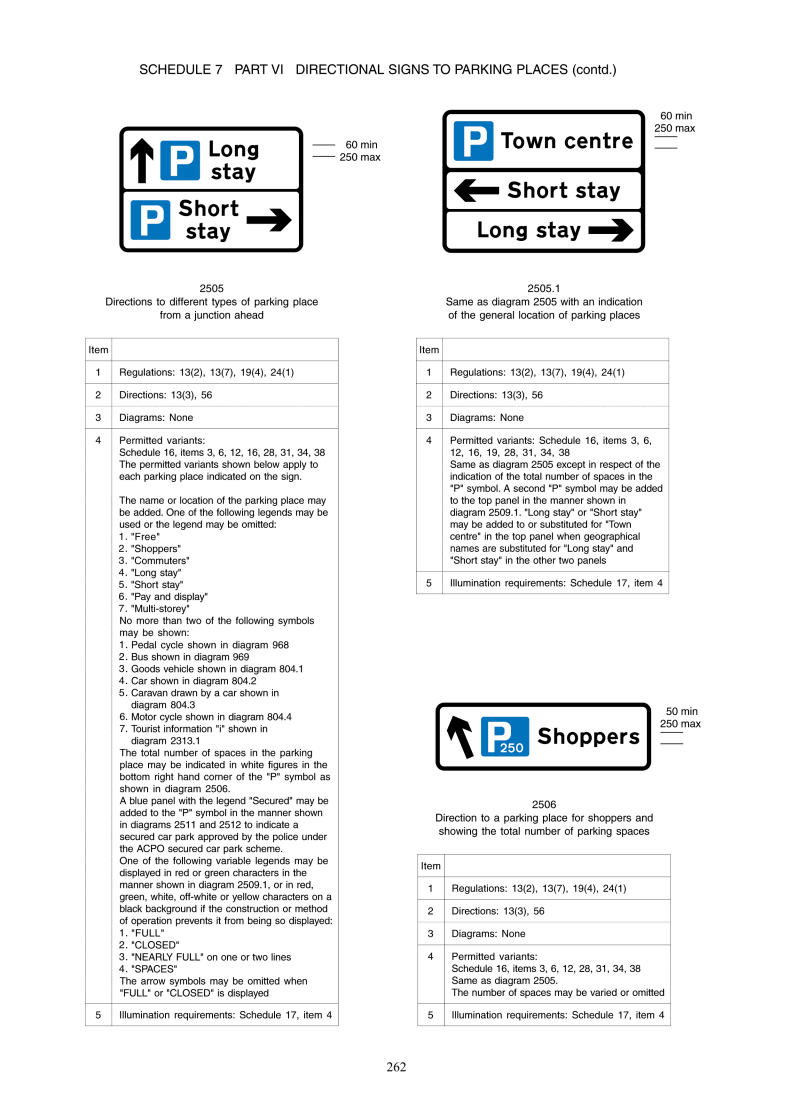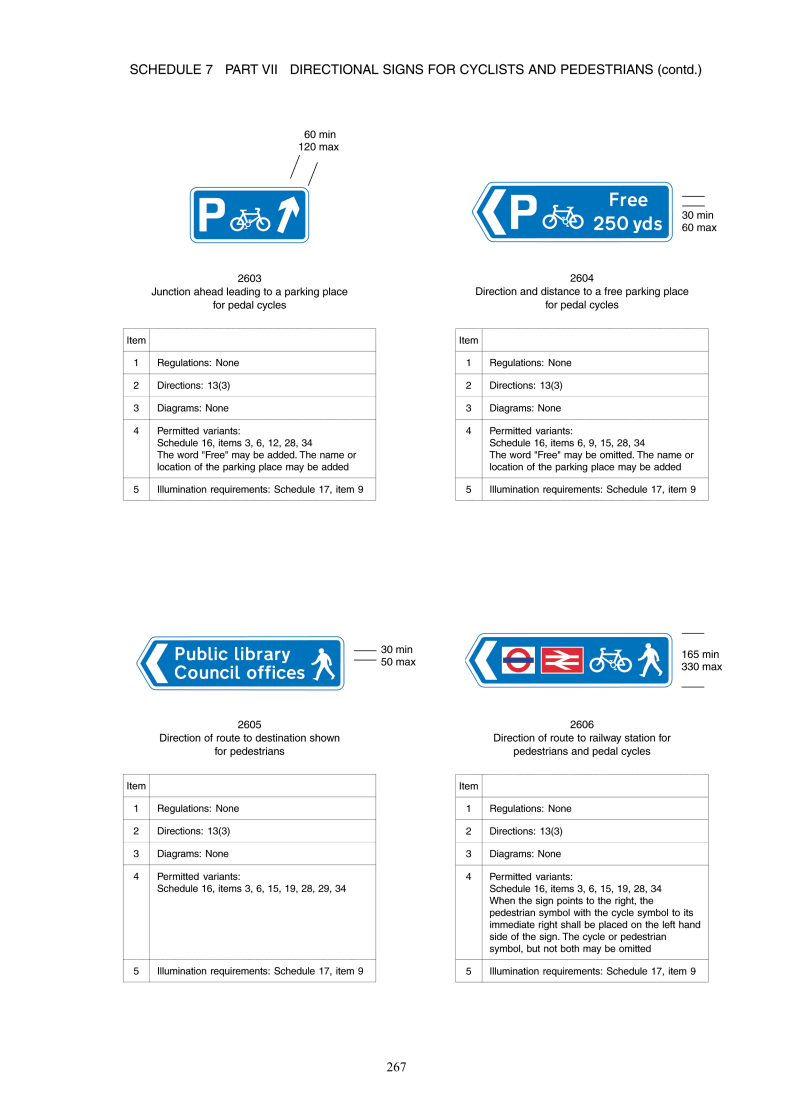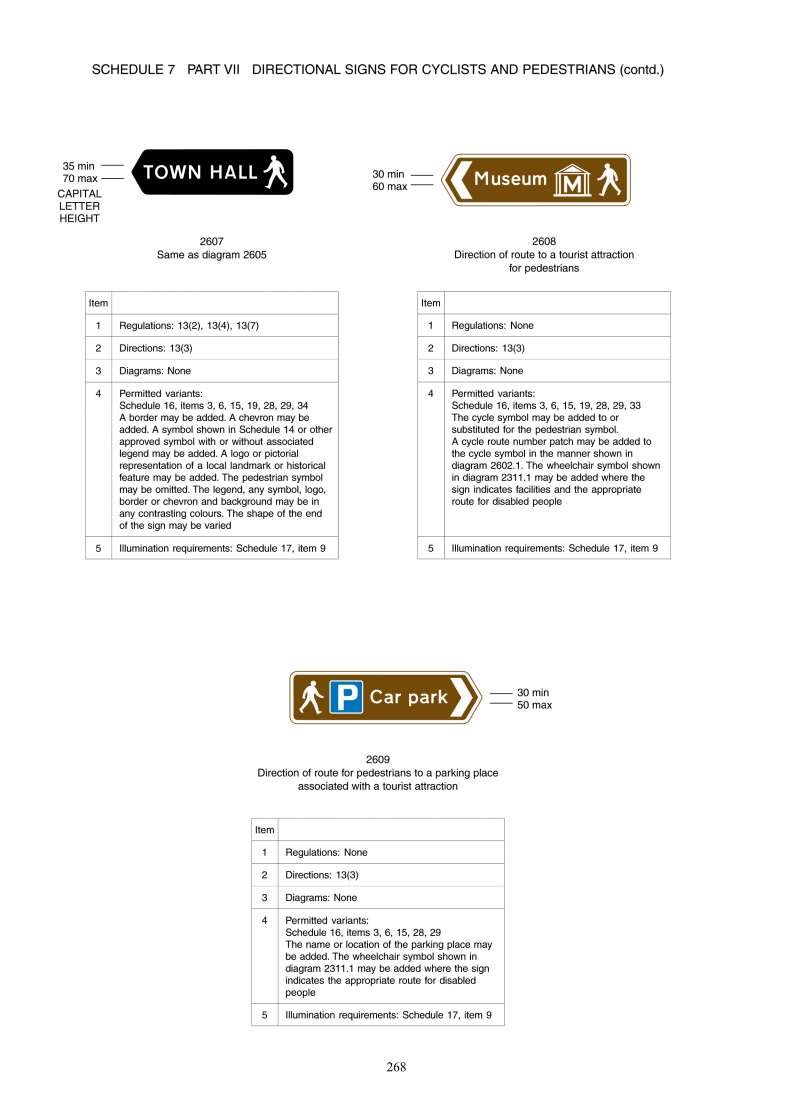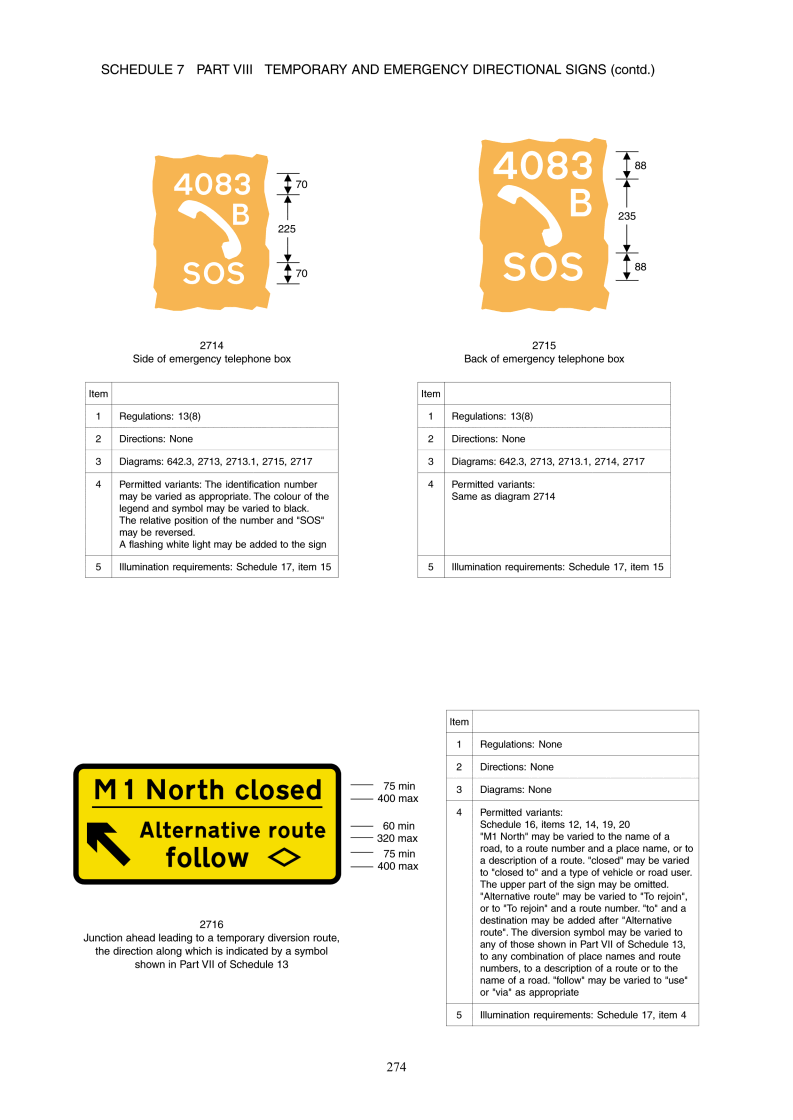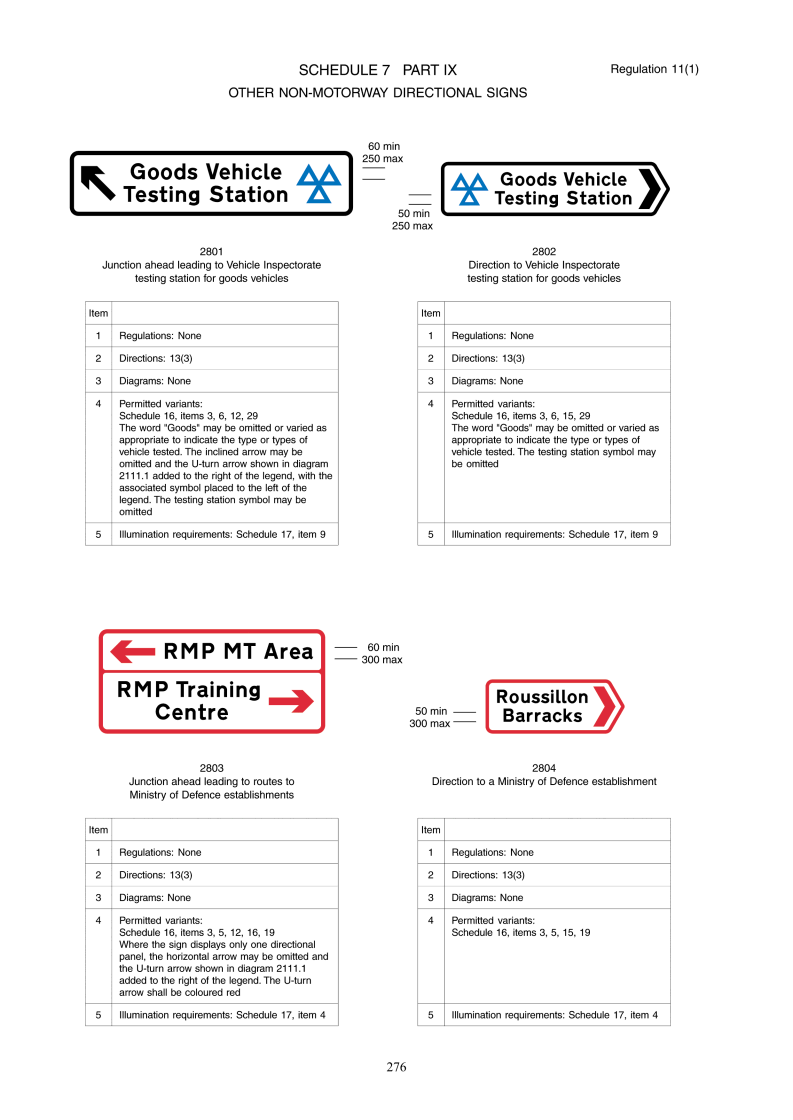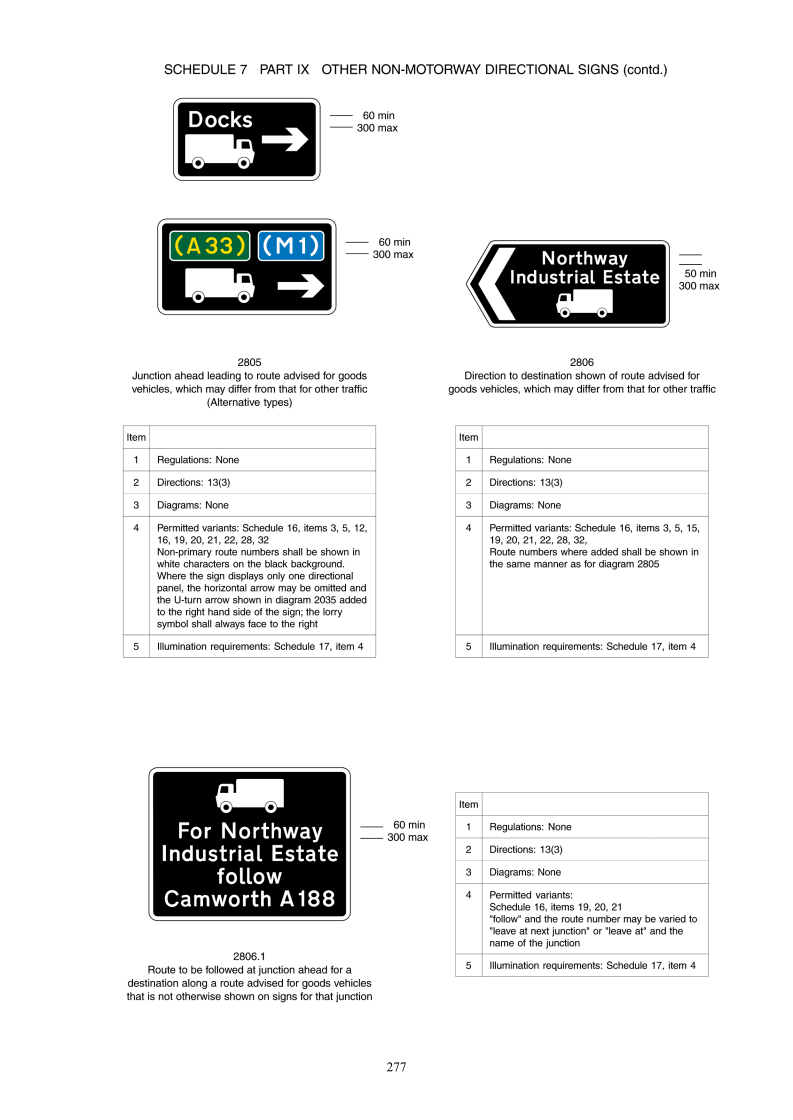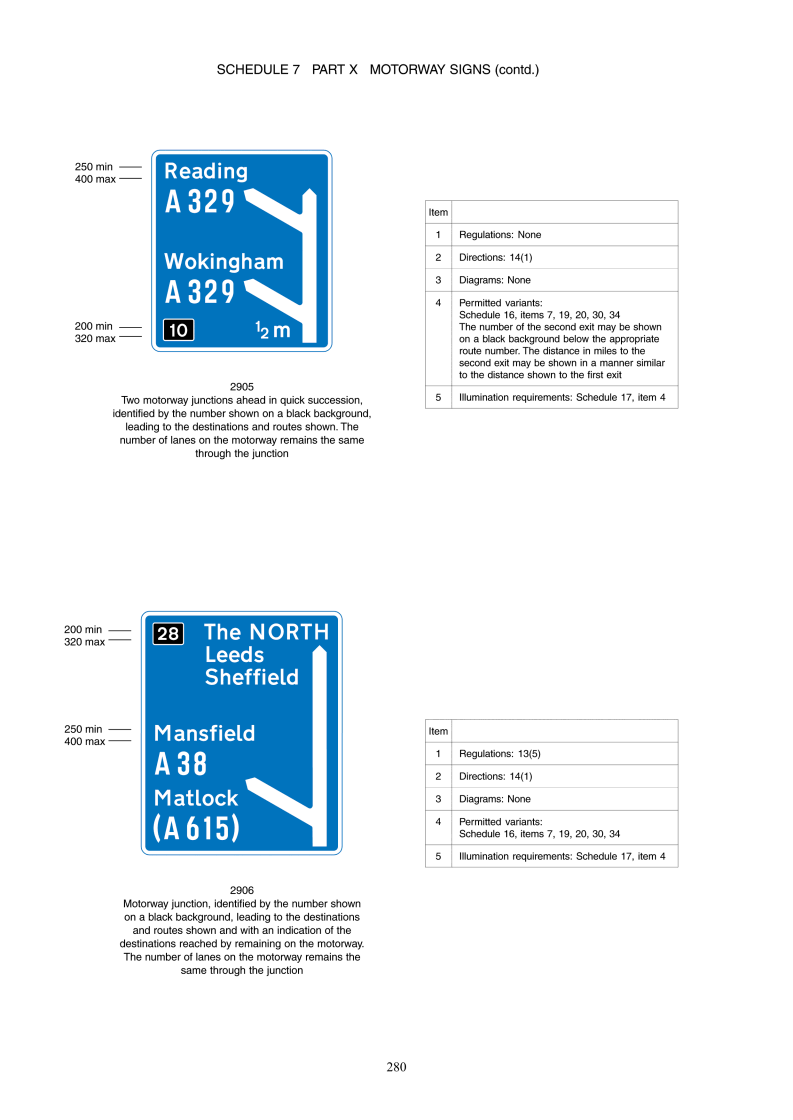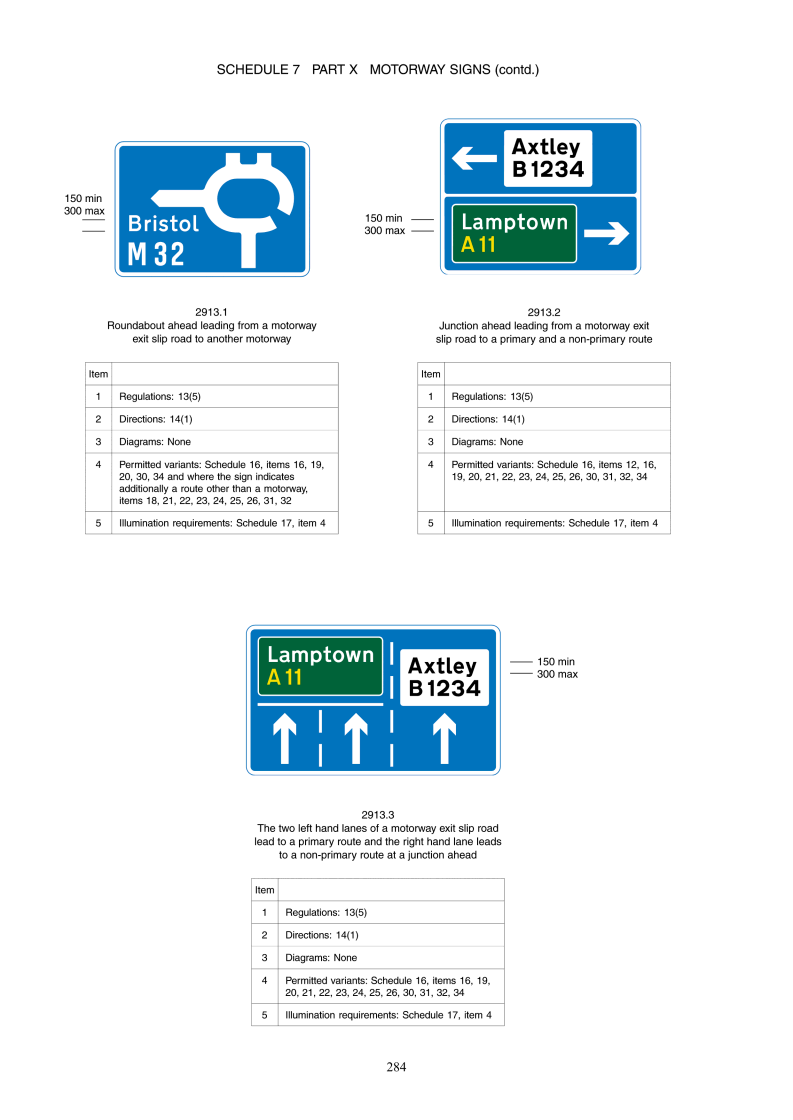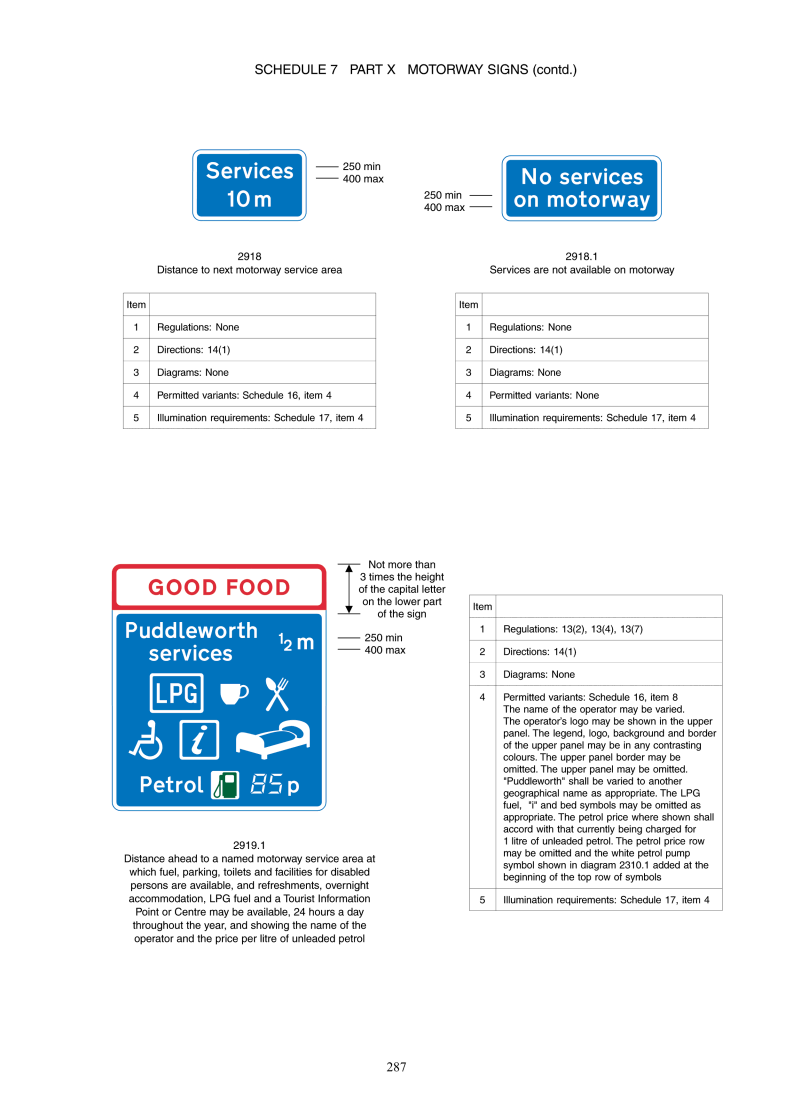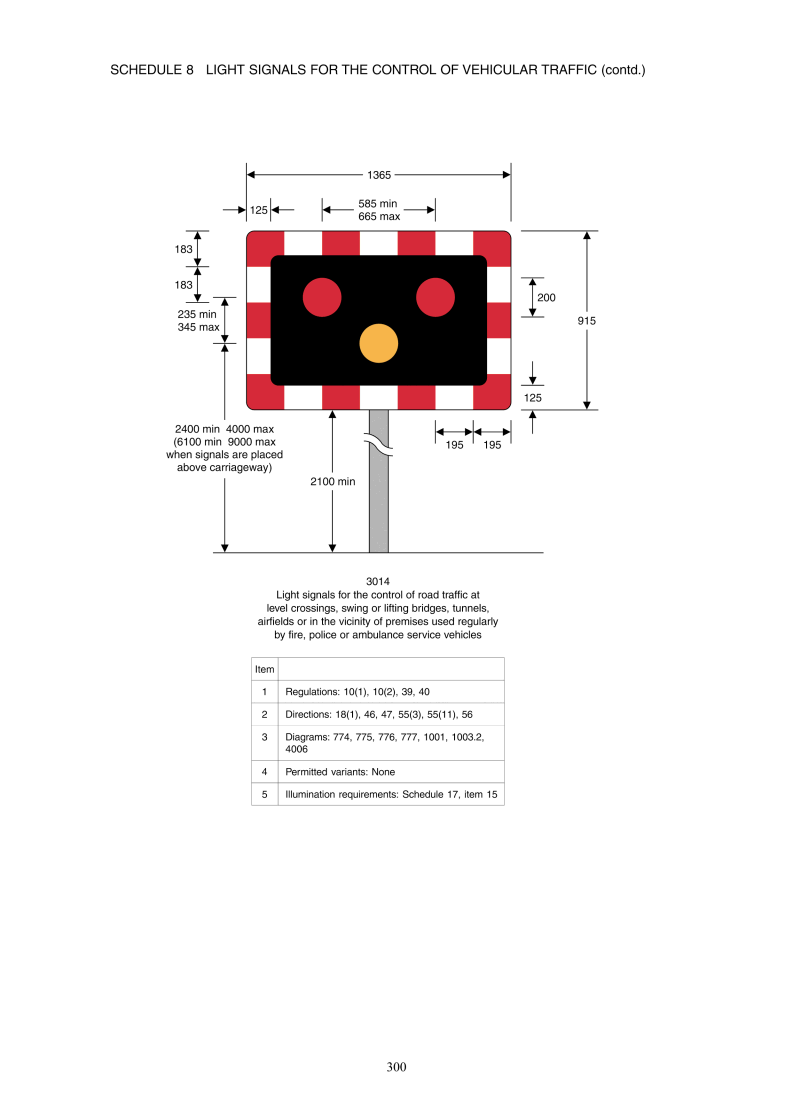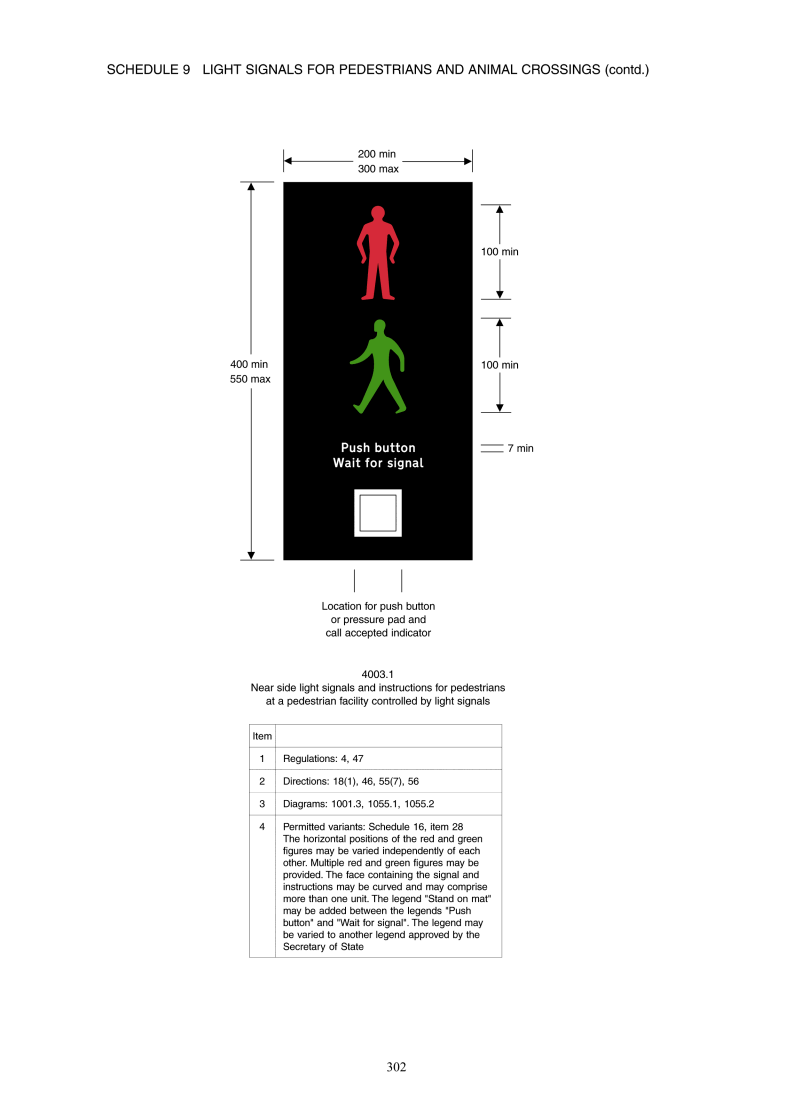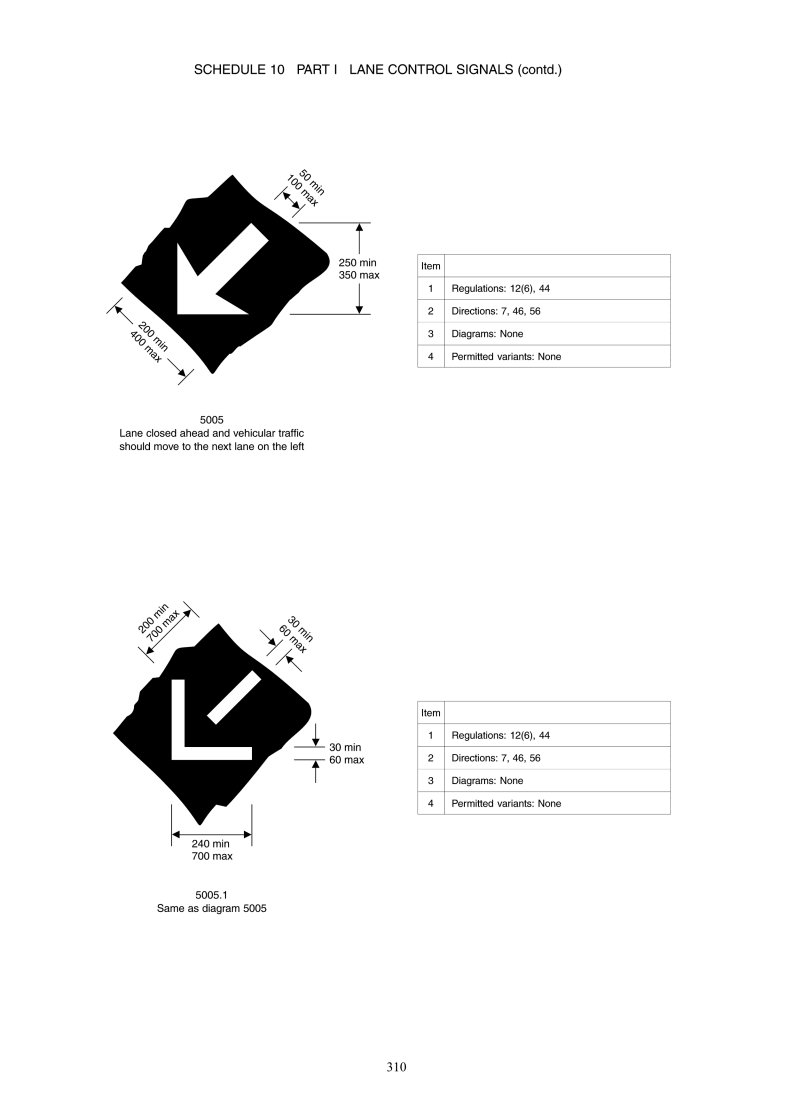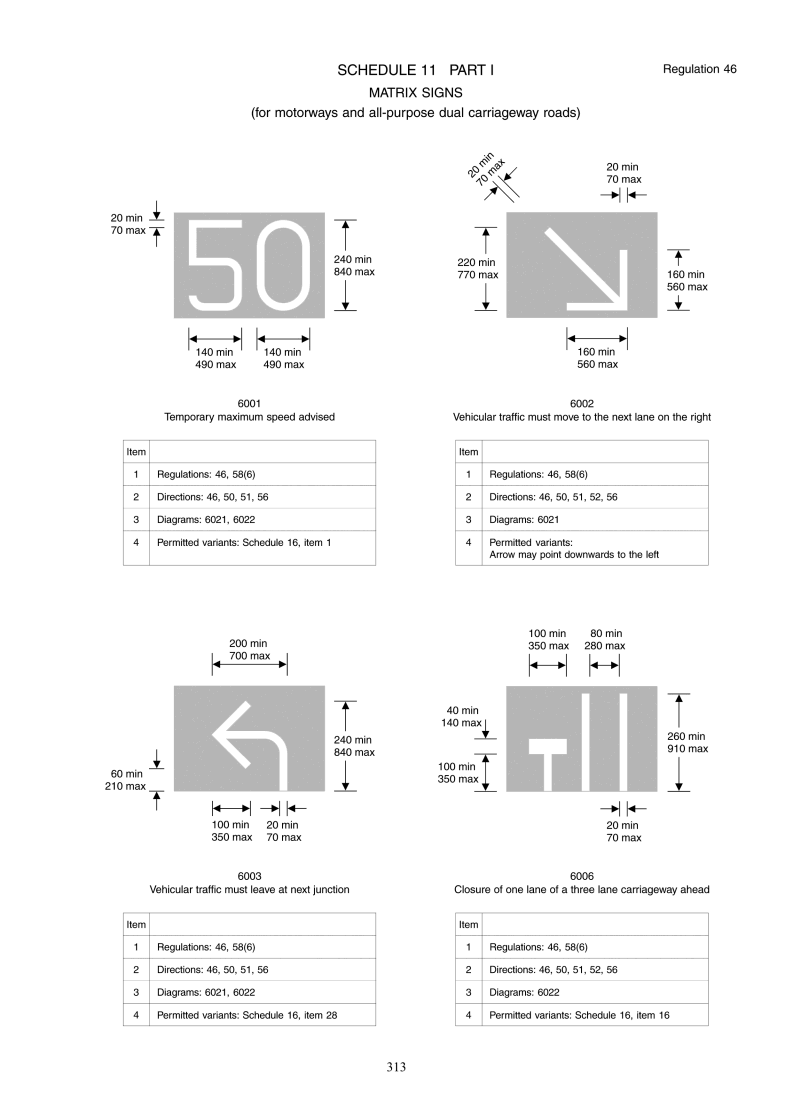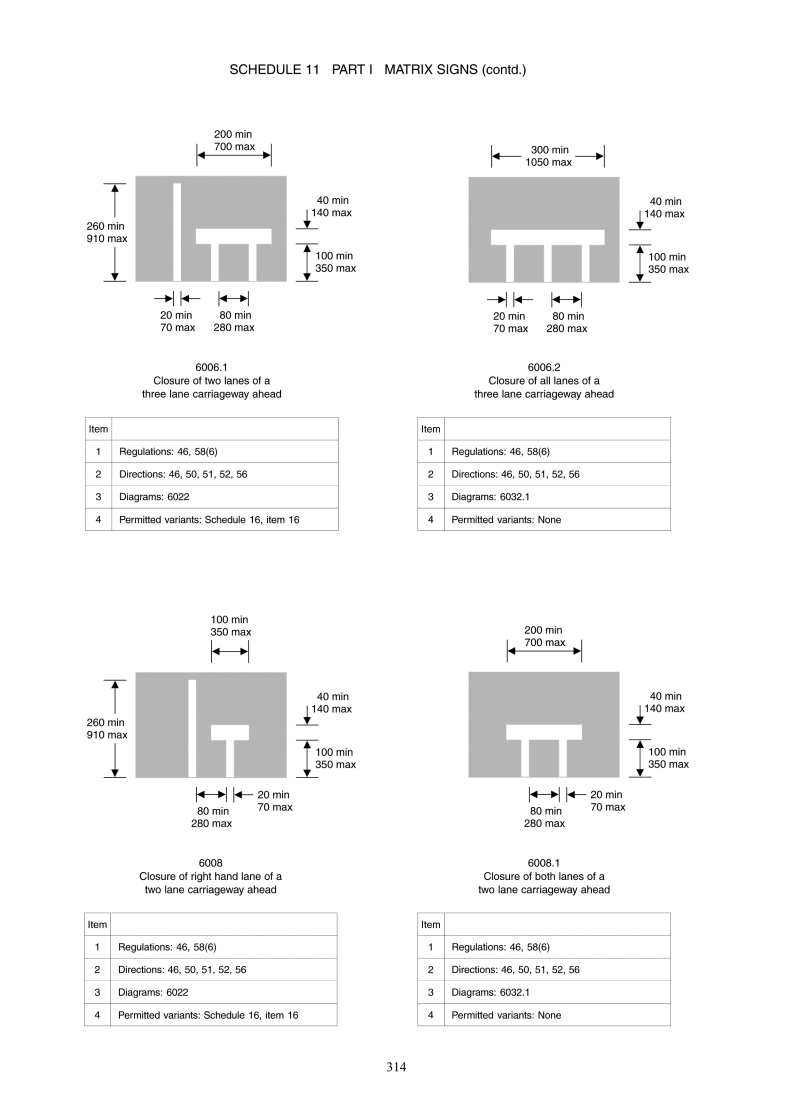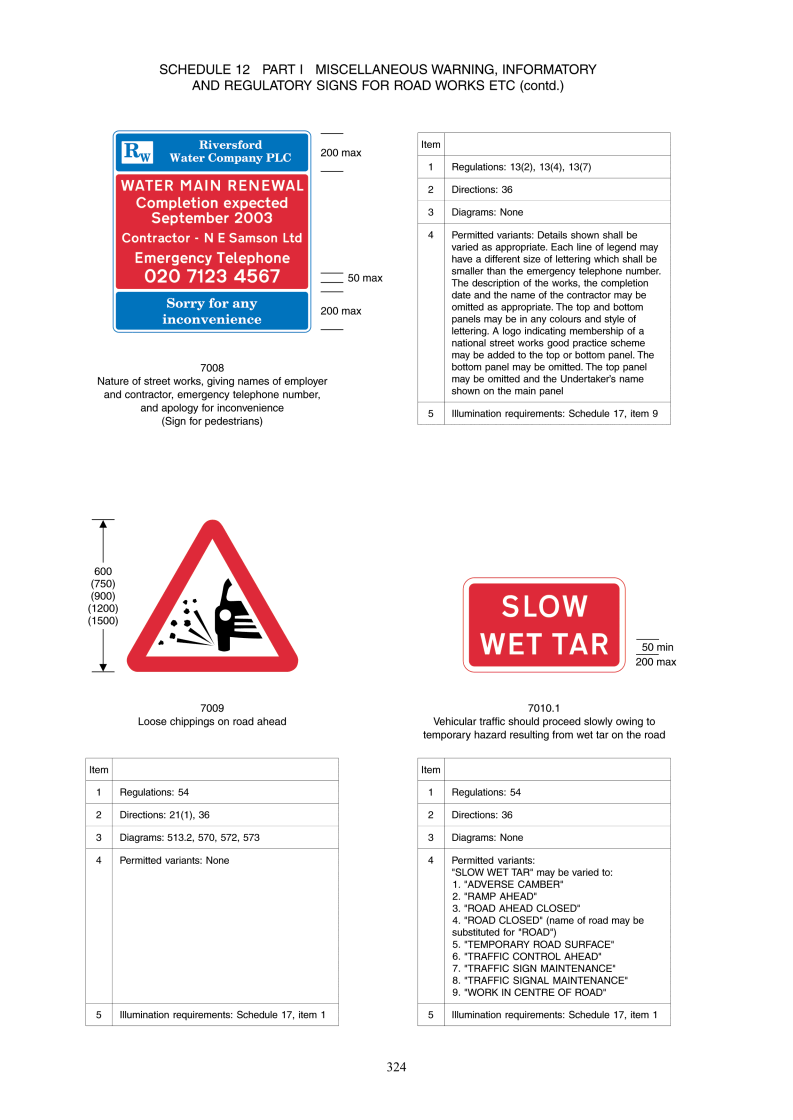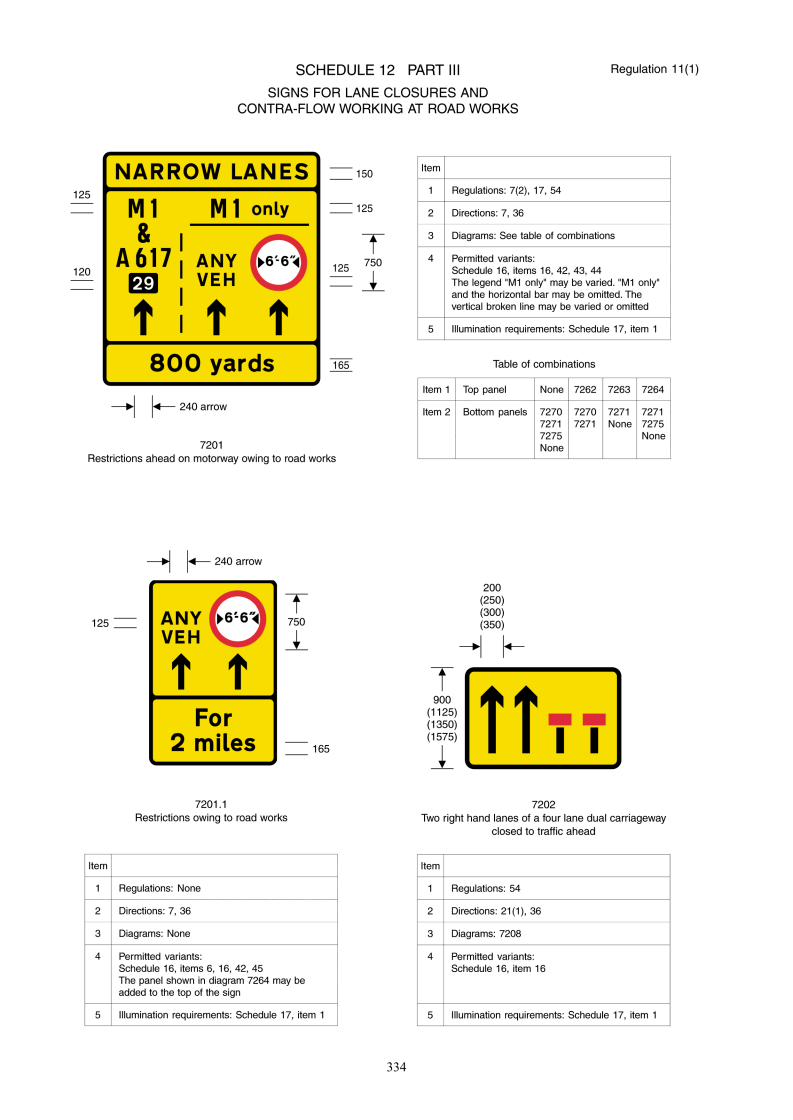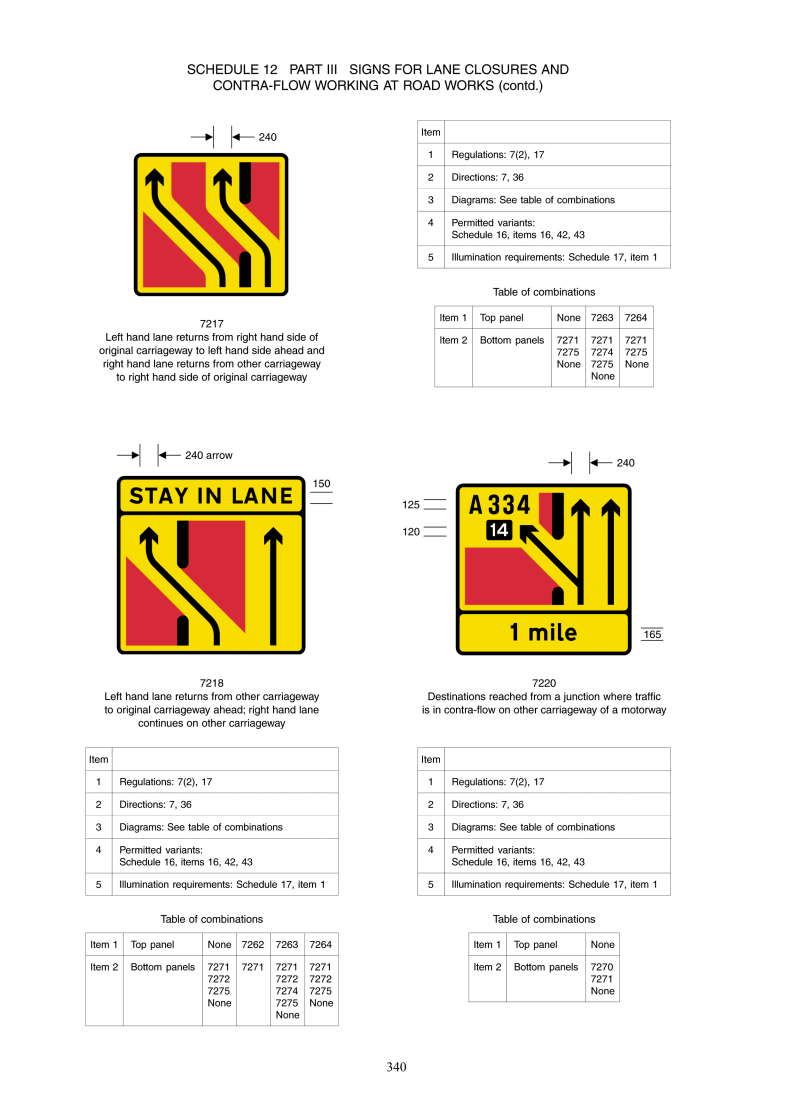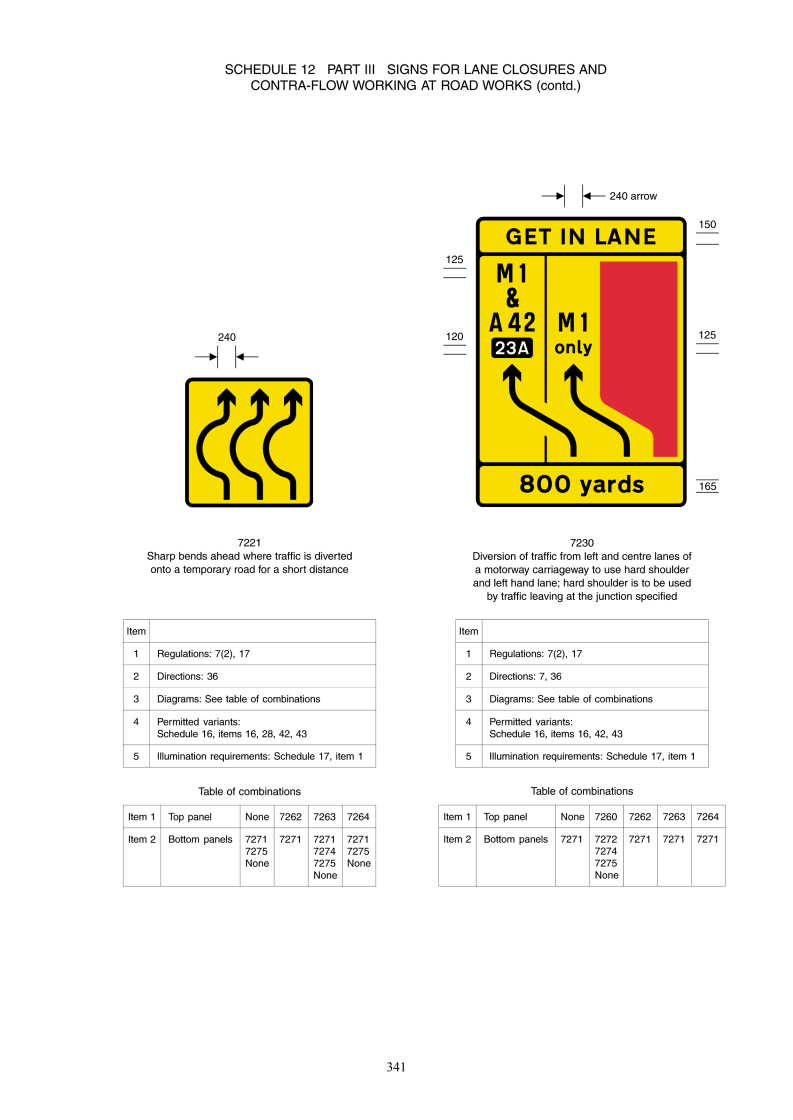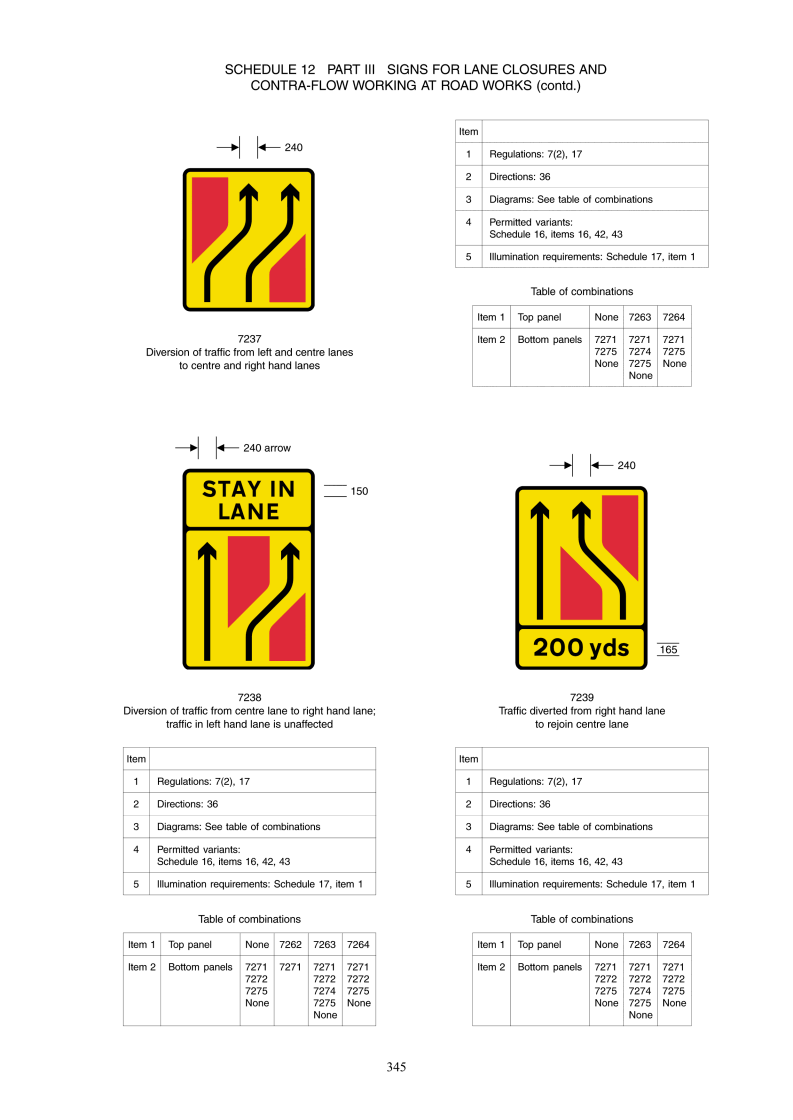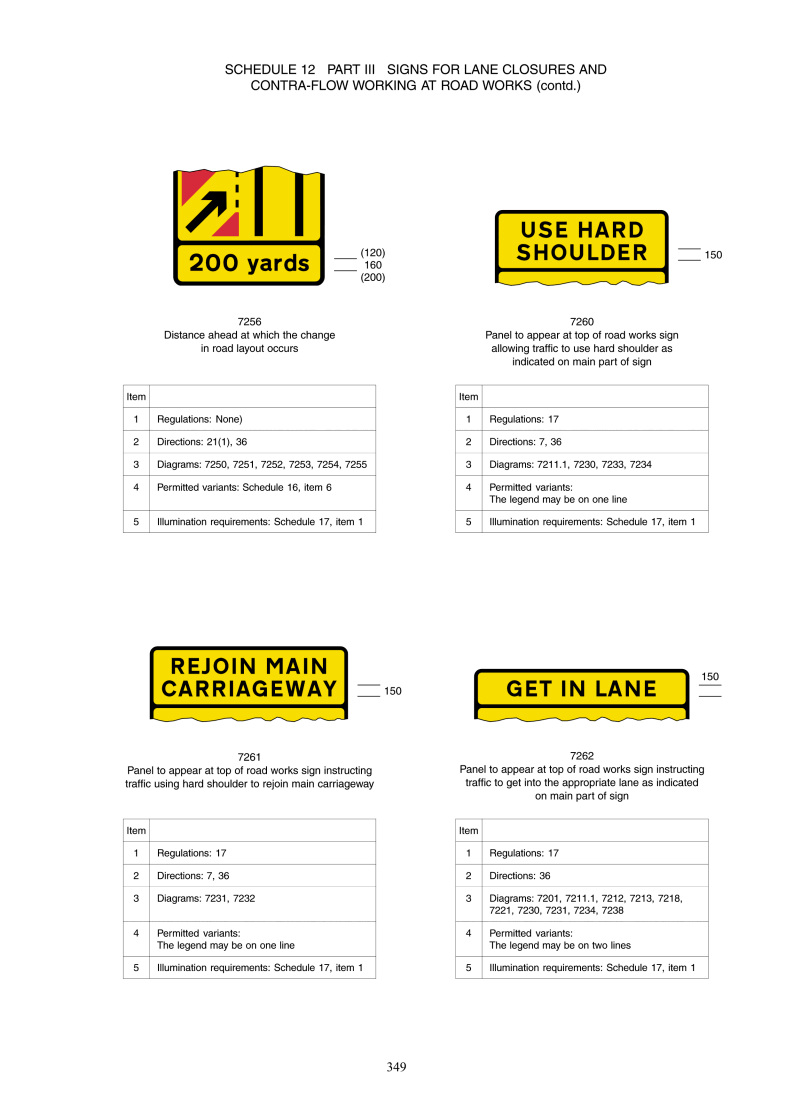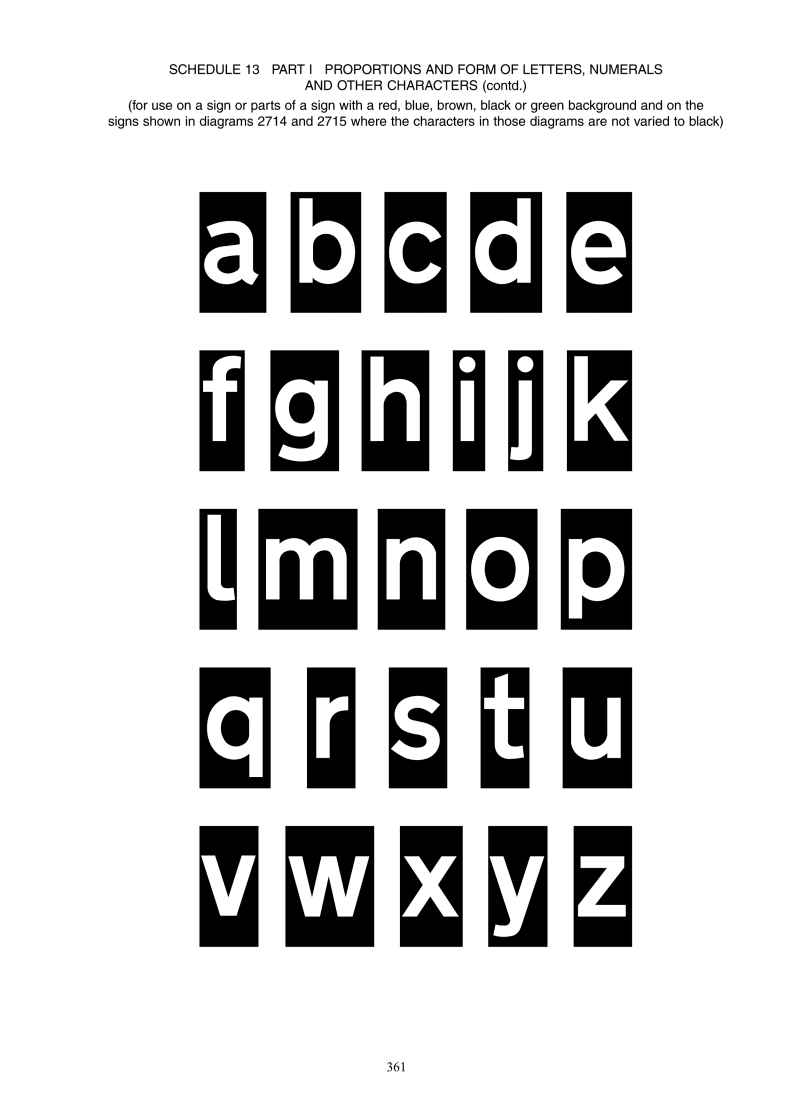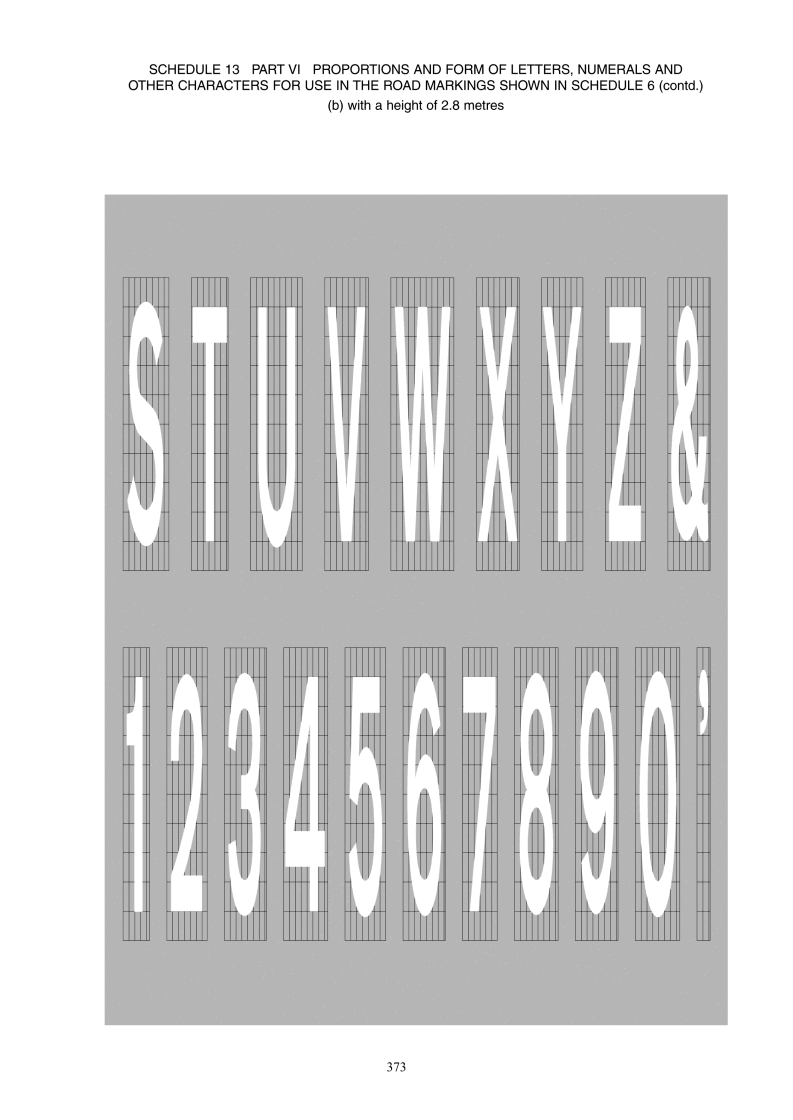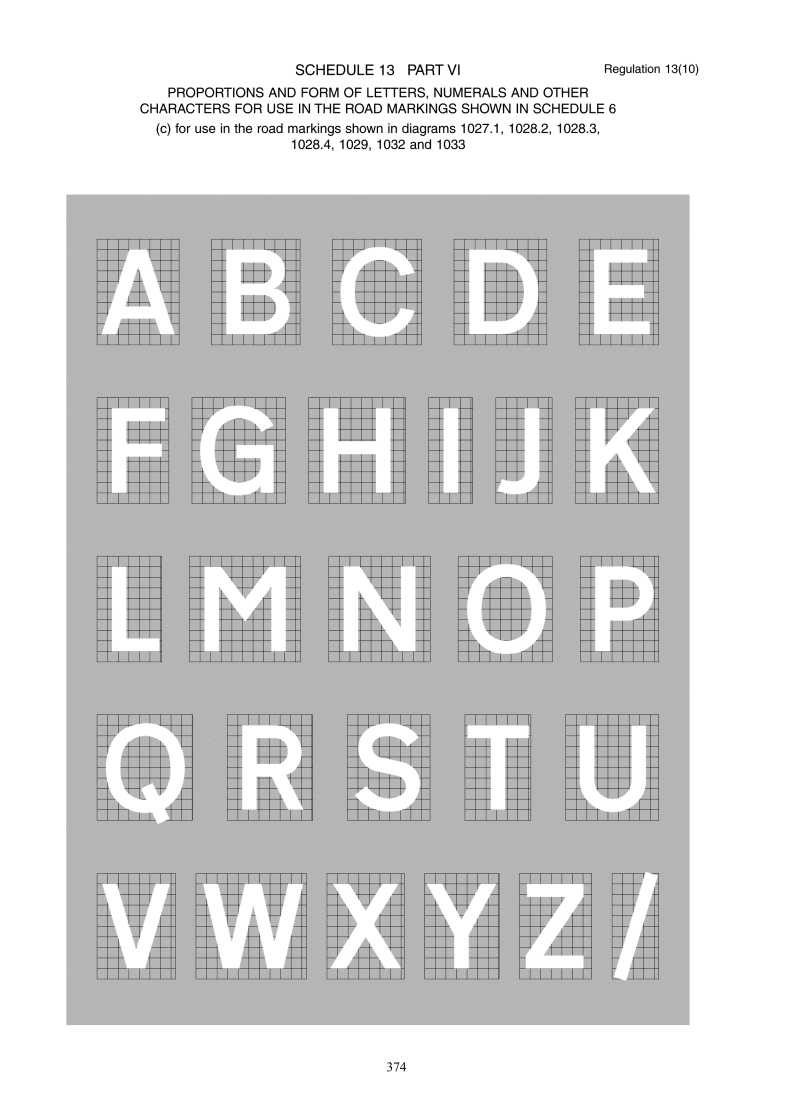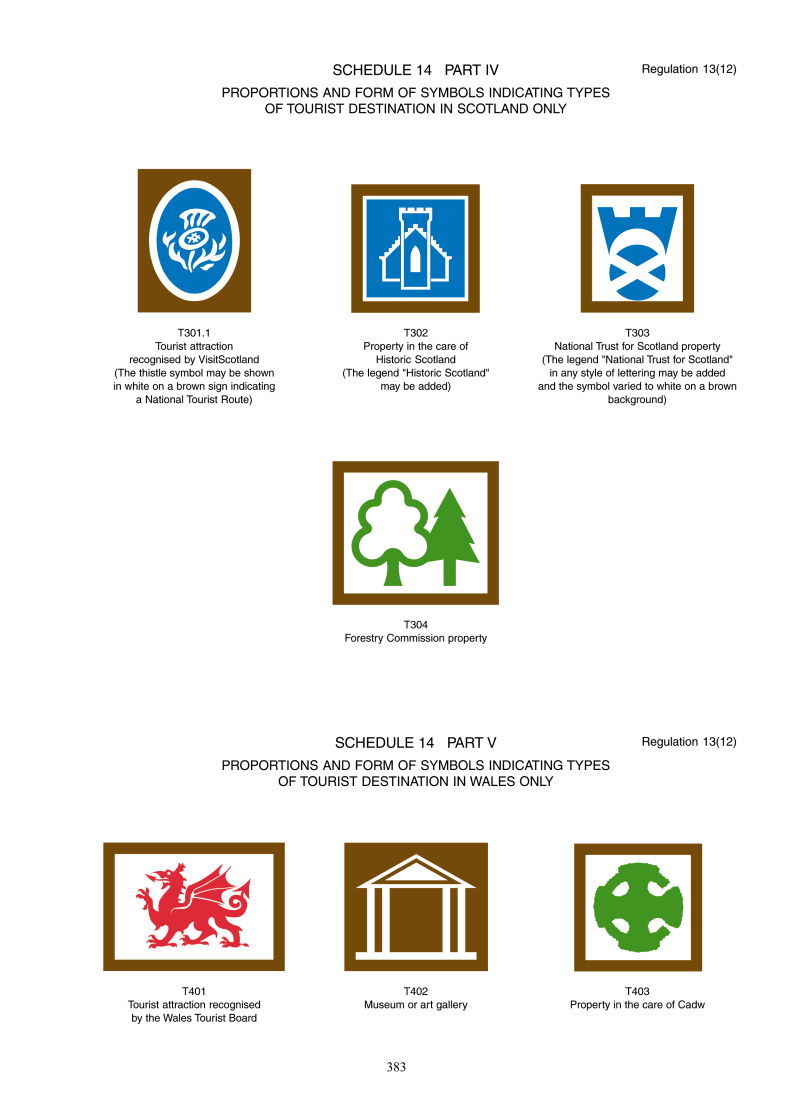- Latest available (Revised)
- Original (As made)
The Traffic Signs Regulations and General Directions 2002
You are here:
- UK Statutory Instruments
- 2002 No. 3113
- Schedules only
More Resources
Status:
This is the original version (as it was originally made).
SCHEDULE 1WARNING SIGNS
SCHEDULE 2REGULATORY SIGNS
SCHEDULE 3SIGNS FOR RAILWAY AND TRAMWAY LEVEL CROSSINGS
SCHEDULE 4MISCELLANEOUS INFORMATORY SIGNS
SCHEDULE 5SIGNS FOR BUS, TRAM AND PEDAL CYCLE FACILITIES
SCHEDULE 6ROAD MARKINGS
SCHEDULE 7DIRECTIONAL SIGNS
PART IPRIMARY ROUTE DIRECTIONAL SIGNS
PART IINON-PRIMARY ROUTE DIRECTIONAL SIGNS
PART IIITOURIST DESTINATION SIGNS
PART IVSIGNS FOR SERVICES AND TOURIST FACILITIES
PART VBOUNDARY SIGNS
PART VIDIRECTIONAL SIGNS TO PARKING PLACE
PART VIIDIRECTIONAL SIGNS FOR CYCLISTS AND PEDESTRIANS
PART VIIITEMPORARY AND EMERGENCY DIRECTIONAL SIGNS
PART IXOTHER NON-MOTORWAY DIRECTIONAL SIGNS
PART XMOTORWAY SIGNS
SCHEDULE 8LIGHT SIGNALS FOR THE CONTROL OF VEHICULAR TRAFFIC
SCHEDULE 9LIGHT SIGNALS FOR PEDESTRIANS AND ANIMAL CROSSINGS
SCHEDULE 10LANE CONTROL SIGNALS AND SIGNS
PART ILANE CONTROL SIGNALS
PART IILANE CONTROL SIGNALS
SCHEDULE 11MATRIX SIGNS AND LIGHT SIGNALS
PART IMATRIX SIGNS
PART IILIGHT SIGNALS
SCHEDULE 12ROAD WORKS SIGNS ETC
PART IMISCELLANEOUS WARNING, INFORMATORY AND REGULATORY SIGNS FOR ROAD WORKS ETC
PART IIROAD WORKS DELINEATORS AND BARRIERS
PART IIISIGNS FOR LANE CLOSURES AND CONTRA-FLOW WORKING AT ROAD WORKS
PART IVSIGNS FOR ROAD WORKS ENTRANCES AND EXITS
PART VSIGNS MOUNTED ON ROAD WORKS VEHICLES
SCHEDULE 13PROPORTIONS AND FORM OF LETTERS, NUMERALS AND OTHER CHARACTERS
PART IPROPORTIONS AND FORM OF LETTERS, NUMERALS AND OTHER CHARACTERS
PART IIPROPORTIONS AND FORM OF LETTERS, NUMERALS AND OTHER CHARACTERS
PART IIIPROPORTIONS AND FORM OF LETTERS, NUMERALS AND OTHER CHARACTERS
PART IVPROPORTIONS AND FORM OF LETTERS, NUMERALS AND OTHER CHARACTERS
PART VPROPORTIONS AND FORM OF LETTERS, NUMERALS AND OTHER CHARACTERS FOR USE ON VARIABLE MESSAGE SIGNS
PART VIPROPORTIONS AND FORM OF LETTERS, NUMERALS AND OTHER CHARACTERS FOR USE IN THE ROAD MARKINGS SHOWN IN SCHEDULE 6
PART VIIPROPORTIONS AND FORM OF LETTERS, NUMERALS AND OTHER CHARACTERS
SCHEDULE 14PROPORTIONS AND FORM OF SYMBOLS INDICATING TYPES OF TOURIST DESTINATION
PART IPROPORTIONS AND FORM OF SYMBOLS INDICATING TYPES OF TOURIST DESTINATION IN ENGLAND, SCOTLAND AND WALES
PART IIPROPORTIONS AND FORM OF SYMBOLS INDICATING TYPES OF TOURIST DESTINATION IN ENGLAND AND WALES
PART IIIPROPORTIONS AND FORM OF SYMBOLS INDICATING TYPES OF TOURIST DESTINATION IN ENGLAND ONLY
PART IVPROPORTIONS AND FORM OF SYMBOLS INDICATING TYPES OF TOURIST DESTINATION IN SCOTLAND ONLY
Regulation 58
SCHEDULE 15LEGENDS FOR USE ON VARIABLE MESSAGE SIGNS
PART IPRELIMINARY
1.—(1) In a legend prescribed by this Schedule the number of a junction shall be shown in the form of the letter “J” followed by the number of the junction.
(2) Where this Schedule provides for a route number to be displayed on a sign, a compass point (“NORTH”, “SOUTH”, “EAST” or “WEST”) or an abbreviated compass point (“N”, “S”, “E”, “W”, “NW”, “NE”, “SW” or “SE”) may be added to the route number.
(3) Where any part of a legend prescribed by this Schedule is shown in square brackets, the brackets shall not be displayed on a sign.
(4) Different legends or different parts of the same legend displayed on a sign in accordance with this Schedule may be separated by a dash.
PART IISIGNS AUTOMATICALLY ACTIVATED BY VEHICULAR TRAFFIC
2. One of the following legends may be displayed on a sign which is activated by a particular type of vehicle approaching the equipment which controls the sign—
(a)“OVERHEIGHT VEHICLE DIVERT” with—
(i)an arrow;
(ii)“USE” and a route number; or
(iii)“FOLLOW” and a symbol shown in Part VII of Schedule 13;
(b)“OVERHEIGHT VEHICLE TURN BACK”;
(c)“HIGH VEHICLE USE MIDDLE OF ROAD”; or
(d)“ONCOMING VEHICLE IN MIDDLE OF ROAD”.
PART IIILEGENDS GIVING WARNINGS OF ADVERSE WEATHER OR OTHER TEMPORARY HAZARDS OR INCIDENTS
3.—(1) A legend specified in sub-paragraph (2) may only be used in conjunction with—
(a)a legend specified in Part IV;
(b)a legend specified in Part V; or
(c)a combination of a legend specified in Part IV and a legend specified in Part V.
(2) The legends specified in this sub-paragraph are—
(a)“ACCIDENT”;
(b)“ANIMALS”;
(c)a route number, a junction number or “EXIT” and “CLOSED”;
(d)“CONGESTION”;
(e)“DEBRIS”;
(f)“DELAYS”;
(g)“DIVERSION”;
(h)“EXIT CLOSED”;
(i)“FLOODS”;
(j)“FOG”;
(k)“FOG PATCHES”;
(l)“INCIDENT”;
(m)“LANE CLOSURE”;
(n)“LANE[S]” followed by a number or numbers and “CLOSED”;
(o)“LARGE LOAD”;
(p)“LONG DELAYS”;
(q)“MOBILE WORKS”;
(r)“MOTORWAY CLOSED”;
(s)“NO PHONES”;
(t)“OBSTRUCTION”;
(u)“PEDESTRIANS”;
(v)“QUEUE”;
(w)“ROAD CLOSED”;
(x)“ROAD WORKS”;
(y)“SKID RISK”;
(z)“SLIP ROAD CLOSED”;
(aa)“SMOKE”;
(bb)“SNOW”;
(cc)“SNOW PLOUGH”;
(dd)“SPRAY”;
(ee)“STRANDED VEHICLE”;
(ff)“[STRONG] WINDS”;
(gg)“[The name of a tunnel] TUNNEL CLOSED”;
(hh)“WEIGHT CHECK”;
(ii)“WORKFORCE”.
(3) The following legends may be displayed on their own or in conjunction with another legend as mentioned in sub-paragraph (1)—
(a)“[The name of a bridge] BRIDGE CLOSED”;
(b)“BUS LANE CLOSED”;
(c)“GRITTING IN PROGRESS”;
(d)“NEXT SERVICE AREA CLOSED”;
(e)“ONCOMING VEHICLE”;
(f)“SETTING OUT ROAD WORKS”;
(g)“SLOW MOVING LARGE LOAD”.
(4) In sub-paragraphs (2) and (3) square brackets are used to indicate things which may be omitted.
PART IVLEGENDS INDICATING LOCATION OF TEMPORARY HAZARD OR INCIDENT
4. One of the following legends may be used only in conjunction (either on its own or in combination with a legend specified in Part V) with a legend specified in Part III—
(a)a route number;
(b)“ON [name of bridge] BRIDGE” or “ON BRIDGE”;
(c)“AT” together with—
(i)a place name,
(ii)the name of a bridge or tunnel,
(iii)a junction name or number or a junction number and “EXIT”, or
(iv)“NEXT JCT” or “TOLL”;
(d)“AFTER” together with—
(i)a place name,
(ii)the name of a bridge or tunnel,
(iii)“BRIDGE” or “TUNNEL”,
(iv)a junction name or number, or
(v)“NEXT JCT”;
(e)a number and “MILES”;
(f)“AHEAD” preceded by a legend specified in paragraph 3(2)(v) or (w) only;
(g)“FOR” together with a number and “MILES”;
(h)“IN ROAD”;
(i)a junction number;
(j)a junction number “TO” and another junction number;
(k)“ON SLIP ROAD”;
(l)“TO” and a route number.
PART VADDITIONAL INFORMATION
5.—(1) A legend specified in sub-paragraph (2) may be used only in conjunction with a legend specified in Part III or a combination of a legend specified in Part III and a legend specified in Part IV.
(2) The legends referred to in sub-paragraph (1) are—
(a)a number and “HR DELAYS”;
(b)[“ALL TRAFFIC”] [“CARS”] [“CARAVANS”] [“HGV'S”] [“HIGH SIDED VEHS”] [“AND”] [“M'CYCLES”] “USE” and a route number or “BUS LANE” or “HARD SHOULDER”;
(c)[“ALL TRAFFIC”] [“CARS”] [“CARAVANS”] [“HGV'S”] [“HIGH SIDED VEHS”] [“AND”] [“M'CYCLES”] “FOLLOW” and a symbol shown in Part VII of Schedule 13 or a place name;
(d)[“ALL TRAFFIC”] [“CARS”] [“CARAVANS”] [“HGV'S”] [“HIGH SIDED VEHS”] [“AND”] [“M'CYCLES”] and “LEAVE AT NEXT JCT”, “LEAVE AT” and a junction name or number;
(e)“[ALTERNATIVE ROUTE] FOLLOW” and a symbol shown in Part VII of Schedule 13 or a place name;
(f)“[ALTERNATIVE ROUTE] USE” and a route number;
(g)“AT” and a place name, the name of a bridge or tunnel, “BRIDGE” or “TUNNEL”, or a junction name or number, or “NEXT JCT”;
(h)“AVOID LANE CHANGES”;
(i)“DO NOT USE HARD SHOULDER”;
(j)“FOR” and a place name “USE” and a route number;
(k)“FOR” and a place name “FOLLOW” and a symbol shown in Part VII of Schedule 13 or another place name;
(l)“HGV'S LEAVE MOTORWAY”;
(m)“LEAVE AT NEXT JCT”;
(n)“LEAVE AT” and a junction name or number;
(o)“REJOIN MAIN CARRIAGEWAY”;
(p)“SLOW”;
(q)“SLOW DOWN”.
(3) In the legends specified in paragraphs (b), (c) and (d) of sub-paragraph (2), one or more of the words in square brackets may be included as appropriate.
(4) In the legends specified in paragraphs (e) and (f) of sub-paragraph (2) anything in square brackets may be omitted.
(5) In the legends specified in paragraphs (b) and (i) of sub-paragraph (2) “HARDSHOULDER” may be substituted for “HARD SHOULDER”.
PART VIOTHER LEGENDS
6.—(1) The following legends may also be displayed on a variable message sign—
(a)“SIGNAL[S] UNDER TEST”;
(b)“SIGNAL TESTS FOR” and a number of “MILES”;
(c)“SIGNAL TESTS ON SLIP ROAD”;
(d)“SIGN[S] UNDER TEST”;
(e)“END OF SIGNAL TESTS”;
(f)“END OF SIGN TESTS”.
(2) The legends specified in paragraphs (a) to (d) of sub-paragraph (1) may be displayed with a pattern which has no particular meaning but which is designed to test the functioning of the variable message sign on which it is displayed.
(3) In the legends specified in paragraphs (a) and (d) of sub-paragraph (1) the letter shown in square brackets may be omitted.
Regulation 17(1)
SCHEDULE 16PERMITTED VARIANTS
| (1) | (2) | (3) |
|---|---|---|
| Item | Diagram numbers | Permitted variants |
| 1. | 513.2, 523.1, 524.1, 530, 531.1, 532.2, 532.3, 629, 629A, 629.1, 629.2, 629.2A, 670, 672, 673, 675 (in respect of the upper panel of the sign), 780A, 780.1A (in respect of height), 780.2A, 818.3 (other than in respect of distance), 6001, 7275, 7283, 7283.1, 7284, 7284.1, 7290 (in respect of speed limit), 7292, 7294 | Numerals may be varied but (with the exception of one decimal place of a metre indicating a height, width or length) no fractions or decimal places shall be used. |
| 2. | 629.1 | Metric units to one decimal place of a metre may be substituted for imperial units when the sign is placed in combination with another sign shown in diagram 629.1 which has not been so varied. |
| 3. | 518, 519, 530.1, 543.1, 546, 547.1, 547.2, 547.4, 547.7, 547.8, 563, 563.1, 773, 883, 950.1, 2001, 2002, 2003, 2004, 2005, 2005.1, 2006, 2007, 2008, 2009, 2022, 2023, 2024, 2025, 2026, 2027, 2027.1, 2028, 2029, 2033, 2035, 2101, 2102, 2102.1, 2104, 2105.1, 2108, 2109, 2110, 2111, 2112, 2113, 2113.1, 2118, 2119, 2120, 2121, 2122, 2126.1, 2127, 2131, 2132, 2133, 2134, 2135, 2136, 2139, 2140, 2141, 2205, 2213, 2214, 2215, 2216, 2218, 2308.1, 2322, 2323, 2324, 2325, 2326, 2327, 2328, 2329, 2504, 2505, 2505.1, 2506, 2507, 2509.1, 2510, 2511, 2512, 2513, 2601.1, 2601.2, 2603, 2605, 2606, 2607, 2608, 2609, 2610, 2610.2, 2701, 2701.1, 2705, 2706, 2707, 2801, 2802, 2803, 2804, 2805, 2806, 2925, 2929+, 7001.1 +When used on a motorway exit slip road. | An indication of distance may be shown in accordance with item 5 or 6. |
| 4. | 2911, 2912, 2917, 2918 | Numerals indicating distance may be varied with distances being expressed in miles to the nearest mile. |
| 5. | 527, 583.1, 584.1, 2001, 2002, 2003, 2004, 2005, 2005.1, 2006, 2007, 2008, 2009, 2022, 2023, 2024, 2025, 2026, 2027, 2027.1, 2028, 2029, 2030, 2030.1, 2033, 2035, 2101, 2102, 2102.1, 2103, 2104, 2105.1, 2106.1, 2107, 2108, 2109, 2110, 2111, 2111.1, 2112, 2113, 2113.1, 2118, 2119, 2120, 2121, 2122, 2125, 2126, 2126.1, 2127, 2128, 2131, 2132, 2141, 2209, 2213, 2214, 2215, 2218, 2308.1, 2309.1, 2328, 2329, 2601.1, 2601.2, 2602.1, 2705, 2706, 2707, 2803, 2804, 2805, 2806, 2925, 2926, 2929+ +When used on a motorway exit slip road. | Numerals indicating distance may be varied with distances being expressed in miles except that the fractions ¾, ½ and ¼ may be used for distances of less than 3 miles. |
| 6. | 502, 503, 518, 519, 530.1, 543.1, 546, 547.1, 547.2, 547.3, 547.4, 547.7, 547.8, 548.1, 553.2, 554.3, 556.2, 557.2, 557.3, 557.4, 558.2, 563, 563.1, 570, 572, 573, 615.1, 773, 780.1A (in respect of distance), 811.1, 817.2, 818.1 (in respect of distances not exceeding 2 miles), 818.2 and 818.3 (in respect of distance), 820.1, 821, 876, 883, 950.1, 2010.1, 2123, 2133, 2134, 2135, 2136, 2139, 2140, 2201, 2202, 2203, 2204, 2205, 2216, 2301, 2302, 2303, 2304, 2305, 2306, 2307, 2322, 2323, 2324, 2325, 2326, 2327, 2501, 2502, 2503, 2504, 2505, 2505.1, 2506, 2507, 2508, 2509.1, 2510, 2511, 2512, 2513, 2603, 2604, 2605, 2606, 2607, 2608, 2609, 2610, 2610.1, 2610.2*, 2701, 2701.1, 2713.1, 2801, 2802, 5014, 7001.1, 7004, 7012**, 7015**, 7030, 7201.1, 7208, 7209, 7256, 7306, 7307 *Distances may be expressed as “yards”, “yds”, “mile”, “miles”, “m”, “YARDS”, “YDS”, “MILE”, “MILES”, or “M”. **Distances shall be expressed as “YARDS”, “MILE” or “MILES” | (1) Numerals indicating distance may be varied with— (a)distances of over 3 miles being expressed in miles to the nearest mile; (b)distances of ½ mile or more but less than 3 miles being expressed to the nearest ¼ mile with the fractions ¾, ½ and ¼ being used; and (c)distances of less than ½ mile being expressed in yards to the nearest 10 yards other than on the signs shown in diagrams 7012 and 7015, “yards” or the abbreviation “yds ”may be used interchangeably. (2) Where a sign includes a distance expressed in miles, “mile” as shown in diagram 2303, “miles” as shown in diagram 2316 or the distance on its own as shown in diagram 2202 shall be used as appropriate. (3) Where a sign includes distances expressed in both miles and yards, the abbreviation “m” shall be used to indicate those distances expressed in miles. |
| 7. | 832.6, 832.7, 2011, 2012, 2013, 2014, 2015, 2017, 2020, 2021, 2101.1, 2101.2, 2115, 2116, 2117, 2903, 2904, 2905, 2906, 2908, 2908.1, 2909, 2914, 2914.1 | (1) Numerals indicating distance to a junction ahead may be added or varied. The numerals may be one of the following: “1”, “⅔”, “½” or “⅓”. (2) Where a distance to a second exit is shown on the sign, the numerals indicating that distance may be as indicated above, or additionally “2”, “1¾”, “1⅔”, “1½”, “1⅓”, “1¼” or “¾”. |
| 8. | 2310.1, 2313.1, 2313.3, 2313.5, 2919.1* *“1m” permitted variant does not apply to this sign. | “½m” may be varied to “2m”, “1½m”, “1m”, “⅔m” or “⅓m”. |
| 9. | 557.4, 573, 780.1A, 2020, 2021, 2103, 2106.1, 2107, 2111.1, 2112, 2116, 2117, 2125, 2126, 2202, 2203, 2204, 2302, 2304, 2306, 2309.1, 2508, 2602.1, 2604, 2610.1, 2713.1, 2908, 2908.1, 2909, 7030 | The indication of distance may be omitted from the sign. |
| 10. | 818.2, 818.3, 2201, 2301, 2303, 2305, 2307, 2501, 2502 | The indication of distance may be replaced by an arrow pointing horizontally to the left or to the right as appropriate. |
| 11. | 518, 519, 530.1, 531.2, 543.1, 546, 547.1, 547.2, 547.4, 547.7, 547.8, 548.1, 563, 563.1, 584.1, 636, 637.1, 637.3, 638, 639.1B, 650.1, 650.2, 650.3, 651, 660, 660.3, 660.4, 660.5, 660.6, 661A, 661.1, 662, 667, 667.1, 667.2, 668, 668.1, 668.2, 773, 818.2, 818.3, 818.4, 820, 883, 950.1, 2201, 2205, 2301, 2303, 2305, 2307, 2501, 2502, 2713.1, 7001.1, 7030 | An arrow may be added to the sign, pointing to the left or to the right as appropriate. |
| 12. | 2003, 2005, 2005.1, 2006, 2016, 2019, 2020*, 2028, 2029, 2102.1, 2103, 2106.1, 2107, 2111, 2114, 2116*, 2124.1, 2126.1, 2127, 2131, 2133, 2135, 2137.1, 2139, 2202, 2210, 2213, 2215, 2216, 2308.1, 2311.2, 2313.2, 2313.4, 2313.6, 2314.2, 2324, 2326, 2328, 2505, 2505.1, 2506, 2509.1, 2511, 2601.1, 2603, 2610.1, 2610.2, 2701.1, 2702, 2703, 2705, 2708, 2709, 2716, 2801, 2803, 2805, 2902.1, 2908*, 2913.2, 2920.1, 2921.1, 2924, 2926, 2927, 2929, 7018, 7303, 7304 *The arrow in the upper sign panel shall point upwards to the left at an appropriate angle. The arrow in the lower sign panel shall point vertically upwards or point upwards to the right at an appropriate angle. | The direction in which the arrow or arrows point may be varied. |
| 13. | 515, 515.1, 553, 557.3, 557.4, 573, 606*, 638.1, 639, 640, 640.2A, 660.7, 661.2A, 780.1A, 788, 810, 962, 962.1, 962.2, 2711*, 2713, 2717, 5013, 5014, 7104 *The arrow may also point vertically upwards. | The direction of the arrow or chevron may be varied with the arrow or chevron pointing horizontally to the left or to the right. |
| 14. | 557.4, 638.1, 639, 640, 640.2A, 660.7, 780.1A, 962, 962.1, 962.2, 2716, 5014 | The arrow may be omitted from the sign. |
| 15. | 832.9, 2026, 2027, 2027.1, 2125, 2126, 2132, 2134, 2136, 2137, 2140, 2141, 2203, 2204, 2208, 2211, 2212, 2214, 2302, 2304, 2306, 2309.1, 2311.1, 2314.1, 2322, 2323, 2325, 2327, 2329, 2504, 2507, 2508, 2512, 2602.1, 2604, 2605, 2606, 2607, 2608, 2609, 2610, 2701, 2704, 2707, 2710, 2802, 2804, 2806, 2902, 2921, 7305 | The direction in which the sign points may be reversed. |
| 16. | 817, 817.2, 868, 868.1, 873, 874, 875, 877, 960, 960.1, 2001, 2002, 2003, 2004, 2005, 2005.1, 2007, 2008, 2009, 2010.1, 2010.2, 2011, 2012, 2013, 2014, 2015, 2017, 2018, 2019, 2021, 2021.1, 2022, 2023, 2024, 2025, 2033, 2101, 2101.1, 2101.2, 2102, 2103, 2104, 2105.1, 2106.1, 2107, 2108, 2109, 2110, 2111, 2112, 2113, 2113.1, 2114, 2114.1, 2115, 2115.1, 2117, 2118, 2119, 2120, 2121, 2122, 2123, 2124, 2216, 2218, 2505, 2505.1, 2509.1, 2513, 2705, 2706, 2803, 2805, 2904, 2904.1, 2908.1, 2909, 2913, 2913.1, 2913.2, 2913.3, 2913.4, 2914, 2914.1, 2924, 2925, 2926, 2929, 6006, 6006.1, 6008, 6009, 6009.1, 6009.2, 7201, 7201.1, 7202, 7203, 7203.1, 7204, 7205, 7206, 7207, 7210, 7211.1, 7212, 7213, 7214, 7215, 7216, 7217, 7218, 7220, 7221, 7230, 7231, 7232, 7233, 7234, 7235, 7236, 7237, 7238, 7239, 7240, 7250, 7251, 7252, 7253, 7254, 7255, 7306, 7402 | Route symbols, or the number of arrows and directional sign panels, or symbols indicating which lanes are open or closed to traffic, may be varied. |
| 17. | 504.1, 506.1, 507.1 | The thickness of the route symbols, other than the approach route symbol, shall be varied to indicate the priority route through the road junction ahead. |
| 18. | 2001, 2002, 2004, 2007, 2008, 2009, 2022, 2023, 2024, 2025, 2033, 2101, 2102, 2104, 2105.1, 2108, 2109, 2110, 2112, 2113, 2113.1, 2118, 2119, 2120, 2121, 2122, 2218, 2513, 2913, 2913.1*, 2914, 2914.1*, 2925 *When indicating a route other than a motorway. | The thickness of the route symbols may be varied to reflect the status of the routes indicated. |
| 19. | 674, 785.1, 818.4, 881, 2001, 2002, 2003, 2004, 2005, 2005.1, 2006, 2007, 2008, 2009, 2010.1, 2010.2, 2011, 2012, 2013, 2014, 2015, 2016, 2017, 2018, 2019, 2020, 2021, 2021.1, 2022, 2023, 2024, 2025, 2026, 2027, 2027.1, 2028, 2029, 2030, 2030.1, 2033, 2034, 2035, 2101, 2101.1, 2101.2, 2102, 2102.1, 2103, 2104, 2105.1, 2106.1, 2107, 2108, 2109, 2110, 2111, 2111.1, 2112, 2113, 2113.1, 2114, 2114.1, 2115, 2115.1, 2116, 2117, 2118, 2119, 2120, 2121, 2122, 2123, 2124, 2124.1, 2125, 2126, 2126.1, 2127, 2128, 2131, 2132, 2138, 2141, 2201, 2202, 2203, 2209, 2210, 2211, 2213, 2214, 2215, 2216, 2217, 2218, 2301, 2302, 2305, 2306, 2308.1, 2309.1, 2324, 2325, 2326, 2327, 2328, 2329, 2401, 2402.1, 2403.1, 2503, 2504, 2505.1, 2509.1, 2601.1, 2601.2, 2602.1, 2605, 2606, 2607, 2608, 2610, 2610.1, 2701, 2701.1, 2705, 2706, 2707, 2709, 2710, 2716, 2803, 2804, 2805, 2806, 2806.1, 2902, 2903*, 2904, 2904.1, 2905*, 2906, 2908, 2908.1, 2909, 2911, 2913, 2913.1, 2913.2, 2913.3, 2913.4, 2914, 2914.1, 2915, 2924, 2925, 2926, 2927, 2927.1, 2928, 2929, 2929.1, 7241, 7242, 7285, 7286 *Destinations may be varied or added, but not omitted. | (1) Place names, other destinations or junction names may be varied, omitted or added. “City centre”, “Town centre”, “Village centre”, “Village only”, “Other routes”, “Other traffic”, “Through traffic” or “Ring road” may be substituted for the destination. The phrases “via toll road”, “via toll”, “via tunnel”, “via ferry”, “via” and the name of a destination or a route number, “Byway to” and “Single track road” may be used in addition to the destination. (2) “city centre”, “town centre”, “village”, “village only” or “village centre” may be added after the place name. “only” may be added after the place name or other destination. (3) A compass point (“North”, “South”, “East” or “West”), an abbreviated compass point (“N”, “S”, “E”, “W”, “NW”, “NE”, “SW” or “SE”), or “Central” or “C” (meaning “Central”) may be added in brackets after the place name. |
| 20. | 818.4**, 877, 2001, 2002, 2003, 2004, 2005, 2005.1, 2006, 2007, 2008, 2009, 2010.1, 2010.2, 2011, 2012, 2013, 2014, 2015, 2016, 2017, 2018, 2019, 2020, 2021, 2021.1, 2022, 2023, 2024, 2025, 2026, 2027, 2027.1, 2028, 2029, 2030, 2030.1, 2031, 2033, 2034, 2035*, 2101, 2101.1, 2101.2, 2102, 2102.1, 2103, 2104, 2105.1, 2106.1, 2107, 2108, 2109, 2110, 2111, 2111.1, 2112, 2113, 2113.1, 2114, 2114.1, 2115, 2115.1, 2116, 2117, 2118, 2119, 2120, 2121, 2122, 2123, 2124, 2124.1, 2125, 2126, 2126.1, 2127, 2128, 2129, 2131, 2132, 2138*, 2217, 2330, 2601.1, 2602.1, 2602.2, 2602.3, 2703, 2704, 2705, 2706, 2707, 2716**, 2805, 2806, 2806.1*, 2901, 2902, 2902.1, 2903, 2904, 2904.1, 2905, 2906, 2908, 2908.1, 2909, 2910, 2910.1, 2911, 2912, 2913, 2913.1, 2913.2, 2913.3, 2913.4, 2914, 2914.1, 2915, 2917, 2927.1, 2929, 2929.1, 7001.2**, 7002A**, 7002B**, 7241, 7242, 7285, 7286 *Brackets may be omitted from identification numbers of routes and any associated compass points to which a particular route leads other than a motorway. The compass point only may be included in brackets. The compass points “North West”, “North East”, “South West” and “South East” other than indicating a motorway may be shown as appropriate. **Identification numbers of routes to which a particular route leads need not be shown in brackets. Compass points need not be shown in brackets. | (1) Identification numbers of routes may be added, varied or omitted as appropriate. (2) A compass point (“North”, “South”, “East” or “West”) or an abbreviated compass point (“N”, “S”, “E”, “W”, “NW”, “NE”, “SW” or “SE”) may be added to the route number, shown in brackets in the same colour as the route number, or varied or omitted. (3) Identification numbers of routes to which a particular route leads shall be shown in brackets. A compass point may be added alongside the number within the same pair of brackets in the manner shown in diagram 2020. (4) Superseded route numbers may be retained provided they are cancelled with a diagonal red bar. (5) Any motorway junction numbers may be varied or omitted. The junction number may be shown in either the bottom left hand or top left hand corner of a sign or sign assembly on a motorway. (6) The emergency diversion route symbols shown in Part VII of Schedule 13 may be added or omitted from a diagram where shown. |
| 21. | 2001, 2002, 2003, 2004, 2005, 2005.1, 2007, 2008, 2009, 2010.1, 2010.2, 2011, 2012, 2013, 2014, 2015, 2016, 2017, 2018, 2019, 2020, 2021, 2021.1, 2022, 2023, 2024, 2025*, 2026*, 2027*, 2027.1*, 2028*, 2029, 2030*, 2030.1*, 2031*, 2033, 2034*, 2035, 2101, 2101.1, 2101.2, 2102, 2103, 2104, 2105.1, 2106.1, 2107, 2108, 2109, 2110, 2111, 2111.1, 2112, 2113, 2113.1, 2114, 2114.1, 2115, 2115.1, 2116, 2117, 2118, 2119, 2120, 2121*, 2122, 2123, 2124, 2124.1, 2125*, 2126*, 2126.1*, 2127, 2128*, 2129*, 2131*, 2132*, 2138*, 2217*, 2805*, 2806*, 2806.1*, 2913*, 2913.1*#, 2913.2*, 2913.3*, 2913.4*, 2914*, 2914.1*#, 2929*+ *Permitted variant (1) does not apply to these signs. +When used on a motorway exit slip road. #When indicating a route other than a motorway. | (1) Where a route leads directly onto a motorway, the motorway route number, destinations and motorway symbol shall be shown in white on a blue panel and the motorway junction number may be shown in white on a black patch on the blue panel in the manner shown in diagrams 2023 and 2104. The blue panel shall have a white border when placed on a green background. (2) Where the route leads indirectly to a motorway, the motorway route number, with or without a compass point (“North”, “South”, “East” or “West”) or an abbreviated compass point (“N”, “S”, “E”, “W”, “NW”, “NE”, “SW” or “SE”), shall be shown in brackets in white on a blue patch. The blue patch shall have a white border when placed on a green, brown or black background. |
| 22. | 2101, 2101.1#, 2101.2#, 2102, 2103, 2104, 2105.1, 2106.1, 2107, 2108, 2109, 2110, 2111, 2111.1, 2112, 2113, 2113.1, 2114#, 2114.1, 2115#, 2115.1#, 2116#, 2117#, 2118, 2119, 2120, 2121, 2122, 2123, 2124, 2124.1#, 2125*, 2126*, 2126.1*, 2127, 2128*, 2129*, 2131, 2132*, 2805*, 2806*, 2913**, 2913.1**##, 2913.2**, 2913.3**, 2913.4**, 2914**, 2914.1**##, 2929*+ *Permitted variant (1) does not apply to these signs. **Permitted variant (2) does not apply to these signs. +When used on a motorway exit slip road. #Where the exit at a junction leads directly to both a primary and a non-primary route permitted variant (1) shall apply in respect of the primary route only. The destination and route number of the non-primary route shall be placed on the white background of the sign. ##When indicating a route other than a motorway. | (1) Where a route leads directly onto a primary route, the destinations shall appear in white letters and the route number in yellow both on a green panel. The green panel shall have a white border when placed on a blue background. (2) Where a route leads indirectly to a primary route, the route number with or without a compass point (“North”, “South”, “East” or “West”) or an abbreviated compass point (“N”, “S”, “E”, “W”, “NW”, “NE”, “SW” or “SE”) shall be shown in brackets in yellow on a green patch. Where the route number of the primary route has the same route number as the non-primary route to be followed from the junction ahead, the number shall be shown on the green patch without any brackets. The green patch shall have a white border when placed on a black background. |
| 23. | 2001, 2002, 2003, 2004, 2005, 2005.1, 2006, 2007, 2008, 2009, 2010.1, 2010.2, 2011*, 2012*, 2013*, 2014*, 2015*, 2016*, 2017*, 2018*, 2019, 2020*, 2021*, 2021.1*, 2022, 2023, 2024, 2025, 2029, 2033, 2035, 2913, 2913.1#, 2913.2, 2913.3, 2913.4, 2914, 2914.1# *Permitted variant does not apply in respect of an exit or traffic lane at a junction that leads directly to both a primary and a non-primary route. #When indicating a route other than a motorway. | Where a route leads directly onto a non-primary route, the destination, and route number if appropriate, shall appear in black letters on a white panel. Where that route leads indirectly to a primary route, the route number with or without a compass point (“North”, “South”, “East” or “West”) or an abbreviated compass point (“N”, “S”, “E”, “W”, “NW”, “NE”, “SW” or “SE”) shall be shown in brackets in yellow on a green patch on the white panel. Where the route number of the primary route has the same route number as the non-primary route to be followed from the junction ahead, the number shall be shown on the green patch without any brackets. |
| 24. | 2001, 2002, 2003, 2004, 2005, 2005.1, 2006, 2007, 2008, 2009, 2010.1, 2010.2, 2011, 2012, 2013, 2014, 2015, 2016, 2017, 2018, 2019, 2022, 2023, 2024, 2025, 2026, 2027, 2027.1, 2028, 2029, 2033, 2035, 2101, 2101.1, 2101.2, 2102, 2102.1, 2103, 2104, 2105.1, 2106.1, 2107, 2108, 2109, 2110, 2111, 2111.1, 2112, 2113, 2113.1, 2114, 2115, 2115.1, 2118, 2119, 2120, 2121, 2122, 2123, 2124, 2124.1, 2125, 2126, 2126.1, 2127, 2913, 2913.1*, 2913.2, 2913.3, 2914, 2914.1* *When indicating a route other than a motorway. | A symbol shown in Schedule 14 or other approved symbol, or the name of a tourist destination, or such a symbol and such a name together may be shown in white on a brown panel. In the case of the symbols shown in diagrams T6 (caravan site or park), T7 (camping site or park), T10 (light refreshment facilities), T11 (restaurant) and T12 (hotel or other overnight accommodation) a generic description of the facilities may be substituted for the name. The direction in which the symbol faces and the relative positions of the symbol and name shall be reversed as necessary. The brown panel shall have a white border when placed on a green or blue background. A brown panel may be omitted from a diagram on which it is shown. |
| 25. | 2001, 2002, 2003, 2004, 2005, 2005.1, 2006, 2007, 2008, 2009, 2010.1, 2010.2, 2011, 2012, 2013, 2014, 2015, 2016, 2017, 2018, 2019, 2022, 2023, 2024, 2028, 2029, 2033, 2035, 2101, 2101.1, 2101.2, 2102, 2102.1, 2103, 2104, 2105.1, 2106.1, 2107, 2108, 2109, 2110, 2111, 2111.1, 2112, 2113, 2113.1, 2114, 2115, 2115.1, 2118, 2119, 2120, 2122, 2123, 2124, 2124.1, 2126.1, 2127, 2913, 2913.1*, 2913.2, 2913.3, 2914, 2914.1* *When indicating a route other than a motorway. | (1) The white lorry symbol shown in diagram 2805 may be incorporated on a black panel to indicate a route recommended for goods vehicles. (2) The lorry symbol may be reversed. The black panel may include (a) one or more destinations in the manner shown in diagram 2007; (b) one or more route numbers in the manner shown in diagram 2805 and as indicated in item 4 of the table below that diagram. (3) The black panel shall have a white border when placed on a green or blue background. (4) A black panel may be omitted from a diagram on which it is shown. |
| 26. | 2001, 2002, 2003, 2004, 2005, 2005.1, 2006, 2007, 2008, 2009, 2010.1, 2010.2, 2011, 2012, 2013, 2014, 2015, 2016, 2017, 2018, 2019, 2022, 2023, 2024, 2028, 2029, 2033, 2035, 2101, 2101.1, 2101.2, 2102, 2102.1, 2103, 2104, 2105.1, 2106.1, 2107, 2108, 2109, 2110, 2111, 2111.1, 2112, 2113, 2113.1, 2114, 2115, 2115.1, 2118, 2119, 2120, 2122, 2123, 2124, 2124.1, 2126.1, 2127, 2913, 2913.1*, 2913.2, 2913.3, 2914, 2914.1* *When indicating a route other than a motorway. | Directions to a Ministry of Defence establishment may be shown, with destinations appearing in black letters on a white panel with a red border as shown in diagram 2113. There shall be a white rim round the red border when the panel is placed on a green or blue background. A white panel may be omitted from a diagram on which it is shown. |
| 27. | 2001, 2002, 2003, 2004, 2005, 2005.1, 2006, 2007, 2008, 2009, 2010.1, 2010.2, 2019, 2022, 2023, 2024, 2033, 2035, 2101, 2102, 2102.1, 2103, 2104, 2105.1, 2106.1, 2107, 2108, 2109, 2110, 2111, 2111.1, 2112, 2113, 2113.1, 2114, 2118, 2119, 2120, 2122, 2123, 2124, 2127 | A route recommended for pedal cyclists may be shown, with destinations appearing in white letters together with a white cycle symbol on a blue panel (as shown in diagram 2105.1 or 2106.1 but with or without a route number). The blue panel shall have a white border when placed on a green background. A blue panel may be omitted from a diagram on which it is shown. |
| 28. | 505.1, 506.1, 507.1, 512, 512.1, 512.2, 513, 517, 555.1, 559, 609, 660.4, 789, 789.1, 789.2, 818.4, 823, 824, 825, 950, 962, 962.1, 962.2, 963, 963.1, 963.2, 1039, 1057, 2005.1, 2007, 2105.1, 2106.1, 2108, 2113, 2120, 2135, 2136, 2137, 2137.1, 2307, 2308.1, 2313.2, 2313.4, 2313.6, 2322, 2323, 2324, 2325, 2328, 2329, 2503, 2504, 2505, 2505.1, 2506, 2507, 2508, 2509.1, 2511, 2512, 2513, 2601.1, 2602.1, 2603, 2604, 2605, 2606, 2607, 2608, 2609, 2610, 2610.1, 2711, 2713.1, 2805, 2806, 2929, 4003.1, 4003.4, 6003, 7221 | The symbol shall be reversed where appropriate. Where a bus symbol faces left a door shall be shown at the front of that side; when the symbol is reversed to face right a window shall be substituted for the door. |
| 29. | 2003, 2004, 2005, 2005.1, 2027, 2027.1, 2105.1, 2106.1, 2107, 2109, 2111, 2112, 2113, 2113.1, 2118, 2119, 2133, 2134, 2137, 2137.1, 2139, 2140, 2202, 2204, 2210, 2211, 2213, 2214, 2215, 2216, 2304, 2306, 2322, 2324, 2325, 2326, 2327, 2602.1, 2605, 2607, 2608, 2609, 2610, 2701, 2701.1, 2801, 2802, 2902, 2924, 2926 | The relative positions of the symbol and other legend may be reversed. |
| 30. | 2001, 2002, 2003, 2004, 2005, 2005.1, 2006, 2007, 2008, 2009, 2010.1, 2010.2, 2011, 2012, 2013, 2014, 2015, 2016, 2017, 2018, 2019, 2020, 2021, 2021.1, 2022, 2023, 2024, 2025, 2026, 2027, 2027.1, 2028, 2029, 2030, 2030.1, 2033, 2034, 2035, 2101, 2101.1, 2101.2, 2102, 2102.1, 2103, 2104, 2105.1, 2106.1, 2107, 2108, 2109, 2110, 2111, 2111.1, 2112, 2113, 2113.1, 2114, 2114.1, 2115, 2115.1, 2116, 2117, 2118, 2119, 2120, 2121, 2122, 2123, 2124, 2124.1, 2125, 2126, 2126.1, 2127, 2128, 2131, 2132, 2138, 2705, 2706, 2707, 2902, 2903, 2904, 2904.1, 2905, 2906, 2908, 2908.1, 2909, 2911, 2913, 2913.1, 2913.2, 2913.3, 2913.4, 2914, 2914.1, 2915 | The aircraft symbol shown in diagram 2011 may be incorporated either with or without the name of an airport. The direction in which the symbol points may be varied, but it shall not point downwards. The symbol shall be coloured white when placed on a green or blue background and be coloured black when placed on a white or yellow background. The symbol may be omitted from a diagram on which it is shown. |
| 31. | 2001, 2002, 2003*, 2004, 2005*, 2005.1*, 2006*, 2007, 2008, 2009, 2011*, 2012*, 2013*, 2014*, 2015*, 2016*, 2017*, 2018*, 2019*, 2022, 2023, 2024, 2025, 2026*, 2027*, 2027.1*, 2028*, 2029*, 2033, 2035*, 2101, 2101.1*, 2101.2*, 2102, 2102.1*, 2103*, 2104, 2105.1, 2106.1*, 2107*, 2108, 2109, 2110, 2111*, 2111.1*, 2112, 2113, 2113.1, 2114*, 2115*, 2115.1*, 2118, 2119, 2120, 2121, 2122, 2124.1*, 2125*, 2126*, 2126.1*, 2127*, 2133*, 2134*, 2135*, 2136*, 2202*, 2203*, 2218, 2324*, 2325*, 2326*, 2327*, 2505*, 2505.1*, 2506*, 2507*, 2508*, 2509.1*, 2510*, 2511*, 2512*, 2513, 2705*, 2706, 2707*, 2913, 2913.1**, 2913.2*, 2913.3*, 2914, 2914.1**, 2925, 2926* *Permitted variant (5) does not apply to these signs. **When indicating a route other than a motorway. | (1) A sign shown in diagram 523.1, 524.1, 528, 529, 529.1, 530, 544, 552, 554 (“Ford”, “Gate” or “Gates”), 555.1, 557.1, 612, 613, 616, 617 (with 618.1 varied to “No vehicles” or “No vehicles” and an indication of the distance to the prohibition as shown in diagram 2009), 619, 619.1, 619.2, 622.1A (with symbol reversed where appropriate), 622.5 (with symbol reversed where appropriate), 622.7 (with symbol reversed where appropriate), 622.8, 626.2A (prohibitory roundel only), 629, 629A, 629.1 (with symbol reversed where appropriate), 629.2, 629.2A, 770, 771, 772, 779, 950, 952 (with symbol reversed where appropriate), 953 (with symbols reversed where appropriate) (with 953.2) or 953.1 (with 953.2) may be incorporated as a symbol, and the plate shown in diagram 572 may also be incorporated as a panel beneath the symbol to indicate the distance to the hazard or prohibition indicated by the symbol. (2) Where a bus symbol faces left a door shall be shown at the front of that side; when the symbol is reversed to face right a window shall be substituted for the door. (3) A white border shall be added around the red triangle or roundel and the black border omitted from the plate shown in diagram 572 when the symbol or plate is placed on a green, brown or blue background on that part of the sign. Such a sign may be omitted from a diagram where it is shown. (4) The size of lettering on a sign shown in Schedule 7 Part II shall be as shown in diagram 2027, 2107 or 2108 as appropriate when a sign, symbol or plate is incorporated. (5) The red bar shown in diagram 816 may be incorporated as a symbol. A white border shall be added around the bar when placed on a sign with a green, blue or brown background. |
| 32. | 2001, 2002, 2003, 2004, 2005, 2005.1, 2006, 2007, 2008, 2009, 2011, 2012, 2013, 2014, 2015, 2016, 2017, 2018, 2019, 2022, 2023, 2024, 2025, 2026, 2027, 2027.1, 2028, 2029, 2033, 2035, 2101, 2101.1, 2101.2, 2102, 2102.1, 2103, 2104, 2105.1, 2106.1, 2107, 2108, 2109, 2110, 2111, 2111.1, 2112, 2113, 2113.1, 2114, 2115, 2115.1, 2118, 2119, 2120, 2121, 2122, 2124.1, 2125, 2126, 2126.1, 2127, 2131, 2132, 2133, 2134, 2135, 2136, 2202, 2203, 2218, 2324, 2325, 2326, 2327, 2705, 2706, 2707, 2805, 2806, 2913, 2913.1*, 2913.2, 2913.3, 2914, 2914.1*, 2925, 2926, 2929+ *When indicating a route other than a motorway. +When used on a motorway exit slip road. | (1) Any of the following legends may be incorporated to indicate a road where a sign to diagram 820 has been placed—
(2) Any of the following legends may be incorporated to show the route avoiding a hazard or prohibition indicated by the appropriate symbol referred to in item 31; avoiding a particular route; or avoiding a road where a sign to diagram 820 has been placed—
(3) The size of lettering on a sign shown in Schedule 7 Part II shall be as shown in diagram 2108 or 2132 as appropriate. |
| 33. | 2004, 2005, 2107, 2109, 2112, 2113.1, 2201, 2202, 2203, 2208, 2209, 2215*, 2216, 2217, 2218, 2403.1, 2608, 2924, 2925, 2926, 2927, 2927.1 *Symbols shown in diagrams T10 (light refreshment facilities), T11 (restaurant) and T12 (hotel or other overnight accommodation) shall not be used. | (1) The symbol denoting the type of tourist destination may be omitted or varied to one of the symbols shown in Schedule 14 or other approved symbol, except that the symbols shown in diagrams T4 (picnic area), T5 (youth hostel), T6 (caravan site or park) and T7 (camping site or park), T10 (light refreshment facilities), T11 (restaurant) and T12 (hotel or other overnight accommodation) shall not be used on a motorway. (2) A symbol shown in Schedule 14 or other approved symbol denoting the type of tourist destination may be added where not shown in the diagram. (3) The symbol shall be reversed where appropriate. |
| 34. | 2001, 2002, 2003, 2004, 2005, 2005.1, 2006, 2007, 2008, 2009, 2010.1, 2010.2, 2011, 2012, 2013, 2014, 2015, 2016, 2017, 2018, 2019, 2020, 2021, 2021.1, 2022, 2023, 2024, 2025, 2026, 2027, 2027.1, 2028, 2029, 2033, 2034, 2035, 2101, 2101.1, 2101.2, 2102, 2102.1, 2103, 2104, 2105.1, 2106.1, 2107, 2108, 2109, 2110, 2111, 2111.1, 2112, 2113, 2113.1, 2114, 2114.1, 2115, 2115.1, 2116, 2117, 2118, 2119, 2120, 2121, 2122, 2123, 2124, 2124.1, 2125, 2126, 2126.1, 2127, 2131, 2132, 2138, 2202, 2203, 2204, 2216, 2218, 2324, 2325, 2326, 2327, 2505, 2505.1, 2506, 2507, 2508, 2509.1, 2510, 2511, 2512, 2513, 2601.1, 2602.1, 2603, 2604, 2605, 2606, 2607, 2705, 2706, 2707, 2903*, 2904*, 2904.1*, 2905*, 2906*, 2908*, 2908.1*, 2909*, 2913, 2913.1**, 2913.2, 2913.3, 2913.4, 2914, 2914.1**, 2915* *In respect of symbol No. 1 and 10 only. **In respect of symbol No. 1 and 10 only except when indicating a route other than a motorway. | The following symbols (shown in the manner specified) may be added or omitted as appropriate—
|
| 35. | 2001, 2002, 2003, 2004, 2005, 2005.1, 2006, 2007, 2008, 2009, 2010.1, 2010.2, 2016, 2017, 2018, 2019, 2022, 2023, 2024, 2025, 2028, 2029, 2033, 2035, 2101*, 2102*, 2102.1*, 2103*, 2104*, 2105.1*, 2106.1*, 2107*, 2108*, 2109*, 2110*, 2111*, 2111.1*, 2112*, 2113*, 2113.1*, 2114*, 2115*, 2115.1*, 2118*, 2119*, 2120*, 2121*, 2122*, 2123*, 2124*, 2124.1*, 2126.1*, 2127* *Permitted variant (2) does not apply to these signs | (1) Where a route leads to a motorway service area, access to which is reached from a primary route or a non-primary route, the legend “Services” or a geographical name and “services” shall be shown on a blue panel. The blue panel shall have a white border when placed on a green background. (2) Where a route leads to services indicated by a sign shown in diagram 2313.1, 2313.3 or 2313.5, the legend “Services” or a geographical name and “services” shall be shown on a white panel. |
| 36. | 2001, 2002, 2003, 2005.1, 2007, 2008, 2009, 2011, 2012, 2014, 2015, 2016, 2017, 2019, 2020, 2022, 2024, 2025, 2033, 2101, 2101.1, 2101.2, 2102, 2103, 2104, 2105.1, 2106.1, 2107, 2108, 2109, 2111, 2112, 2113, 2113.1, 2114, 2115, 2116, 2117, 2118, 2119, 2120, 2121, 2124.1 | The name of the junction may be indicated in a panel at the top of the sign as shown in diagram 2004, 2005, 2013, 2021, 2023 or 2110 provided a place name is not indicated as described in item 37. |
| 37. | 2001, 2002, 2003, 2004, 2005, 2005.1, 2008, 2009, 2019, 2022, 2023, 2024, 2033, 2101, 2102, 2103, 2104, 2105.1, 2106.1, 2107, 2108, 2109, 2110, 2111, 2112, 2113, 2113.1, 2114, 2118, 2119, 2120 | Where the sign is situated at or near the boundary of a town, village or suburb, the name alone of that town, village or suburb may be indicated in a panel at the top of the sign as shown in diagram 2007, provided that a junction name is not shown. Where the sign is not on a primary route the name shall be in black capital letters on a white background. |
| 38. | 618, 618.1, 618.2, 618.3*, 618.3A* (in respect of the bottom panel), 620, 620.1, 636.2, 637.2*, 638.1*, 639*, 639.1B*, 640*, 640.2A*, 640.3*, 640.4*, 642.2A, 646, 650.1*, 650.2*, 650.3*, 660, 660.3, 660.4, 660.5, 660.6, 660.7, 661A, 661.1, 661.2A, 661.3A, 662, 663, 663.1, 665*, 667.1, 668.1, 961*, 962, 962.1, 962.2, 972, 974, 975, 2505, 2505.1, 2506, 2507, 2508, 2509.1, 2510, 2511, 2512, 2513, 7002A, 7002B, 7002.1, 7003.1, 7005 | (1) References to a time limit, the time of day, the day of the week, the month of the year, or the year may be added, varied or omitted as appropriate. References to bank or public holidays may be included. (2) Where a diagram in column (2) is marked with an asterisk the time of the day may be expressed by the phrase “At any time” or “at any time”, as appropriate. Where such a phrase is shown in the diagram, this may be varied to any other time of day. |
| 39. | 639.1B, 660, 660.3, 660.4, 660.5, 660.6, 660.7, 661A, 661.1, 661.2A, 661.3A, 661.4, 662, 663, 663.1 | (1) A symbol, logo, number, letter or letters (capitals, lower case or both), or name identifying a parking zone or parking permit identification may be added or varied as appropriate. (2) The size of the code letter or letters and the code letter patch may be varied and may be in any contrasting colours. (3) The name of the traffic authority may be added. |
| 40. | 7003.1, 7006, 7006.1*, 7007.1 *Permitted variant (b) does not apply to this sign | The words “Highways Agency” may be varied to— (a) “The National Assembly for Wales” or “The Scottish Executive”; or (b) the name of the appropriate traffic authority in England or Wales or roads authority in Scotland. The Highways Agency logo shall be varied accordingly and any appropriate style of lettering used, or omitted. |
| 41. | 781 | The number of bells may be increased or decreased according to the width of the road over which the sign is placed. The colour of the bells may be varied. |
| 42. | 7201, 7201.1, 7210, 7211.1, 7212, 7213, 7214, 7215, 7216, 7217, 7218, 7220, 7221, 7230, 7231, 7232, 7233, 7234, 7235, 7236, 7237, 7238, 7239, 7240 | Diagrams 7280 to 7284.1 may be incorporated or omitted as appropriate. |
| 43. | 7201, 7210, 7211.1, 7212, 7213, 7214, 7215, 7216, 7217, 7218, 7220, 7221, 7230, 7231, 7232, 7233, 7234, 7235, 7236, 7237, 7238, 7239, 7240 | (1) Diagrams 7285 and 7286 may be incorporated or omitted as appropriate. (2) The legend “only” may be shown below the route number in the size and manner shown in diagram 7230. (3) Two or more adjacent lanes may have a common route number, with or without the legend “only” alongside; the route number being placed above a horizontal bar, which in turn is placed above any other incorporated diagram (7280 to 7284.1) in the manner shown in diagram 7201. |
| 44. | 7201 | Diagram 7287 may be incorporated. |
| 45. | 7201.1 | Diagram 7288 may be incorporated. |
| 46. | 515.1, 515.1A | The number of elements making up the sign face may be varied. |
Regulation 18
SCHEDULE 17ILLUMINATION OF SIGNS
| (1) | (2) | (3) |
|---|---|---|
| Item | Diagram numbers | Method of illumination |
| 1. | 501, 504.1*, 505.1*, 506.1*, 507.1*, 508.1*, 509.1*, 510*, 512*, 512.1*, 512.2*, 513*, 516*, 517*, 520, 521*, 522*, 523.1*, 524.1*, 528*, 529*, 529.1*, 530, 531.1, 532.2 (in respect of the triangle symbols), 532.3 (in respect of the triangle symbols), 543, 544, 544.1, 544.2, 545*, 555, 557.1*, 601.1, 602, 606 (other than when used as described in item 6 or item 7), 609, 610 (other than when used as described in item 7), 611 (other than when used as described in item 7), 611.1, 612 (other than when used as described in item 6), 613 (other than when used as described in item 6), 614 (other than when used as described in item 6), 615, 616 (other than when used as described in item 7), 617 (other than when used with 618), 618.2, 618.3, 618.3A, 618.4, 619, 619.1, 619.2, 622.1A, 622.2, 622.4, 622.7, 622.8, 626.2A, 627.1, 629, 629A, 629.1, 629.2, 629.2A, 632, 642 (when used as a terminal sign), 652, 770, 771, 772, 779, 782, 784.1, 790, 950*, 952, 953, 953.1, 2901, 2902, 2902.1, 2908, 2908.1, 2909, 2913.4, 2930, 2931, 5010, 5011, 7001, 7001.3, 7004, 7005, 7006, 7009, 7010.1, 7011, 7011.1, 7012, 7013, 7027, 7201, 7201.1, 7202, 7203, 7203.1, 7204, 7205, 7206, 7207, 7208, 7210, 7211.1, 7212, 7213, 7214, 7215, 7216, 7217, 7218, 7220, 7221, 7230, 7231, 7232, 7233, 7234, 7235, 7236, 7237, 7238, 7239, 7240, 7241, 7242, 7250, 7251, 7252, 7253, 7254, 7255, 7256, 7260, 7261, 7262, 7263, 7264, 7270, 7271, 7272, 7274, 7275, 7290, 7291, 7292, 7293, 7294 | (1) Subject to paragraphs (2) and (3) the signs shall be reflectorised in accordance with the provisions of regulation 19. (2) Subject to paragraph (3), where the sign is erected on a road within 50 metres of any lamp lit by electricity which forms part of a system of street-lighting for that road furnished by means of at least three such lamps placed not more than 183 metres (in Scotland 185 metres) apart, it shall be illuminated by a means of internal or external lighting either for so long as that system is illuminated, or throughout the hours of darkness and may also be reflectorised. (3) A sign to which this paragraph applies shall be illuminated as mentioned in paragraph (1) or (2). (4) Paragraph (3) applies to a sign erected as mentioned in paragraph (2) which falls within any of the following descriptions— (a)a sign placed temporarily— (i)for the purposes of a temporary statutory provision (other than in connection with road works); (ii)by reason of an emergency; or (iii)by reason of the execution of works, or of any obstruction, on a road subject to a speed limit (other than a temporary speed limit) of 40 mph or less; (b)a sign marked with an asterisk in column (2) when placed on a single carriageway road which is not a principal or trunk road and is subject to a speed limit of 30mph or less; (c)the sign shown in diagram 652 when placed on a road more than 50 metres from a junction with another road from which traffic can approach it; (d)the sign shown in diagram 7004 or 7005, in either case when varied to omit the sign shown in diagram 7001 and the distance plate. |
| 2. | 2711 | The sign shall be internally illuminated. |
| 3. | 955, 956, 957, other than when used as described in item 7 | (1) Where the sign is a terminal sign and is erected on a road within 50 metres of any lamp lit by electricity which forms part of a system of street-lighting for that road furnished by means of at least three such lamps placed not more than 183 metres (in Scotland 185 metres) apart, that sign shall be illuminated by a means of internal or external lighting either for so long as that system is illuminated, or throughout the hours of darkness. (2) Where the sign is erected in such a manner that it is not required to be illuminated throughout the hours of darkness by a means of internal or external lighting, it shall be reflectorised in accordance with regulation 19. |
| 4. | 515, 515.1, 515.1A, 528.1, 548, 549, 550, 550.1, 550.2, 551, 551.1, 551.2, 552, 553.1, 554, 554.1, 554.2, 555.1, 556, 556.1, 557, 558, 558.1, 559, 562, 574, 581, 582, 583, 584, 633, 642 (when used other than as a terminal sign), 642.2A, 642.3, 646, 647, 650.1, 663, 663.1, 664, 665, 666, 774, 775, 777, 783, 785.1, 786, 787, 788, 789, 789.1, 789.2, 801, 811, 816, 817, 818, 818.1, 818.1A, 818.2, 818.3, 818.4, 820, 820.1, 821, 822, 823, 824, 825, 827.1, 827.2, 827.3, 829.1, 829.2, 829.3, 829.4, 829.5, 829.6, 830, 830.1, 830.2, 830.3, 831, 831.2, 832, 832.1A, 832.2A, 832.3, 832.4, 832.5, 832.6, 832.7, 832.8, 832.9, 832.10A, 868, 868.1, 872.1, 873, 874, 875, 876, 877, 878, 879, 880, 881, 882, 883, 951 (other than when used as described in item 7), 958, 958.1, 959, 959.1, 960, 960.1, 961, 962, 962.1, 962.2, 964, 969, 974, 975, 2001, 2002, 2003, 2004, 2005, 2005.1, 2006, 2007, 2008, 2009, 2010.1, 2010.2, 2011, 2012, 2013, 2014, 2015, 2016, 2017, 2018, 2019, 2020, 2021, 2021.1, 2022, 2023, 2024, 2025, 2026, 2027, 2027.1, 2028, 2029, 2030, 2030.1, 2031, 2032, 2033, 2034, 2035, 2101, 2101.1, 2101.2, 2102, 2102.1, 2103, 2104, 2105.1, 2106.1, 2107, 2108, 2109, 2110, 2111, 2111.1, 2112, 2113, 2113.1, 2114, 2114.1, 2115, 2115.1, 2116, 2117, 2118, 2119, 2120, 2121, 2122, 2123, 2124, 2124.1, 2125, 2126, 2126.1, 2127, 2128, 2129, 2130, 2131, 2132, 2133, 2134, 2135, 2136, 2137, 2137.1, 2138, 2139, 2140, 2301, 2302, 2303, 2304, 2307, 2308.1, 2309.1, 2310.1, 2311.1, 2311.2, 2313.1, 2313.2, 2313.3, 2313.4, 2313.5, 2313.6, 2314.1, 2314.2, 2324, 2325, 2326, 2327, 2328, 2329, 2330, 2501, 2502, 2503, 2504, 2505, 2505.1, 2506, 2507, 2508, 2509.1, 2510, 2511, 2512, 2513, 2702, 2703, 2704, 2705, 2706, 2707, 2708, 2709, 2710, 2713.1, 2716, 2803, 2804, 2805, 2806, 2806.1, 2903, 2904, 2904.1, 2905, 2906, 2910, 2910.1, 2911, 2912, 2913, 2913.1, 2913.2, 2913.3, 2914, 2914.1, 2915, 2917, 2918, 2918.1, 2919.1, 2920.1, 2921, 2921.1, 2922, 2924, 2925, 2926, 2927, 2927.1, 2928, 2929, 2929.1, 2932, 2933, 2934, 4005 (in respect of the warning sign), 5012, 5013, 5014, 5015, 7002A, 7002B, 7002.1, 7003.1, 7006.1, 7014, 7015, 7019, 7020, 7025, 7026, 7028, 7029, 7032, 7104, 7105, 7301, 7302, 7303, 7304, 7305, 7306, 7307, 7402, 7403 | The sign may be illuminated by a means of internal or external lighting but, if not so illuminated throughout the hours of darkness, it shall be reflectorised in accordance with regulation 19. |
| 5. | 7023, 7024, 7031 | The sign shall be illuminated by a means of internal or external lighting throughout the hours of darkness. |
| 6. | 606, 612, 613, 614, 954.5, 954.6, 954.7 | Where the sign is fixed to light signals prescribed by regulation 33, it shall be illuminated by a means of internal lighting at all times except when the light signals to which it is fixed are being maintained or repaired. |
| 7. | 606, 610, 611, 616, 951, 955, 956, 957 | Where the sign is mounted in a bollard fitted with a means of lighting it internally, the sign shall be illuminated throughout the hours of darkness by that means of internal lighting. |
| 8. | 502, 503, 511, 513.1, 513.2, 518, 519, 525, 526, 527, 530.1, 531.2, 543.1, 546, 547.1, 547.2, 547.3, 547.4, 547.7, 547.8, 548.1, 553, 553.2, 554.3, 556.2, 557.2, 557.3, 557.4, 558.2, 563, 563.1, 570, 572, 573, 575, 583.1, 584.1, 607, 608, 615.1, 618, 618.1, 620, 620.1, 622.9, 645, 773, 778, 778.1, 780A, 780.1A, 780.2A, 804.1, 804.2, 804.3, 804.4, 811.1, 817.2, 950.1, 953.2, 954, 954.2, 954.3, 954.4, 2602.3, 7001.1, 7001.2, 7021, 7022, 7030, 7209 | See regulation 20. |
| 9. | 530.2, 532.2 and 532.3 in respect of parts of the signs other than the triangle symbols, 617 (when used with 618), 622.5, 622.6, 625.1, 636, 636.1, 636.2, 637.1, 637.2, 637.3, 638, 638.1, 639, 639.1B, 640, 640.1, 640.2A, 640.3, 640.4, 640.5, 650.2, 650.3, 651, 660, 660.3, 660.4, 660.5, 660.6, 660.7, 661A, 661.1, 661.2A, 661.3A, 661.4, 662, 667, 667.1, 667.2, 668, 668.1, 668.2, 810, 814.1, 814.2, 814.3, 814.4, 816.1, 826, 826.1, 833, 834, 835, 836, 857, 857.1, 864.1, 865, 953.3, 963, 963.1, 963.2, 963.3, 965, 966, 967, 968, 968.1, 970, 971, 972, 973.2, 973.3, 976, 2141, 2201, 2202, 2203, 2204, 2205, 2208, 2209, 2210, 2211, 2212, 2213, 2214, 2215, 2216, 2217, 2218, 2305, 2306, 2322, 2323, 2401, 2402.1, 2403.1, 2601.1, 2601.2, 2602.1, 2602.2, 2603, 2604, 2605, 2606, 2607, 2608, 2609, 2610, 2610.1, 2610.2, 2701, 2701.1, 2712, 2713, 2717, 2801, 2802, 7007.1, 7008, 7016, 7017, 7018, 7018.1, 7404 | The sign or plate may be left unlit, or be illuminated either by means of internal or external lighting or by the use of retroreflecting material. |
| 10. | 670, 671, 672, 673 | (1) Where the sign is a terminal sign and is erected on a trunk or principal road within 50 metres of a street lamp lit by electricity, it shall throughout the hours of darkness— (a)be continuously illuminated by means of internal or external lighting and may also be reflectorised; or (b)while the street lamp is lit, be continuously illuminated by means of external lighting and shall also be reflectorised. (2) If any sign is required to be illuminated in the manner and at the times described in paragraph (1) above— (a)every sign shown in the same diagram as the first-mentioned sign which is erected at or near the same point on the road or the same junction for the same purpose as the first-mentioned sign shall be continuously illuminated throughout the same period by the same means of lighting as the first-mentioned sign; and (b)if any of the signs is reflectorised, every other such sign shall be similarly illuminated. |
| 11. | 670, 671, 672, 673, 674, 675 | If the sign is not required by item 10 to be illuminated by lighting throughout the hours of darkness or throughout such hours while a street lamp is lit, it may be illuminated by a means of internal or external lighting; but if not so illuminated, it shall be reflectorised in accordance with regulation 19. Paragraph (2) of item 10 shall apply as if the sign were a sign required by paragraph (1) of item 10 to be illuminated by lighting throughout the hours of darkness or throughout those hours while a street lamp is lit. |
| 12. | 1001, 1001.1, 1001.2, 1001.3, 1002.1, 1003, 1003.1, 1003.2, 1003.3, 1003.4, 1004, 1004.1, 1005, 1005.1, 1008, 1008.1, 1009, 1010, 1012.1, 1012.2, 1012.3, 1013.1, 1013.3, 1013.4, 1014, 1017, 1018.1, 1019, 1020.1, 1022, 1023, 1024, 1024.1, 1025.1, 1025.3, 1025.4, 1026, 1026.1, 1027.1, 1028.2, 1028.3, 1028.4, 1029, 1032, 1033, 1035, 1036.1, 1036.2, 1037.1, 1038, 1038.1, 1039, 1040, 1040.2, 1040.3, 1040.4, 1040.5, 1041, 1041.1, 1042, 1042.1, 1043, 1044, 1045, 1046, 1048, 1048.1, 1048.2, 1048.3, 1048.4, 1049, 1049.1, 1050, 1055.1, 1055.2, 1057, 1058, 1058.1, 1059, 1062, 1063, 1064, 1065, 1066 | See regulation 31. |
| 13. | 560, 561 | See regulation 21. |
| 14. | 776 | When activated, the sign shall be illuminated by an intermittent red light flashing at a rate of not less than 54 nor more than 90 flashes per minute. |
| 15. | 515.2, 2714, 2715, 3014 (in respect of the backing board), 7031 | (1) The parts of the sign coloured other than black or orange shall be reflectorised in accordance with regulation 19. (2) The parts coloured orange of the signs in diagrams 2714 and 2715 may be so illuminated and may be fluorescent. (3) The part of the sign in diagram 7031 coloured yellow shall be fluorescent, except as provided in regulation 19(4). The part of the sign in diagram 7031 coloured red may be fluorescent. |
| 16. | 7101.1, 7102, 7103 | See regulation 56. |
Regulation 4
SCHEDULE 18INTERPRETATION OF “UNLADEN VEHICLE”
1. In these Regulations “unladen vehicle” means, subject to paragraph 3—
(a)a motor vehicle not drawing a trailer or otherwise forming part of a combination of vehicles; or
(b)a combination of vehicles comprising one motor vehicle drawing one or more trailers,
in relation to which the conditions specified in paragraph 2 below are satisfied.
2. The conditions are—
(a)that the motor vehicle is a motor car, a heavy motor car, or a motor tractor;
(b)that no goods or burden are being carried in the motor vehicle or combination of vehicles; and
(c)that not more than 2 persons (excluding the driver) are being carried in the motor vehicle or combination of vehicles.
3. For the purposes of this Schedule, the following are to be deemed not to constitute goods or burden—
(a)in the case of a motor vehicle constructed or adapted for use and used for the conveyance of a machine or device which is built in as part of the vehicle, that machine or device and any articles used in connection with it;
(b)water, fuel or accumulators used for the purpose of the supply of power for the propulsion of a vehicle or, as the case may be, of any vehicle by which a trailer is drawn, and loose tools and loose equipment.
Regulation 29
SCHEDULE 19BUS STOP AND BUS STAND CLEARWAYS AND BOX JUNCTIONS
PART ISIGNIFICANCE OF BUS STOP AND BUS STAND CLEARWAY MARKINGS
Interpretation of Part I of Schedule
1. For the purposes of this Part of this Schedule—
(a)“clearway” means an area of carriageway bounded by the continuous and broken straight yellow lines comprised in the road marking in diagram 1025.1, 1025.3 or 1025.4 and “bus stop clearway” means a clearway on which the words “BUS STOP” are marked; and
(b)a vehicle shall be taken to have stopped within a clearway if—
(i)any point in the clearway is below the vehicle or its load (if any); and
(ii)the vehicle is stationary.
Prohibition conveyed by road markings
2. The road markings in diagrams 1025.1, 1025.3 and 1025.4 shall each convey the prohibition that, subject to the exceptions specified in paragraphs 3 and 4, no person driving a vehicle shall cause it to stop within the clearway—
(a)at any time, if the sign shown in diagram 974 or 975 placed in conjunction with the markings is varied so as to omit the reference to times of day; or
(b)in any other case, during the period specified on that sign.
Exceptions in favour of buses
3. Nothing in paragraph 2 applies to the driver of a bus being used in the provision of a local service who causes the bus to stop within the clearway for so long as may be necessary—
(a)to maintain the published timetable for the service (provided, in the case of a bus stop clearway, the bus is not stopped within the clearway for a period exceeding two minutes);
(b)to enable passengers to board or alight from the bus; or
(c)to enable the crew of the bus to be changed.
Other exceptions
4.—(1) Nothing in paragraph 2 applies in relation to—
(a)a vehicle being used for fire brigade, ambulance or police purposes;
(b)anything done with the permission or at the direction of—
(i)a constable in uniform;
(ii)a traffic warden; or
(iii)where the clearway is in a special parking area designated under Part II of the Road Traffic Act 1991 or Schedule 3 to that Act, a parking attendant appointed under section 63A of the 1984 Act(1);
(c)a vehicle which is prevented from proceeding by circumstances beyond the driver’s control or which has to be stopped in order to avoid injury or damage to persons or property;
(d)a taxi which is stationary only for so long as may be reasonably necessary for a passenger to board or alight and to load or unload any luggage of the passenger;
(e)a marked vehicle which, whilst used by a universal service provider in the course of the provision of a universal postal service, is stationary only for so long as may be reasonably necessary for postal packets to be collected;
(f)a vehicle driven by a person whilst being trained to drive a bus operating local services who, as part of his training, stops the vehicle within a clearway for no longer than necessary to simulate the stopping of a bus at a bus stop for the purpose of picking up and setting down passengers;
(g)a vehicle which is stationary in order that it may be used for one or more of the purposes specified in paragraph 5 and which cannot be used for such a purpose without stopping in the clearway.
(2) In sub-paragraph (1)(e) the expressions “universal service provider”, “provision of a universal postal service” and “postal packet” shall bear the same meanings as in the Postal Services Act 2000(2).
Permitted purposes
5. The purposes referred to in paragraph 4(g) are—
(a)any operation involving building, demolition or excavation;
(b)the removal of any obstruction to traffic;
(c)the maintenance, improvement or reconstruction of a road;
(d)constructing, improving, maintaining or cleaning any street furniture including bus stop infrastructure; or
(e)the laying, erection, alteration, repair or cleaning of any sewer or of any main, pipe or apparatus for the supply of gas, water or electricity, or of any telecommunications apparatus kept installed for the purposes of a telecommunications code system or of any other telecommunications apparatus lawfully kept installed in any position.
PART IISIGNIFICANCE OF BOX JUNCTION MARKINGS
Interpretation of Part II of Schedule
6. In this Part of this Schedule—
(a)“box junction” means the area of carriageway marked with yellow cross-hatching at a junction between two or more roads on which there has been placed the road marking shown in diagram 1043 or 1044; and
(b)a reference (however expressed) to a vehicle which is stationary or stops within a box junction includes a vehicle which is stationary whilst part of it is within the box junction.
Prohibition conveyed by markings in diagram 1043 or 1044
7.—(1) Except when placed in the circumstances described in paragraph 8, the road markings shown in diagrams 1043 and 1044 shall each convey the prohibition that no person shall cause a vehicle to enter the box junction so that the vehicle has to stop within the box junction due to the presence of stationary vehicles.
(2) The prohibition in sub-paragraph (1) does not apply to any person—
(a)who causes a vehicle to enter the box junction (other than a box junction at a roundabout) for the purpose of turning right; and
(b)stops it within the box junction for so long as it is prevented from completing the right turn by oncoming vehicles or other vehicles which are stationary whilst waiting to complete a right turn.
Prohibition conveyed when markings are placed in conjunction with signs in diagrams 615 and 811
8. When the road marking shown in diagram 1043 or 1044 is placed in conjunction with the signs shown in diagrams 615 and 811 on an area of carriageway which is less than 4.5 metres wide at its narrowest point, the road marking shall convey the prohibition that no person shall cause a vehicle to enter the box junction so that the vehicle has to stop within the box junction due to the presence of oncoming vehicles or other stationary vehicles beyond the box junction.
Direction 54
SCHEDULEPLACING OF SIGNALS AND OTHER SIGNS AT SIGNAL-CONTROLLED CROSSING FACILITIES
Interpretation
1. In this Schedule—
“approaching vehicular traffic” in relation to a crossing means vehicular traffic approaching the crossing along the carriageway across which the crossing is placed;
“crossing” means a signal-controlled crossing facility;
“far side signals” means light signals of the size, colour and type shown in diagram 4002.1, 4003.2 and 4003.5;
“indicator” means a sign of the size, colour and type shown in diagram 4003, 4003.3 and 4003.6;
“near side signals” means a sign of the size, colour and type shown in diagram 4003.1, 4003.4 and 4003.7;
“one-way road” means a road on which the driving of vehicles otherwise than in one particular direction is prohibited;
“system of staggered crossings” means two crossings provided on a road on which there is a central reservation and where—
(a)there is one crossing on each side of the central reservation; and
(b)taken together the two crossings do not lie in a straight line;
“two-way street” means a road which is not a one-way road; and
references to the left or right hand side of a crossing are to the left or right hand side as viewed by approaching vehicular traffic.
Vehicular light signals on a two-way street
2. Subject to paragraph 4, on a two-way street, the number and disposition of light signals of the kind prescribed by regulation 33 which are placed at a crossing to control approaching vehicular traffic shall, in the case of a crossing of the type specified in column (2) of an item in the table, be as specified in column (3) of that item.
Table
| (1) | (2) | (3) |
|---|---|---|
| Item | Type of crossing on a two-way street | Light signals to control approaching vehicular traffic |
| 1. | Crossing not forming part of a system of staggered crossings and not having a refuge or central reservation within the limits of the crossing | One primary signal on the left hand side of the crossing and one secondary signal on the right hand side of the crossing |
| 2. | Crossing not forming part of a system of staggered crossings and having a refuge or central reservation within the limits of the crossing | One primary signal on the left hand side of the crossing and one secondary signal on the right hand side of the crossing or on the refuge or central reservation |
| 3. | Crossing forming part of a system of staggered crossings | One primary signal on the left hand side of the crossing and one other signal, which may be either a primary or a secondary signal, on the right hand side of the crossing |
Vehicular light signals on a one-way road
3. Subject to paragraph 4, on a one-way road, the number and disposition of light signals of the kind prescribed by regulation 33 to be placed at a crossing to control approaching vehicular traffic shall, in the case of a crossing of the type specified in column (2) of an item in the table, be as specified in column (3) of that item.
Table
| (1) | (2) | (3) |
|---|---|---|
| Item | Type of crossing on a one-way road | Light signals to control approaching vehicular traffic |
| 1. | Crossing not forming part of a system of staggered crossings and not having a refuge or central reservation within the limits of the crossing | One primary signal on the left hand side of the crossing and a signal, which may be either a primary or a secondary signal, on the right hand side of the crossing |
| 2. | Crossing not forming part of a system of staggered crossings and having a refuge or central reservation within the limits of the crossing | One primary signal on each side of the crossing and a signal, which may be either a primary signal (in which case it must be on the refuge or the central reservation) or a secondary signal |
| 3. | Crossing forming part of a system of staggered crossings | One primary signal on the left hand side of the crossing and a signal, which may be either a primary signal or a secondary signal, on the right hand side of the crossing |
Additional vehicular light signals
4. In addition to the signals required to be placed at a crossing by paragraph 2 or 3, the traffic authority may place such other primary or secondary signals as it thinks fit.
Far side light signals at crossings
5.—(1) Except where near side signals have been placed at a crossing in accordance with paragraph 6, at least one set of far side signals and one indicator shall be placed at each end of a crossing.
(2) Each set of far side signals shall be so placed as to be clearly visible to any person on the opposite side of the crossing who wishes to use the crossing.
(3) Where a crossing has a refuge or central reservation within its limits, at least one indicator shall be placed on the refuge or central reservation.
(4) Each indicator shall be so placed that the push button on it may be reached by any person wishing to press it.
(5) Where far side signals and indicators have been placed at a crossing in accordance with this paragraph—
(a)there may be placed as many devices of the kind prescribed by regulation 49(8) as the traffic authority think fit; and
(b)no near side signals shall be placed at that crossing.
Near side signals at crossings
6.—(1) Except where far side signals have been placed at a crossing in accordance with paragraph 5, at least one set of near side signals shall be placed at each end of a crossing.
(2) Where a crossing has a refuge or central reservation within its limits, at least one set of near side signals shall be placed on the refuge or central reservation.
(3) Each set of near side signals shall be so placed—
(a)as to be clearly visible to any person who wishes to use the crossing; and
(b)that the push button on it may be reached by any person wishing to press it.
(4) In addition to the near side signals required by this paragraph to be placed at a crossing—
(a)there may be placed as many devices of the kind prescribed by regulation 49(5) or (8) as the traffic authority think fit; and
(b)no far side signals or indicators shall be placed at that crossing.
Signed by authority of the Secretary of State
David Jamieson
Parliamentary Under Secretary of State,
Department for Transport
16th December 2002
Section 63A was inserted by the Road Traffic Act 1991 section 44(1) and was amended by the Greater London Authority Act 1999 (c. 29) section 289.
Options/Help
Print Options
Official printed copies
PrintThe Whole Instrument
PrintThe Schedules only
Legislation is available in different versions:
Latest Available (revised):The latest available updated version of the legislation incorporating changes made by subsequent legislation and applied by our editorial team. Changes we have not yet applied to the text, can be found in the ‘Changes to Legislation’ area.
Original (As Enacted or Made): The original version of the legislation as it stood when it was enacted or made. No changes have been applied to the text.
More Resources
Access essential accompanying documents and information for this legislation item from this tab. Dependent on the legislation item being viewed this may include:
- the original print PDF of the as enacted version that was used for the print copy
- lists of changes made by and/or affecting this legislation item
- confers power and blanket amendment details
- all formats of all associated documents
- correction slips
- links to related legislation and further information resources
More Resources
Use this menu to access essential accompanying documents and information for this legislation item. Dependent on the legislation item being viewed this may include:
- the original print PDF of the as made version that was used for the print copy
- correction slips
Click 'View More' or select 'More Resources' tab for additional information including:
- lists of changes made by and/or affecting this legislation item
- confers power and blanket amendment details
- all formats of all associated documents
- links to related legislation and further information resources





